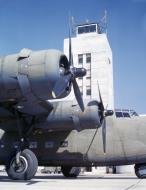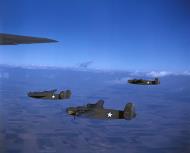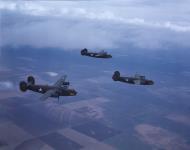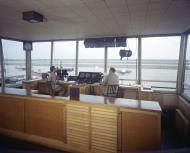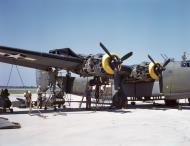Consolidated B-24 Liberator historical slideshow
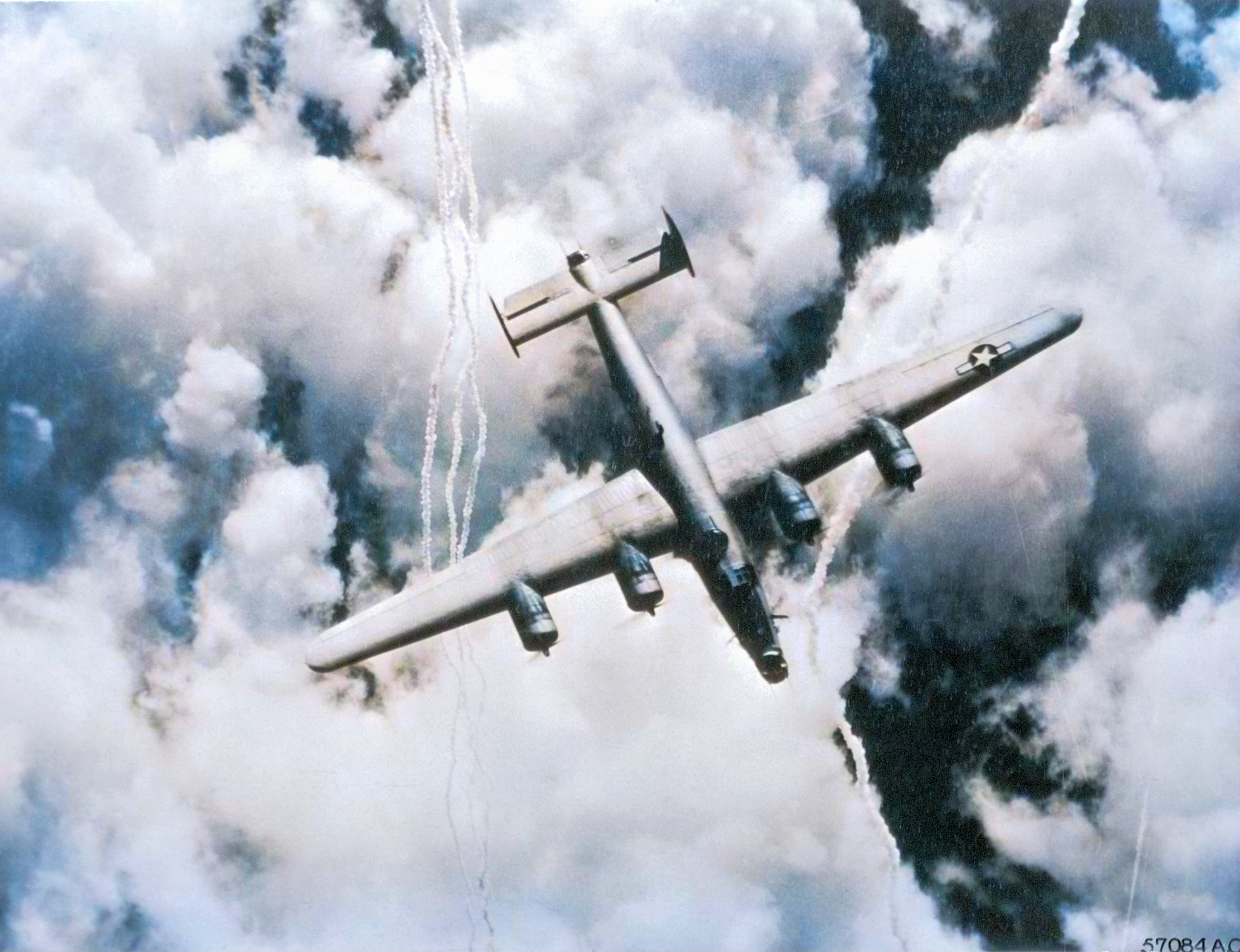




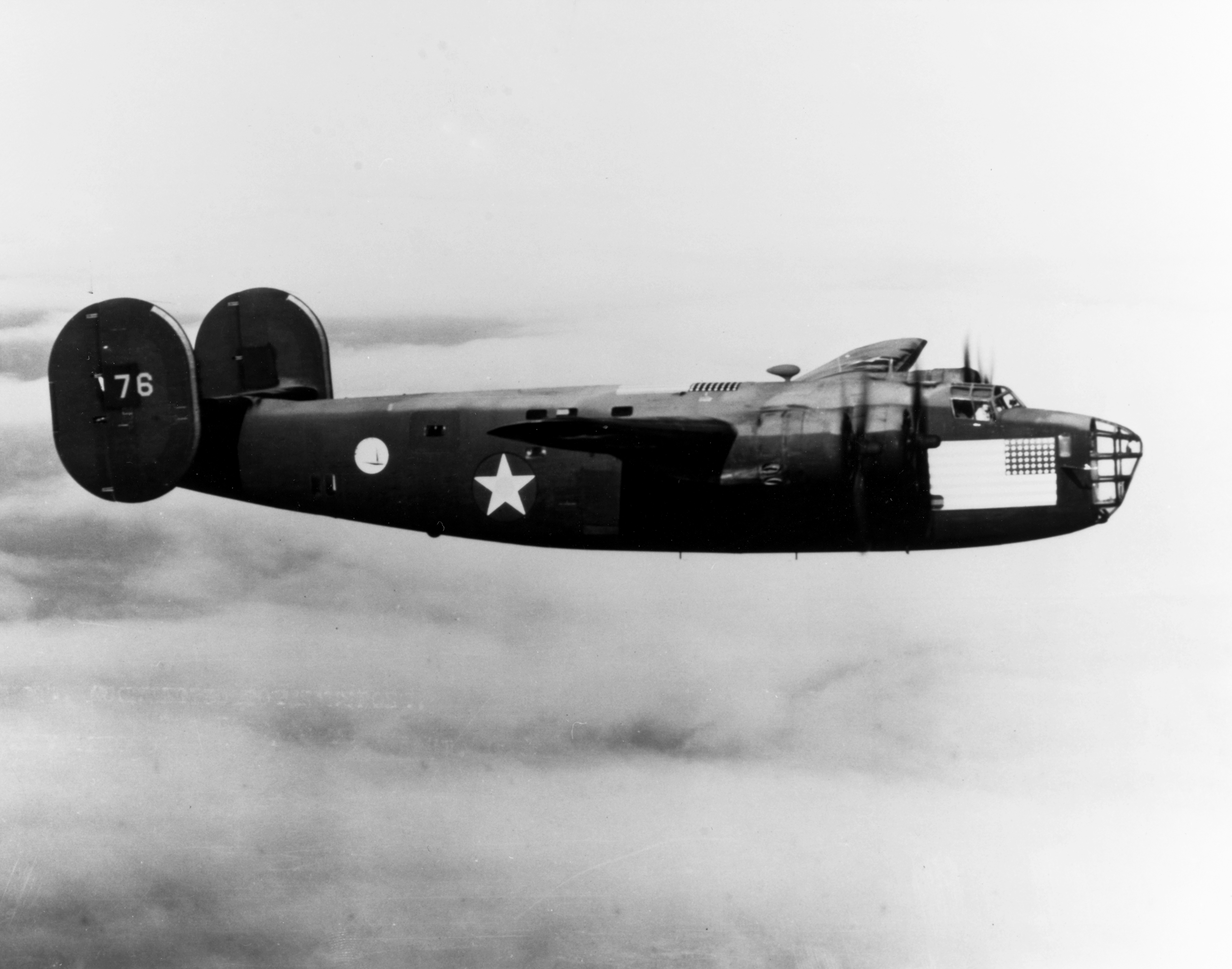
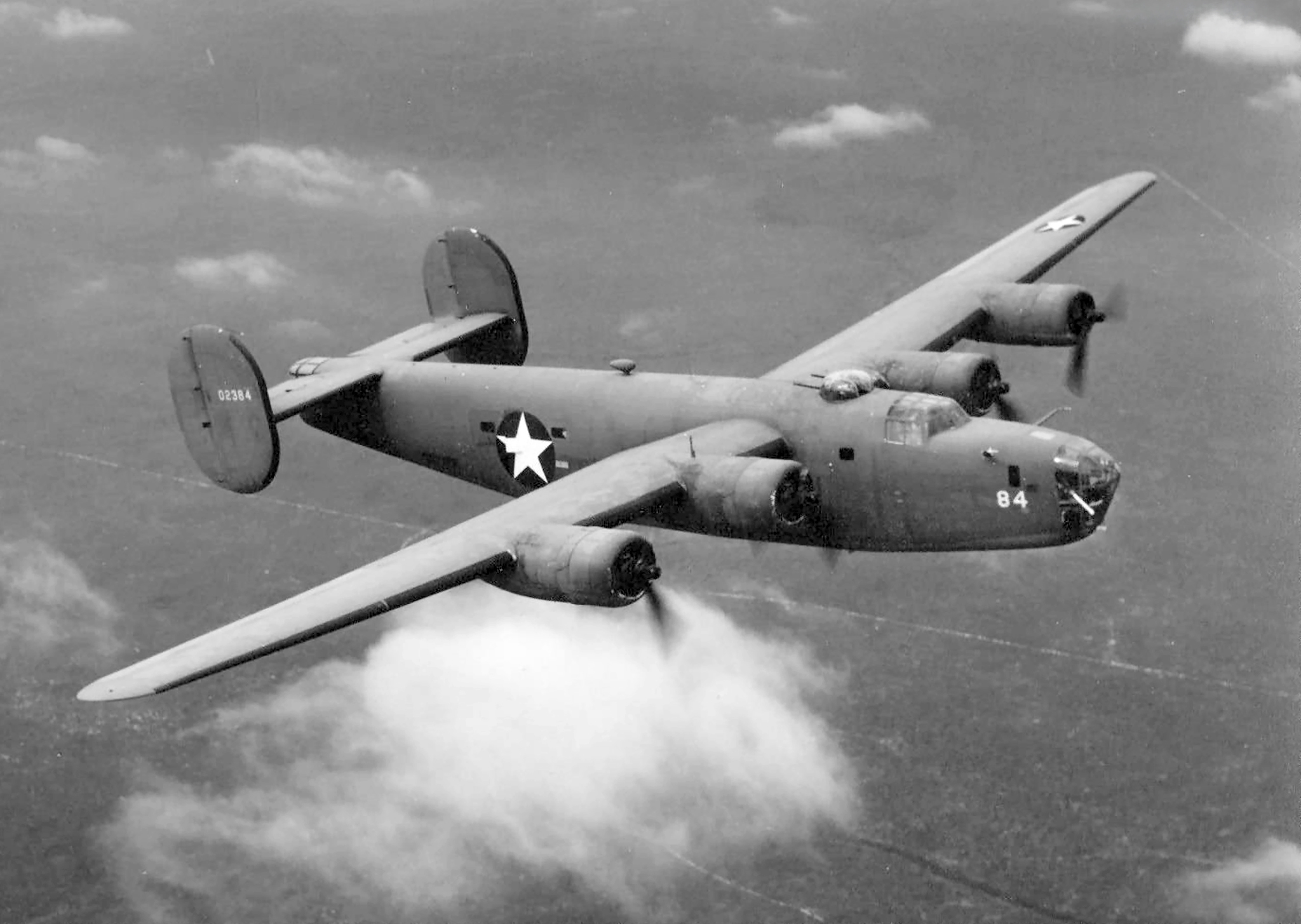
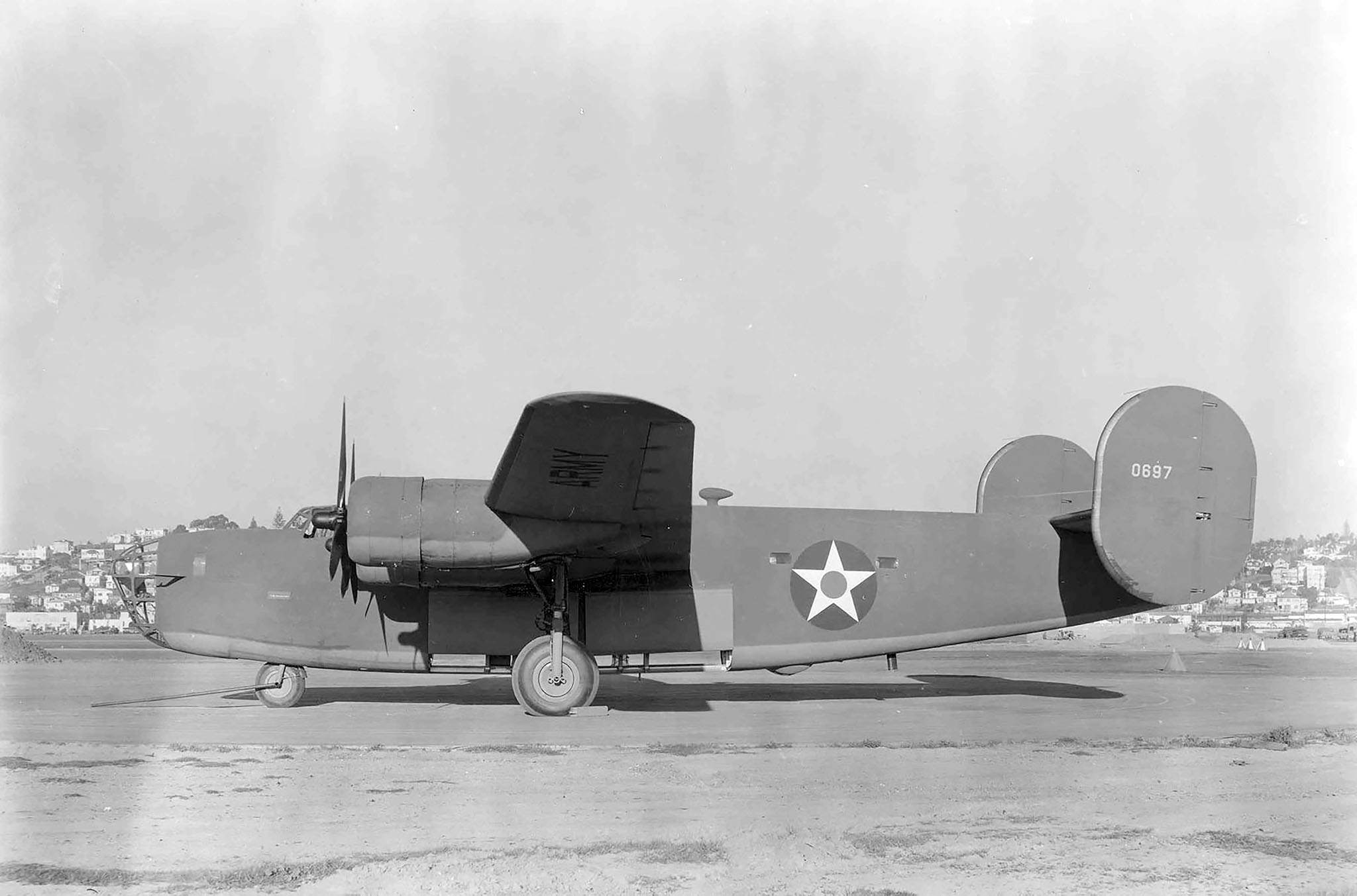
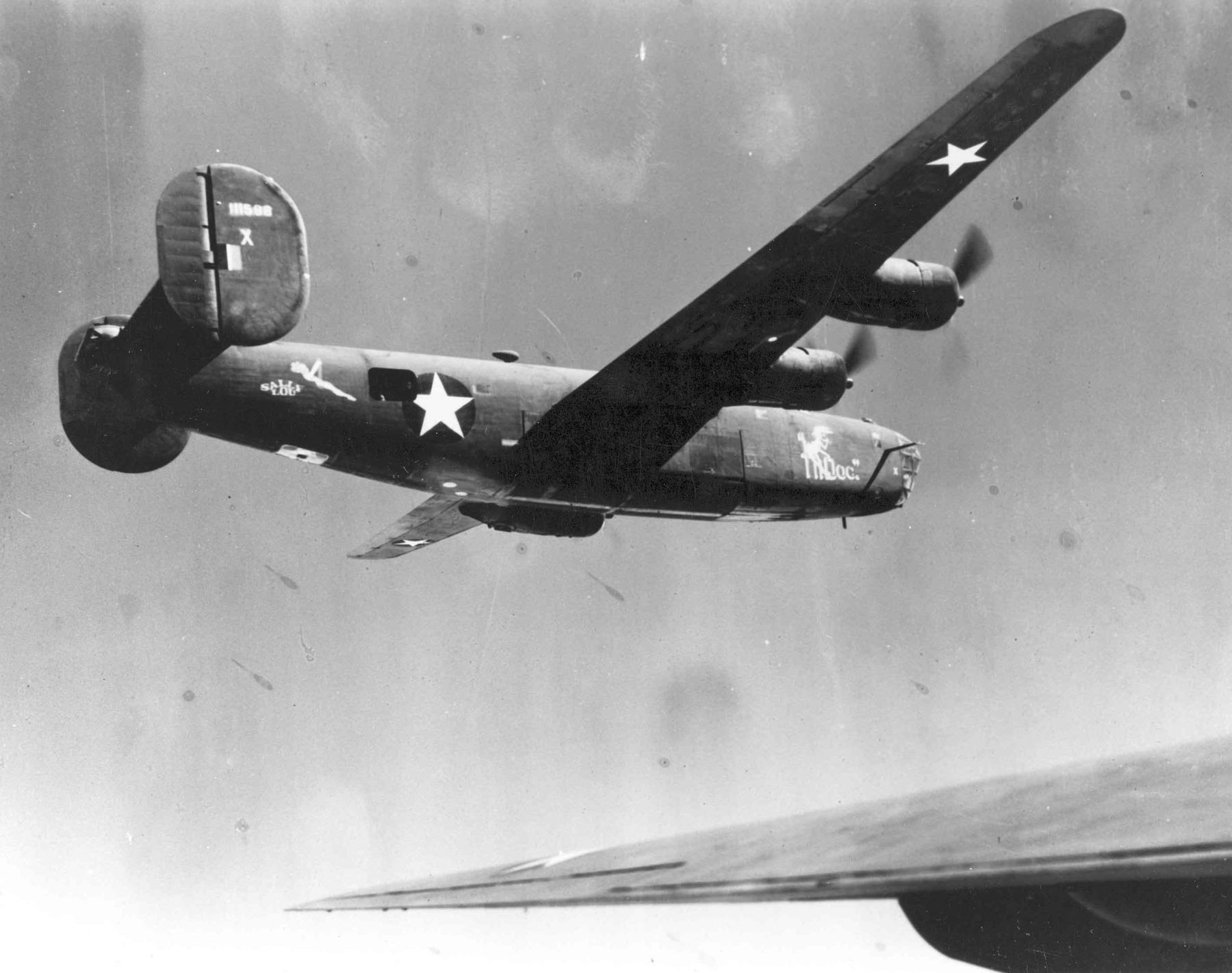



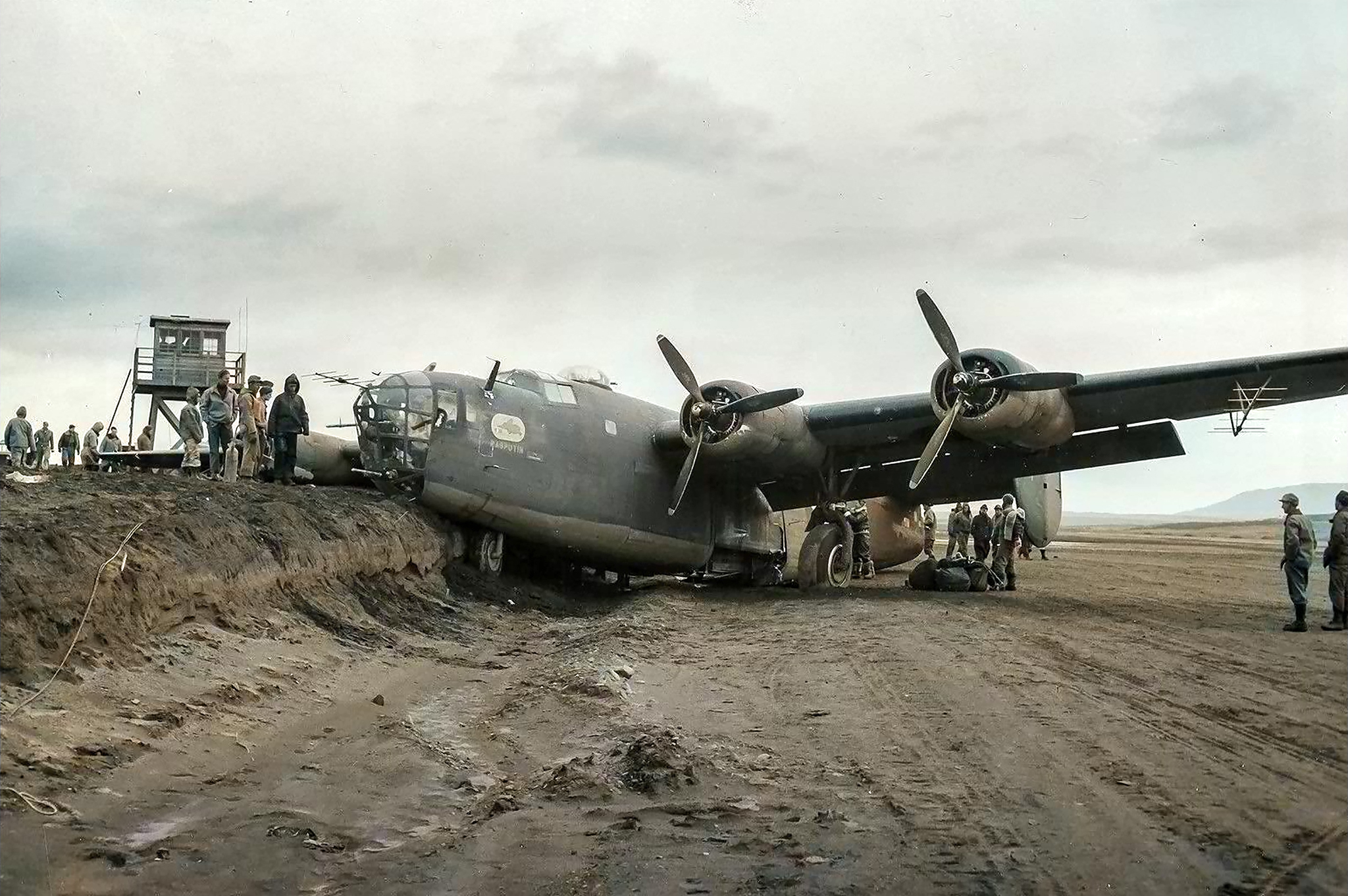
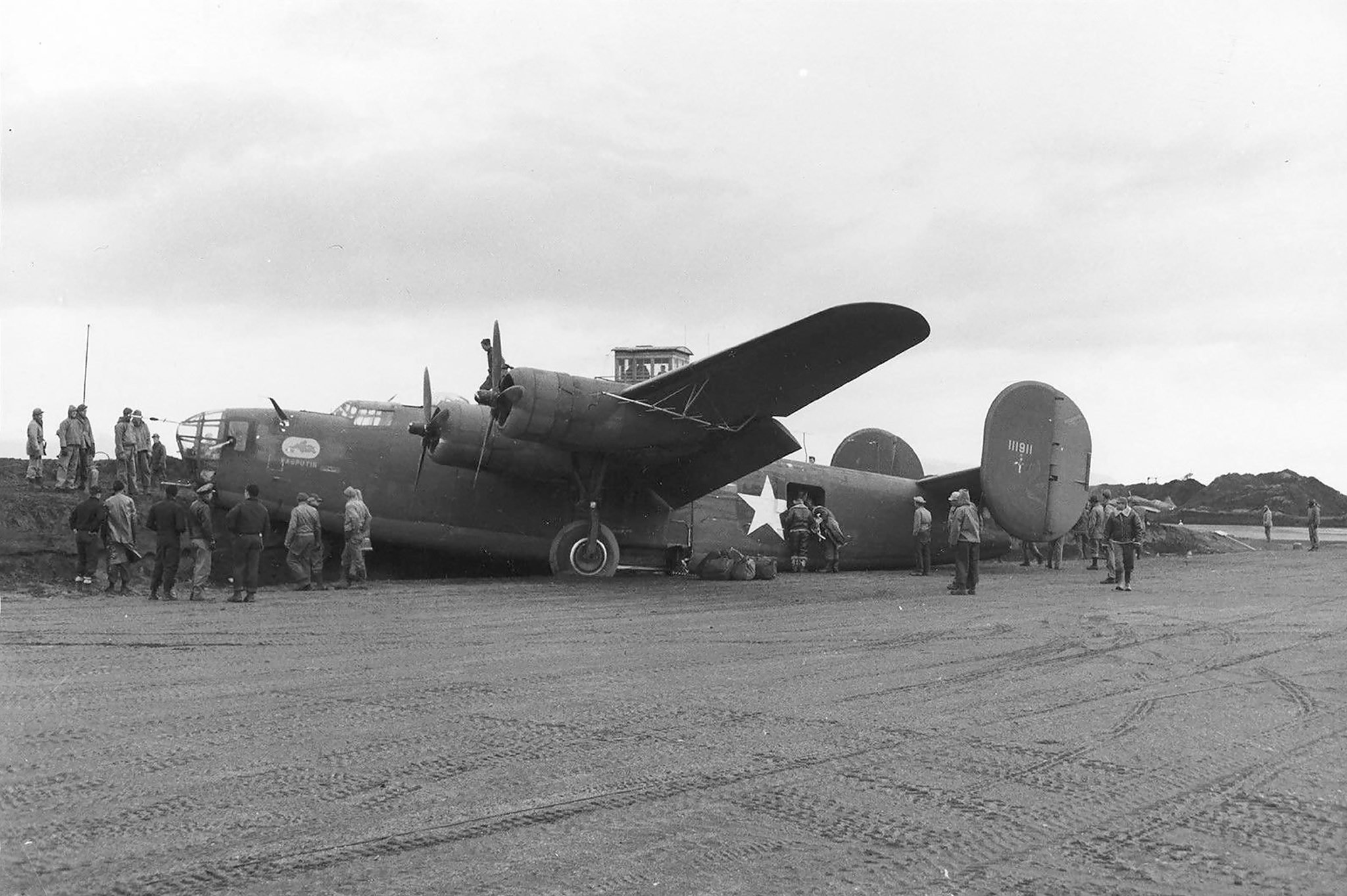
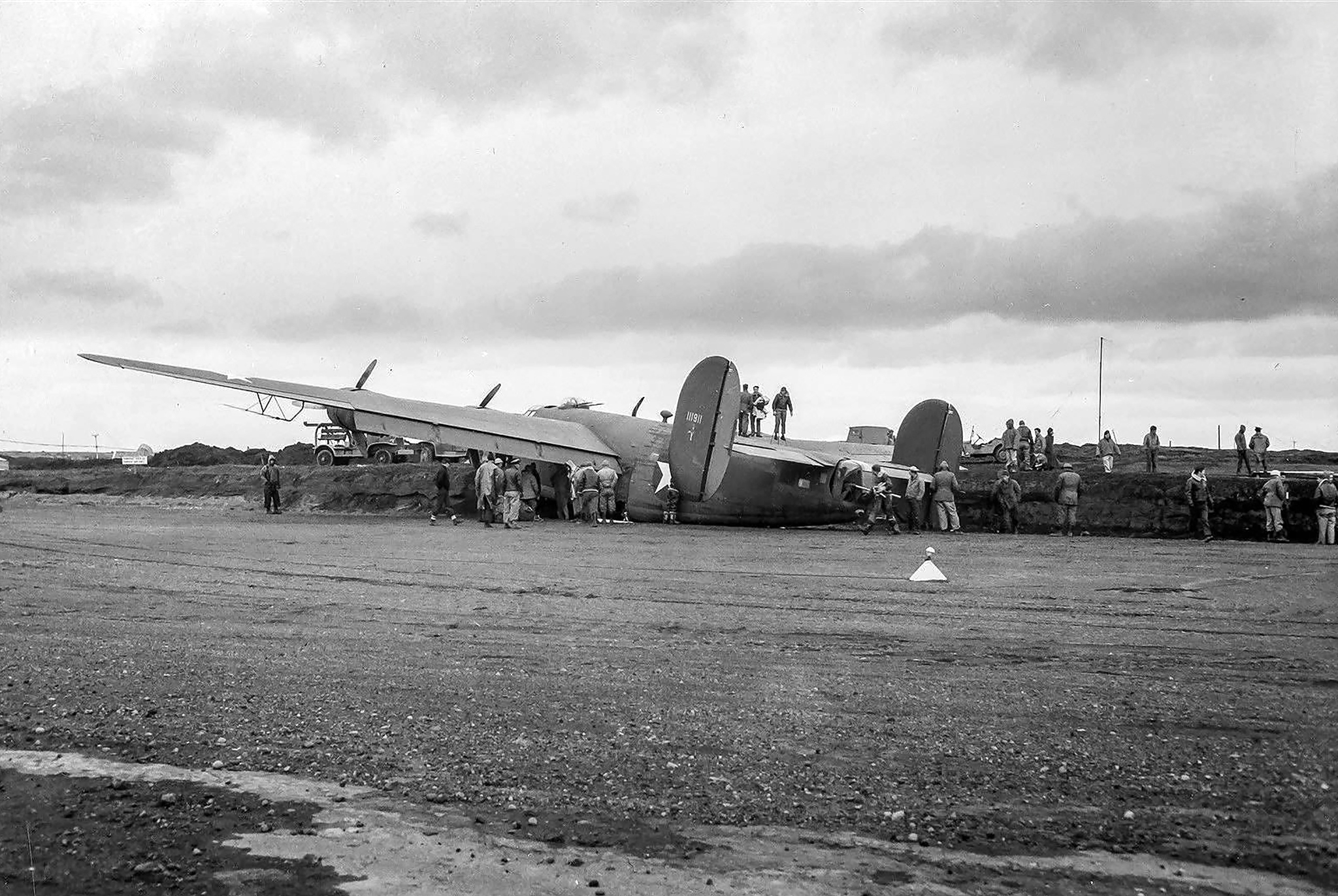

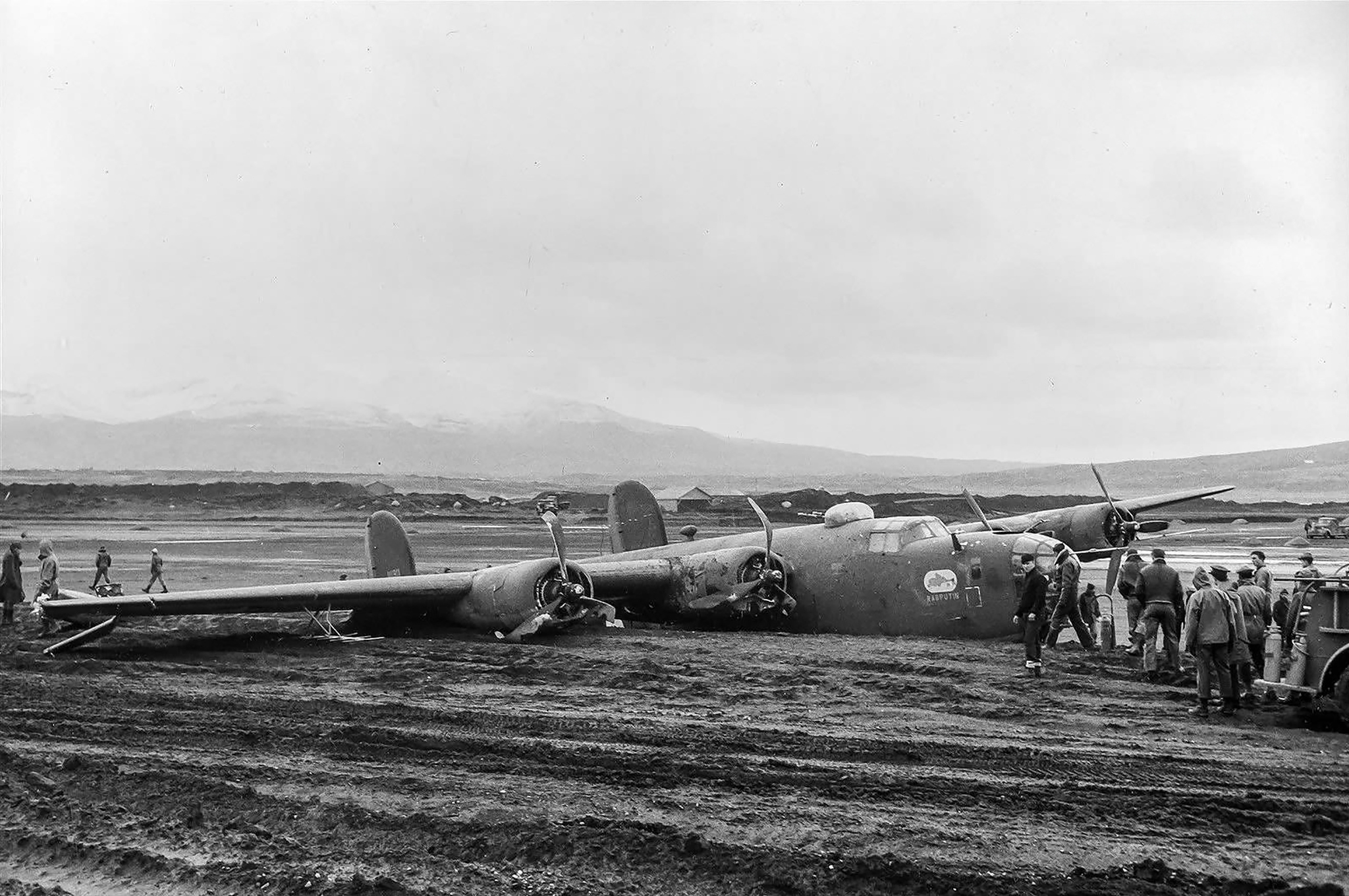
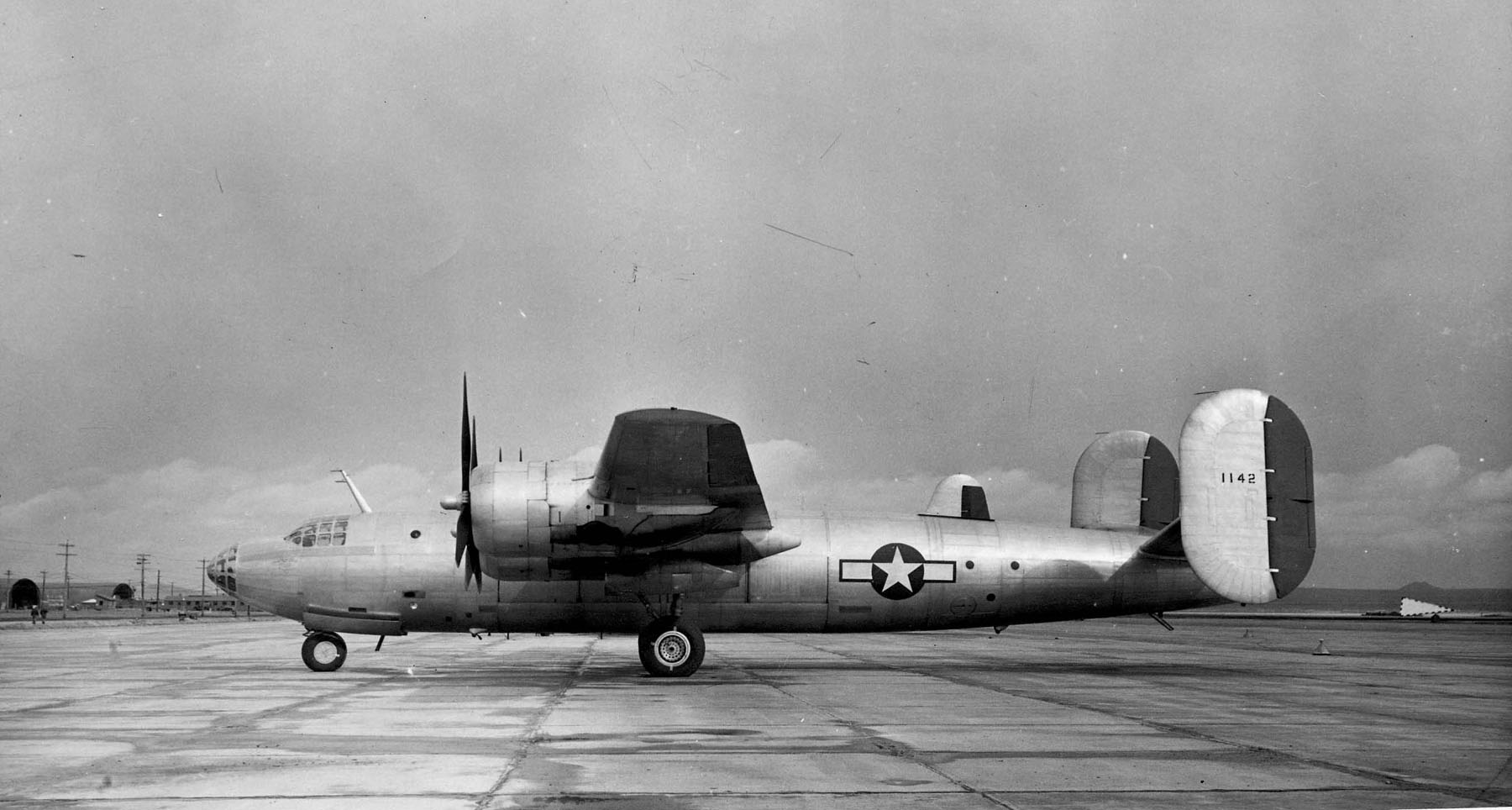
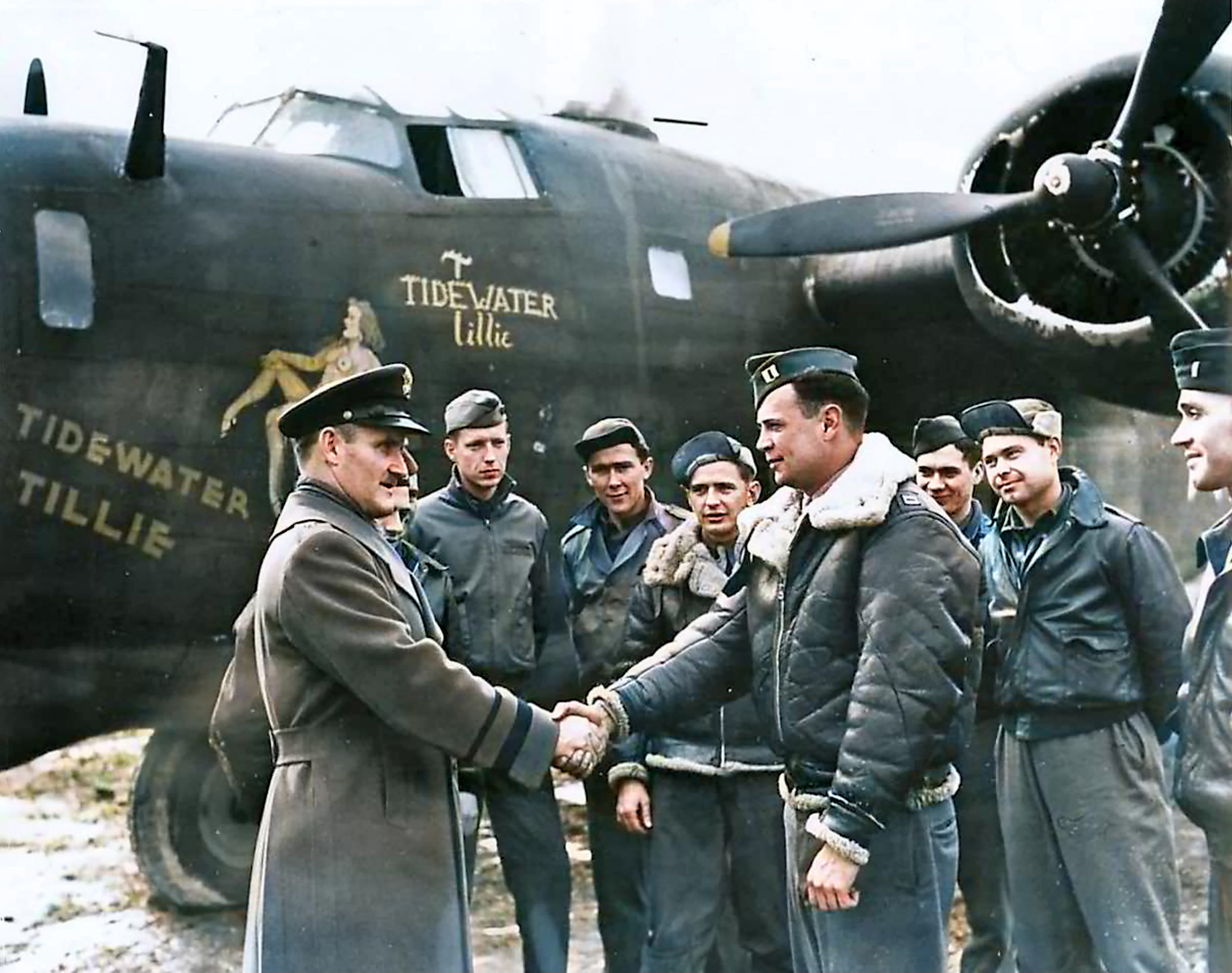

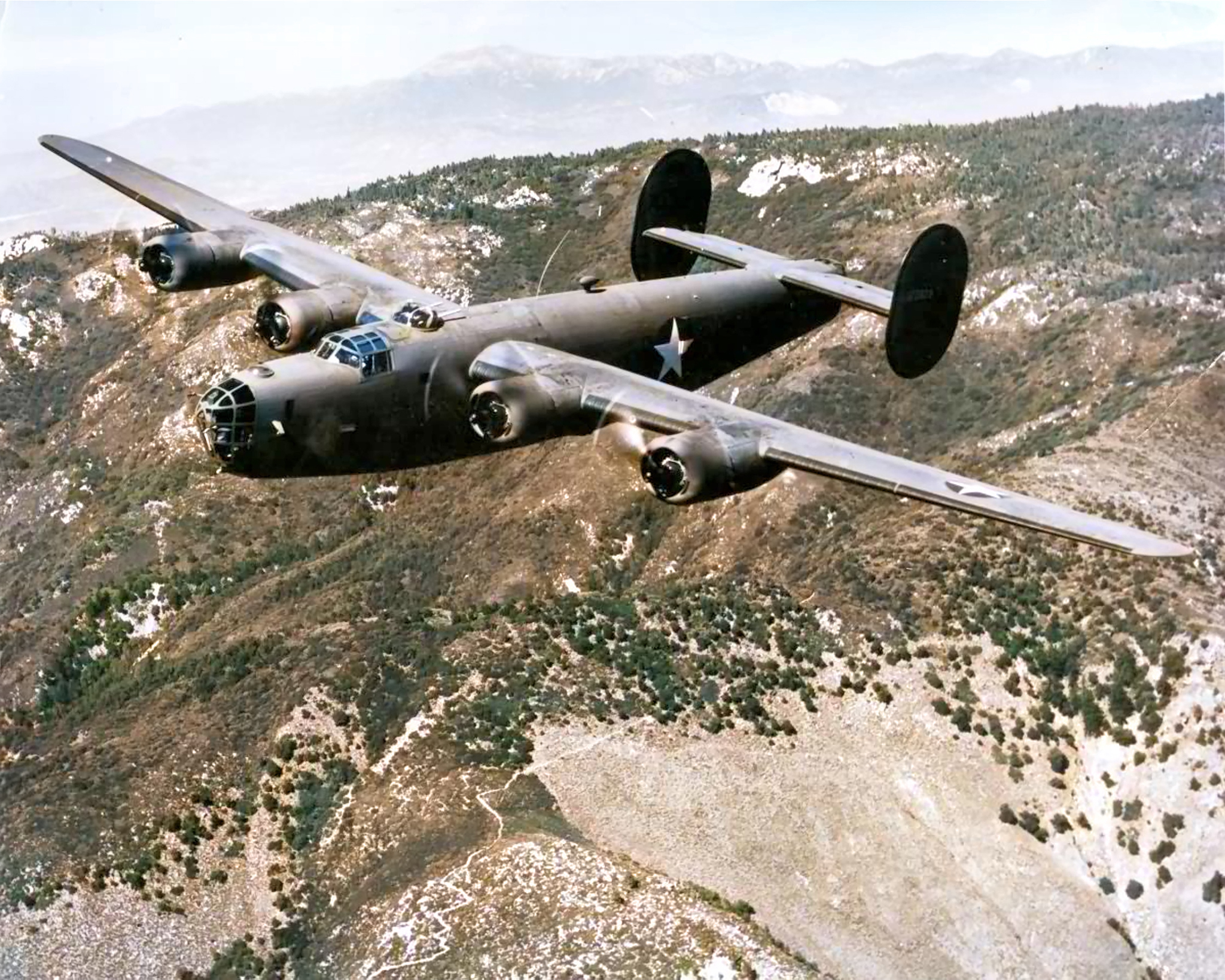



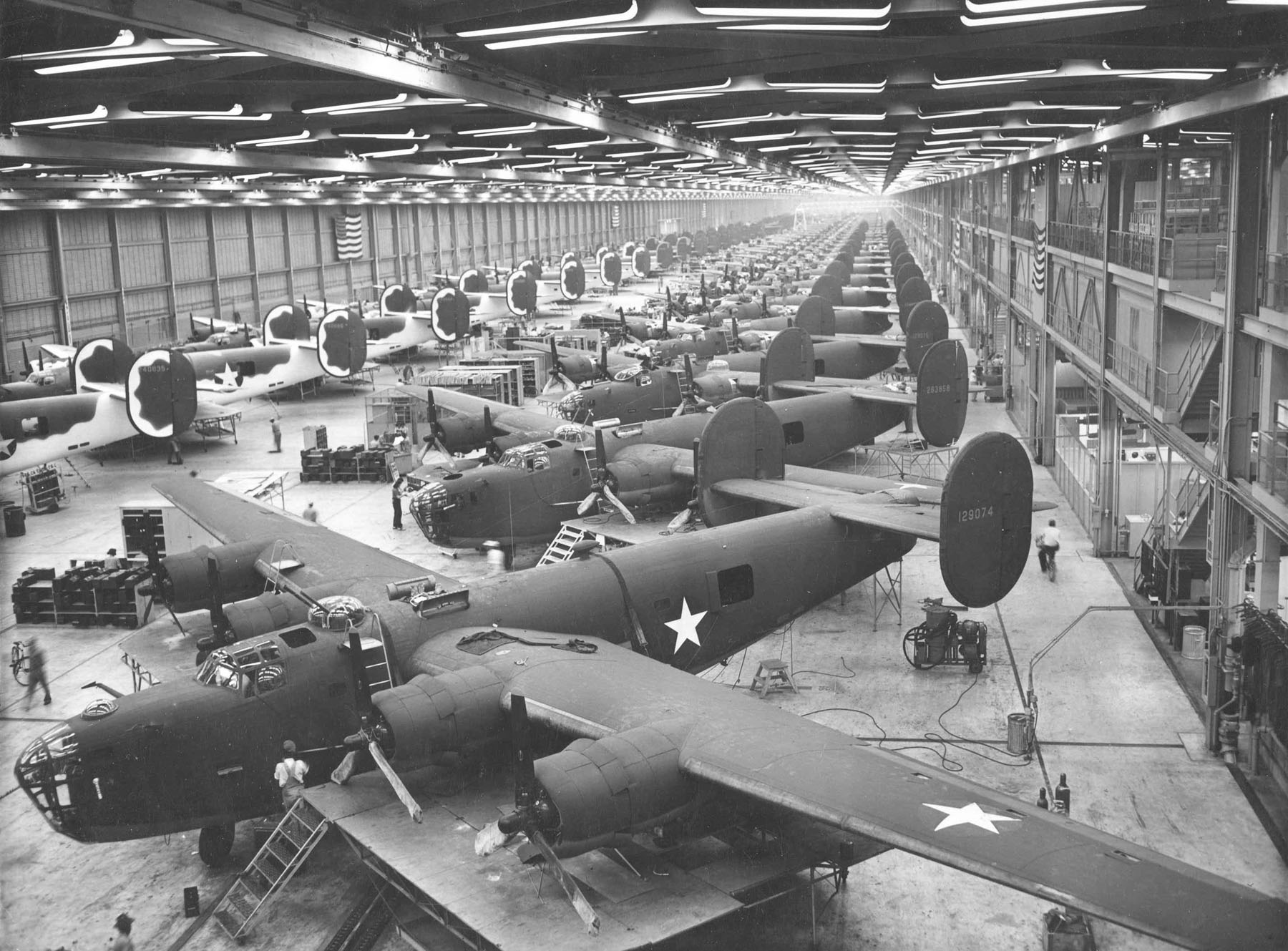
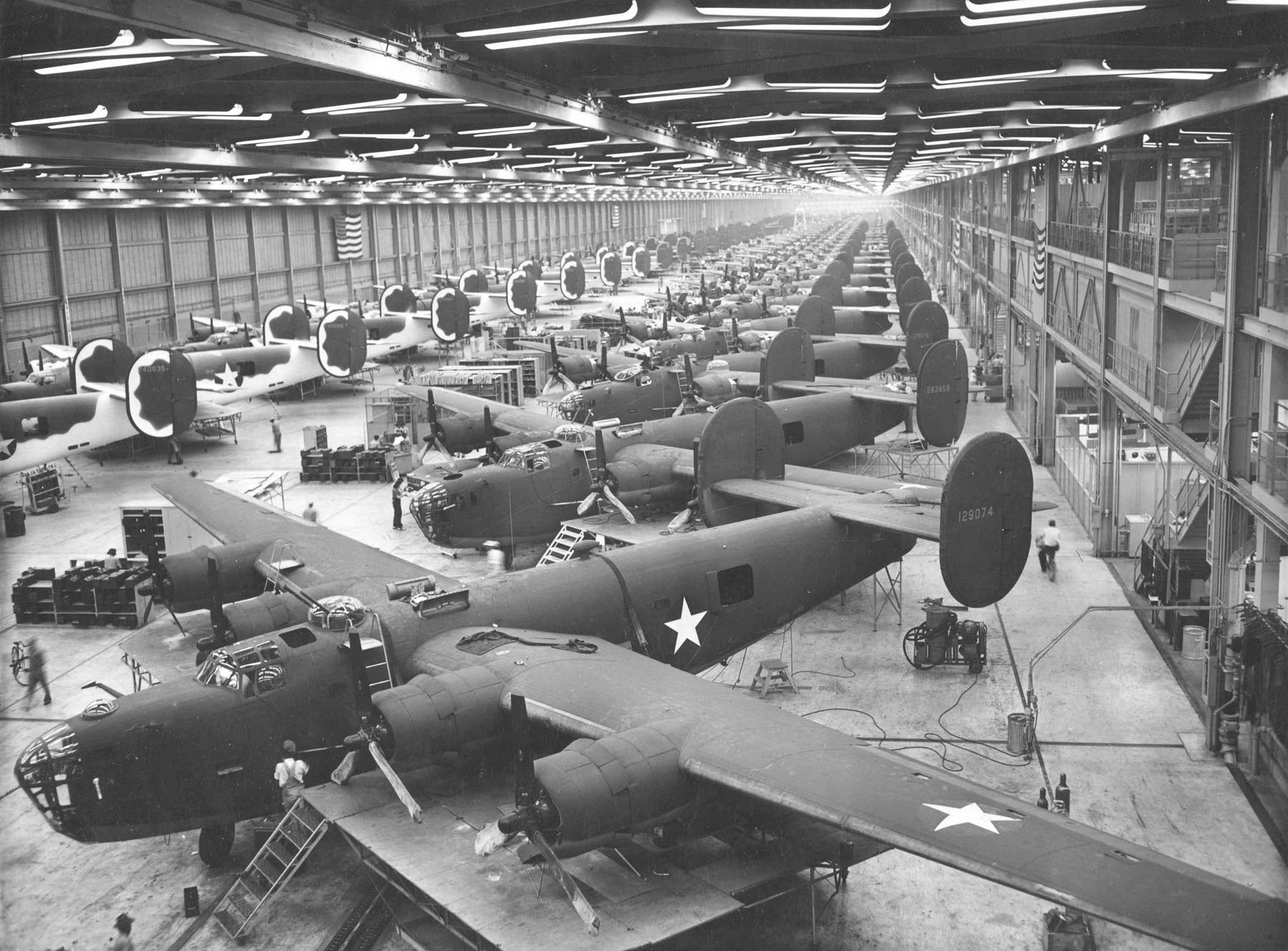
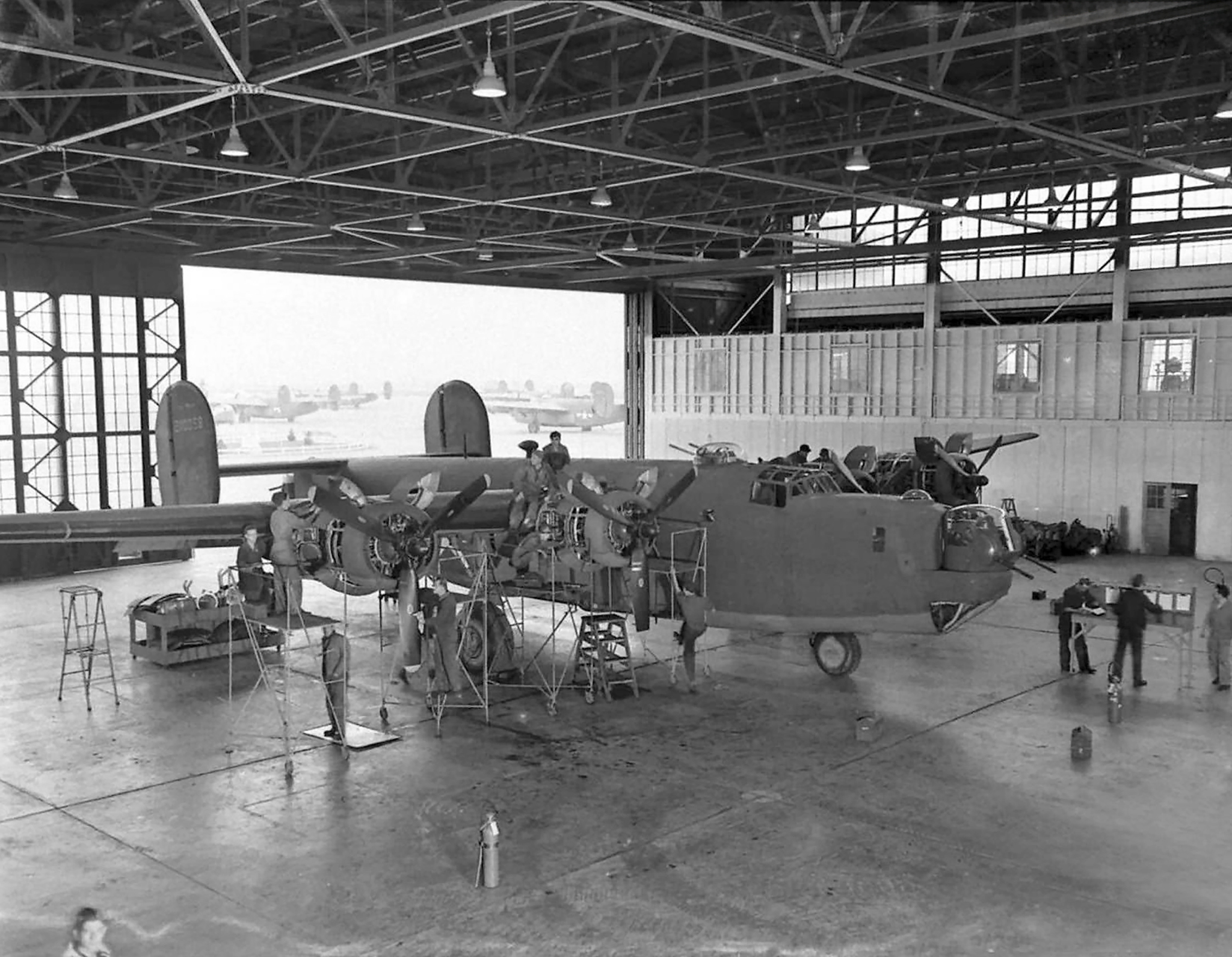
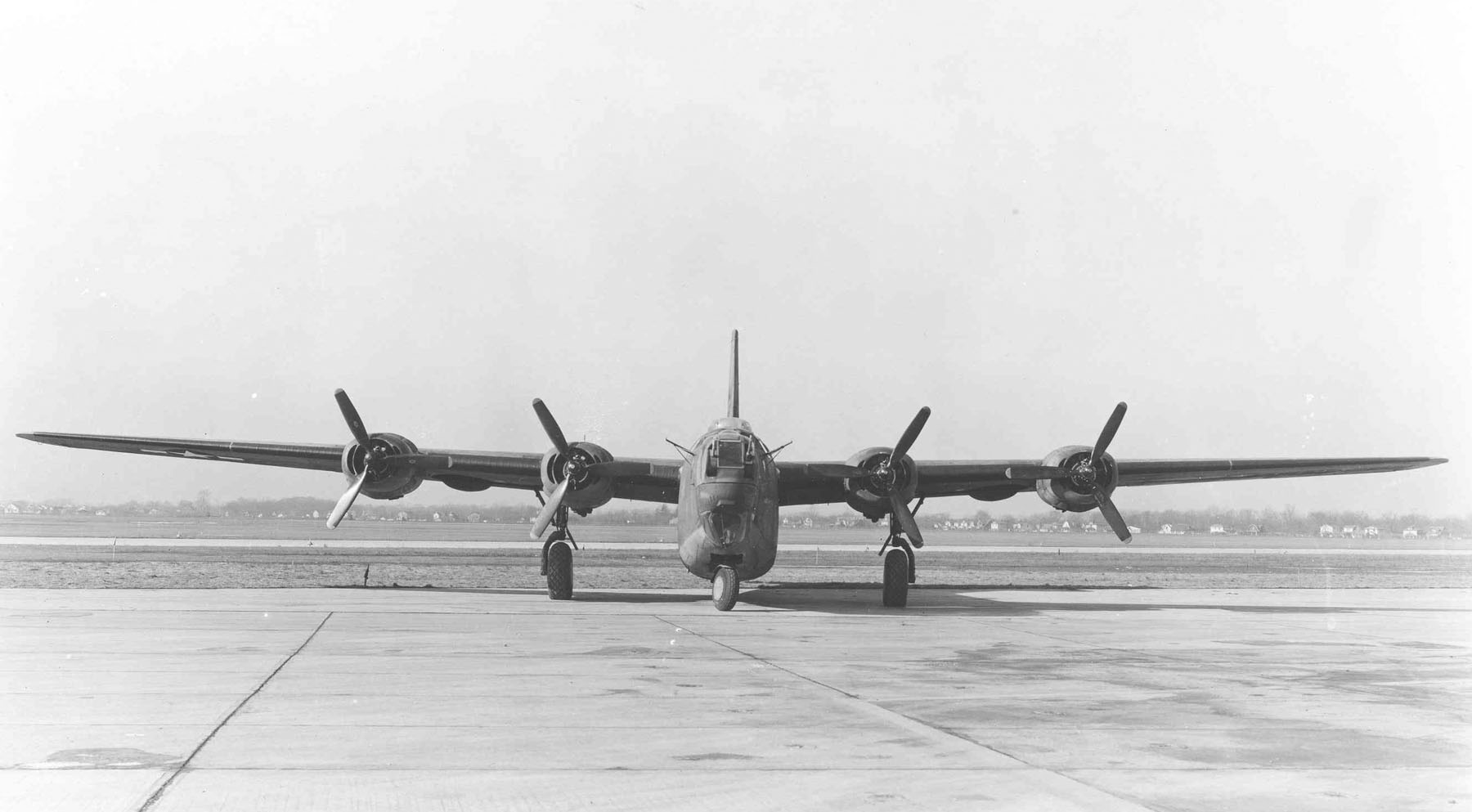
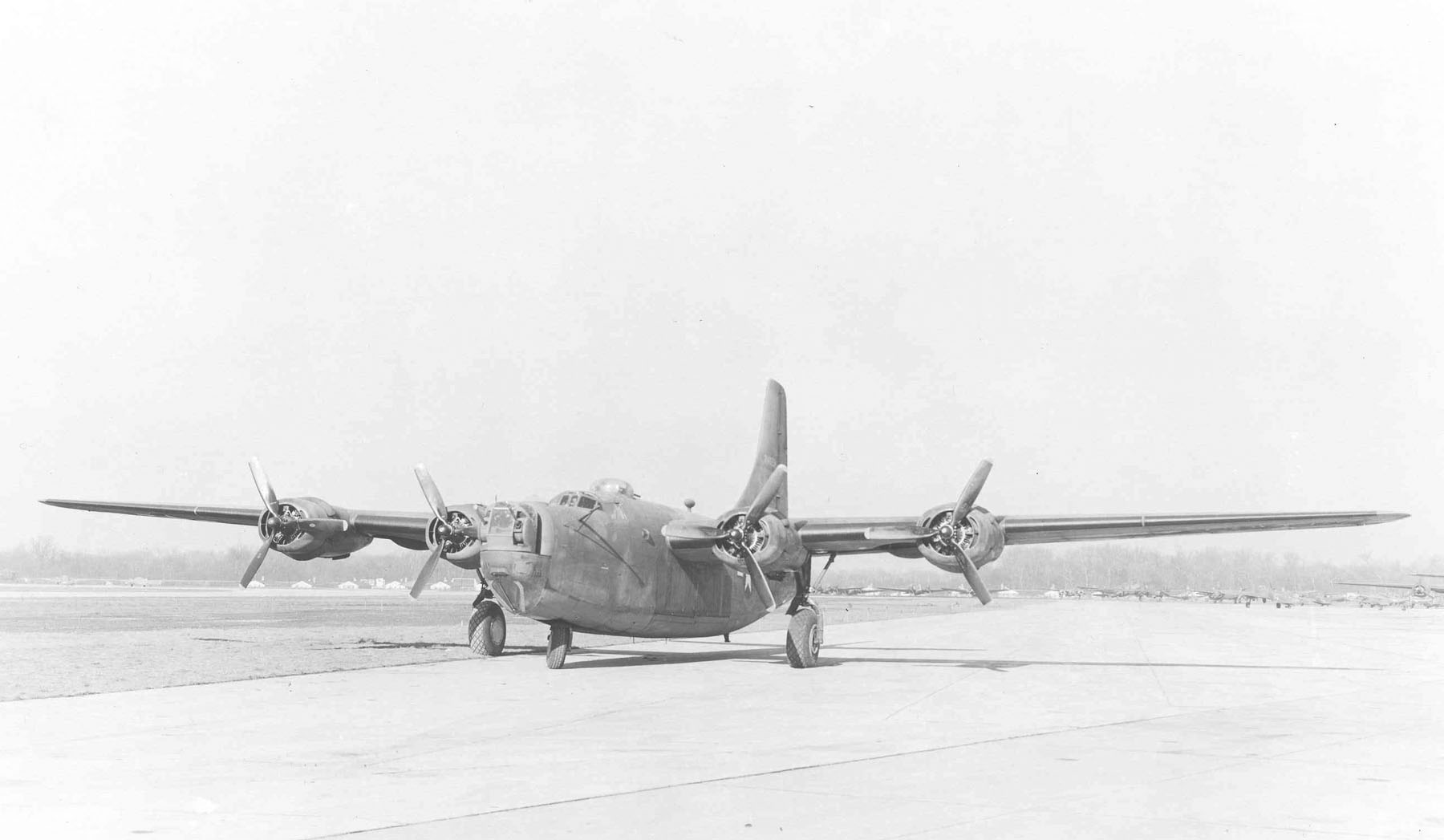
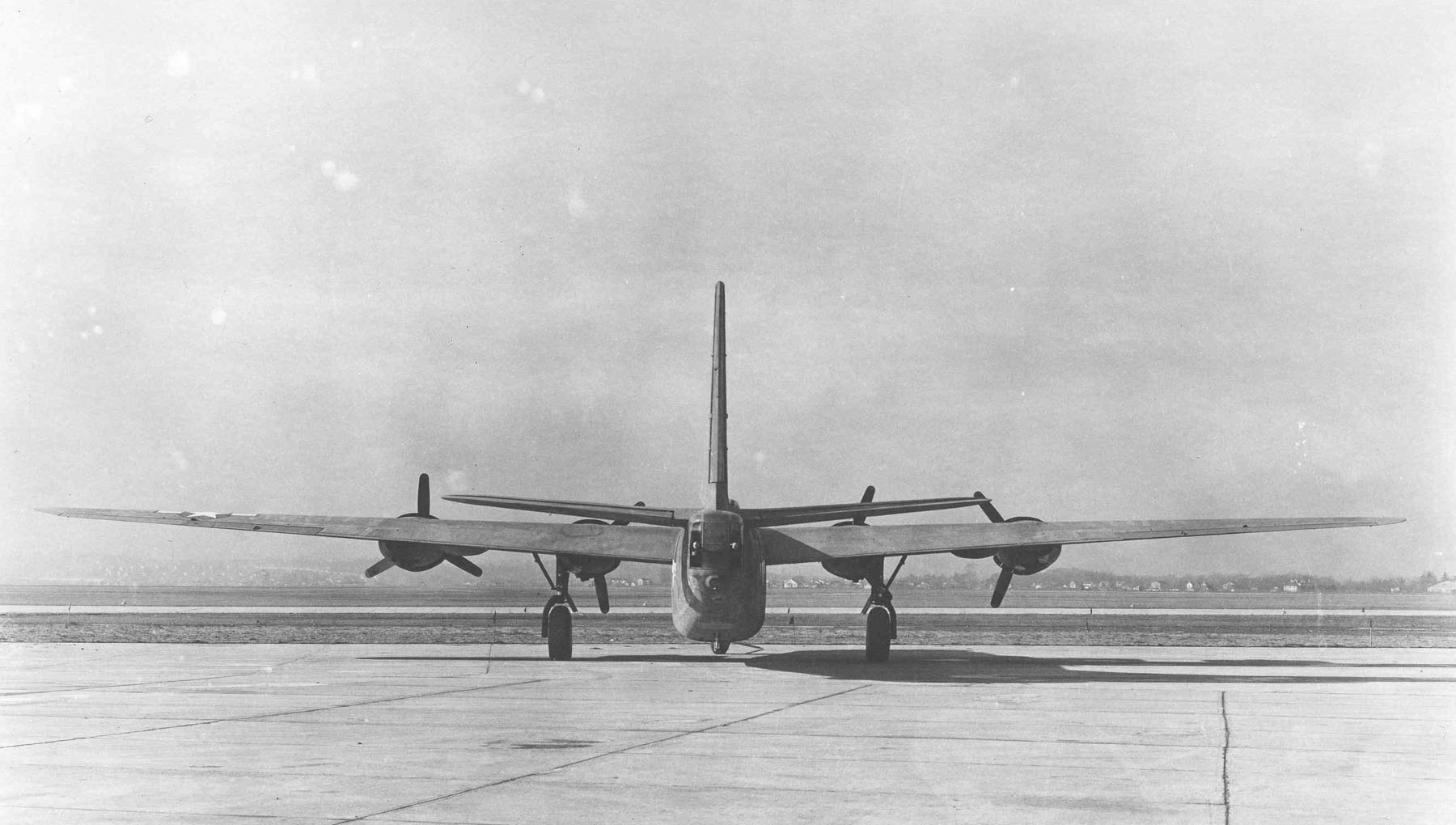

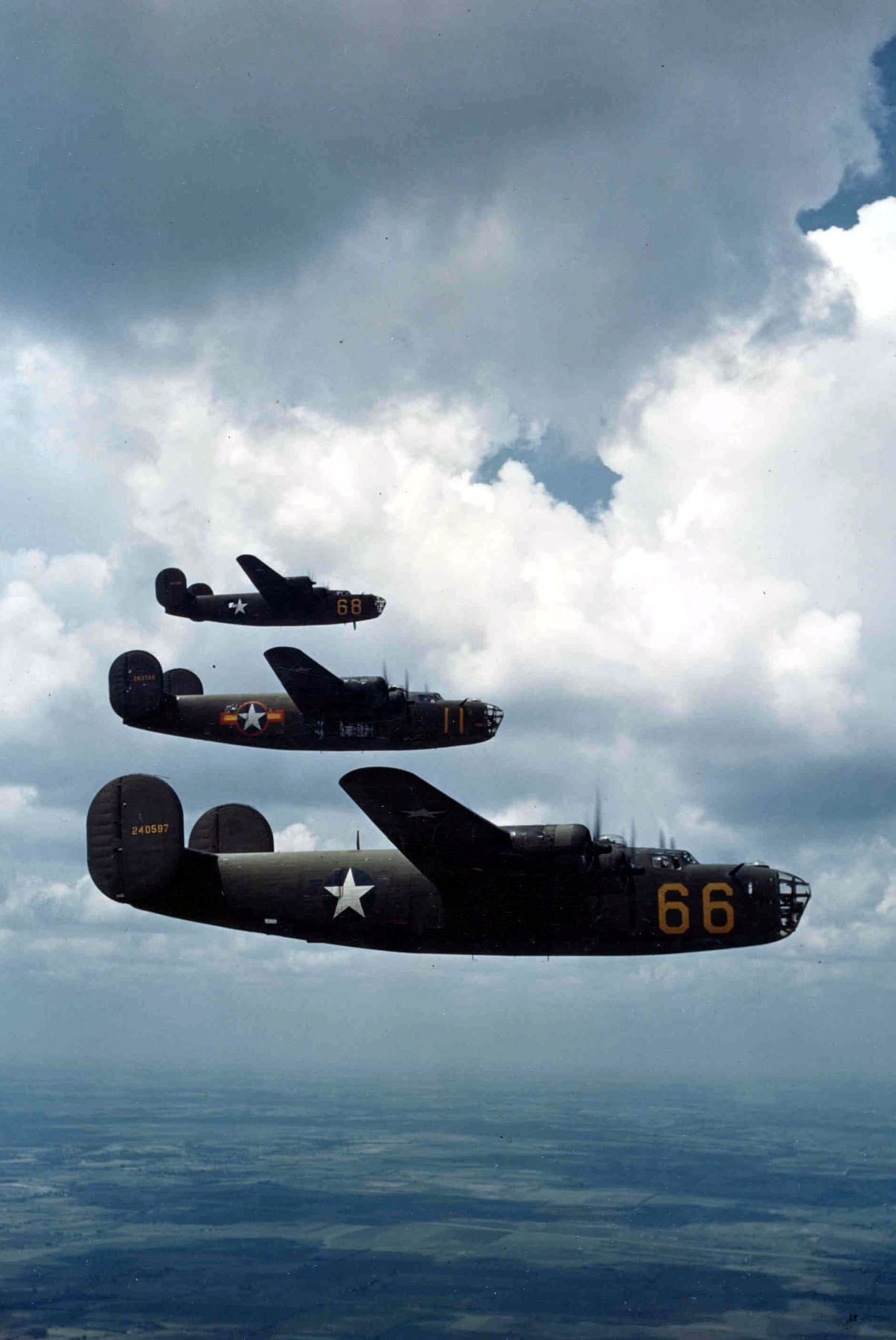
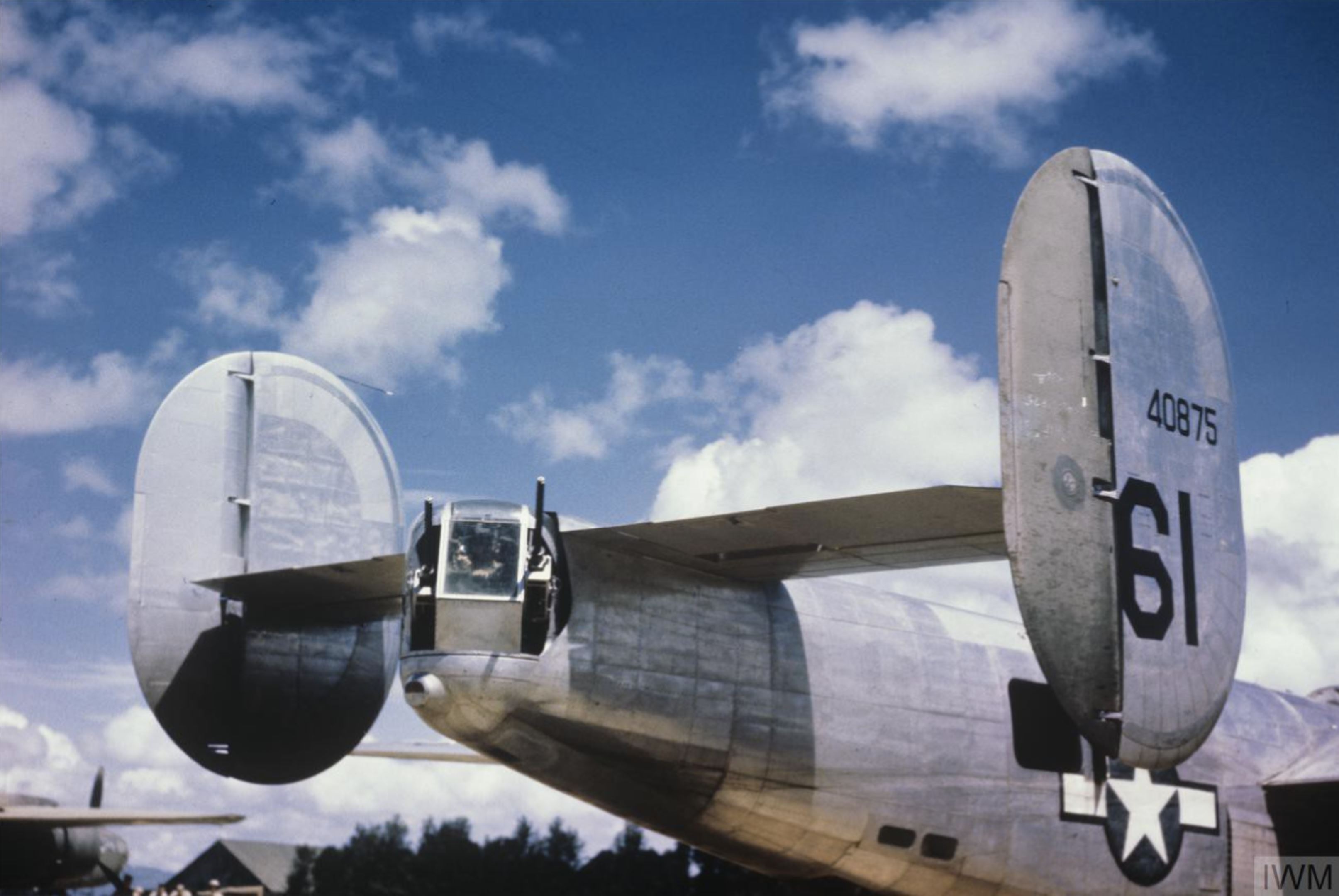


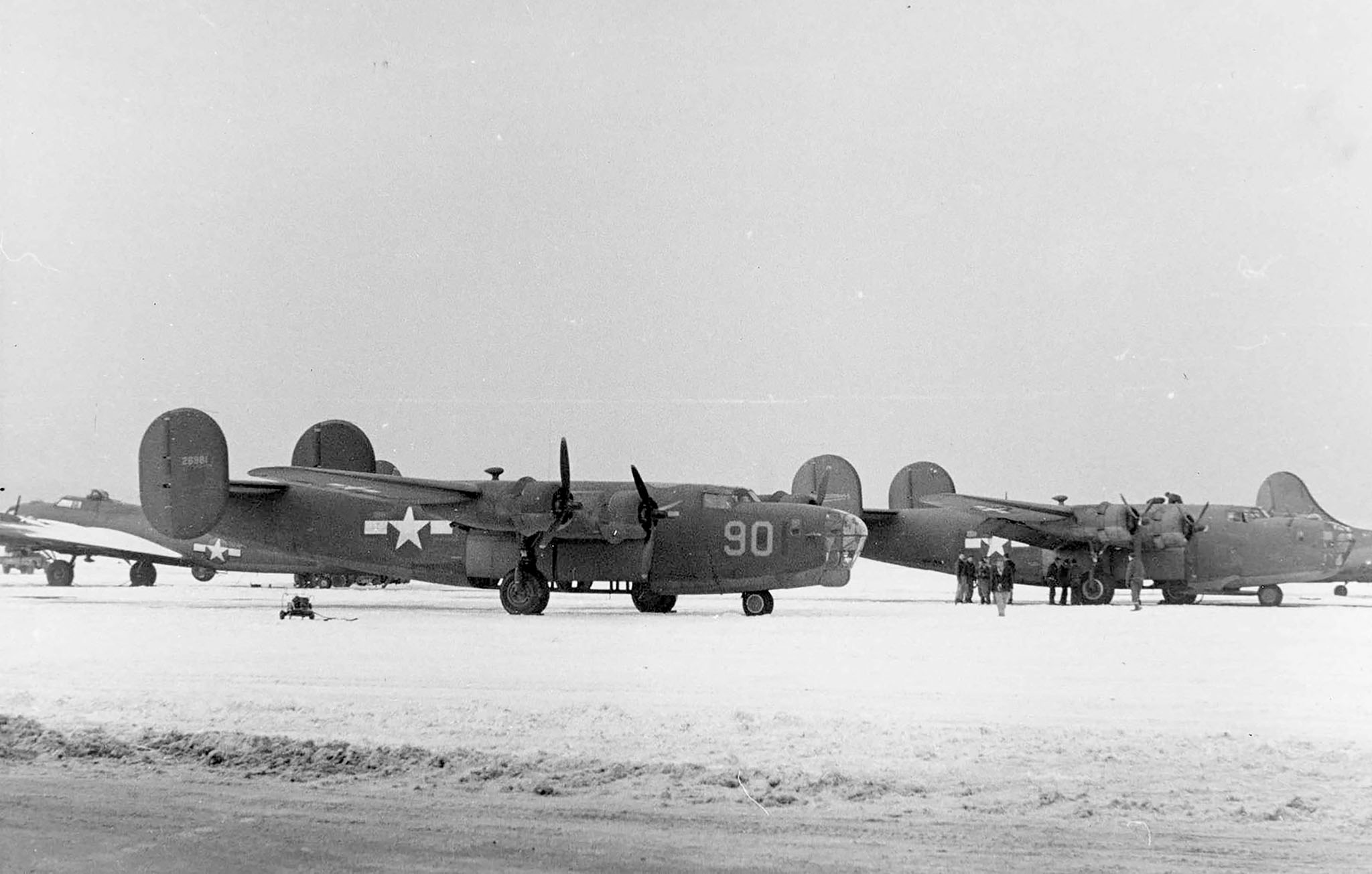
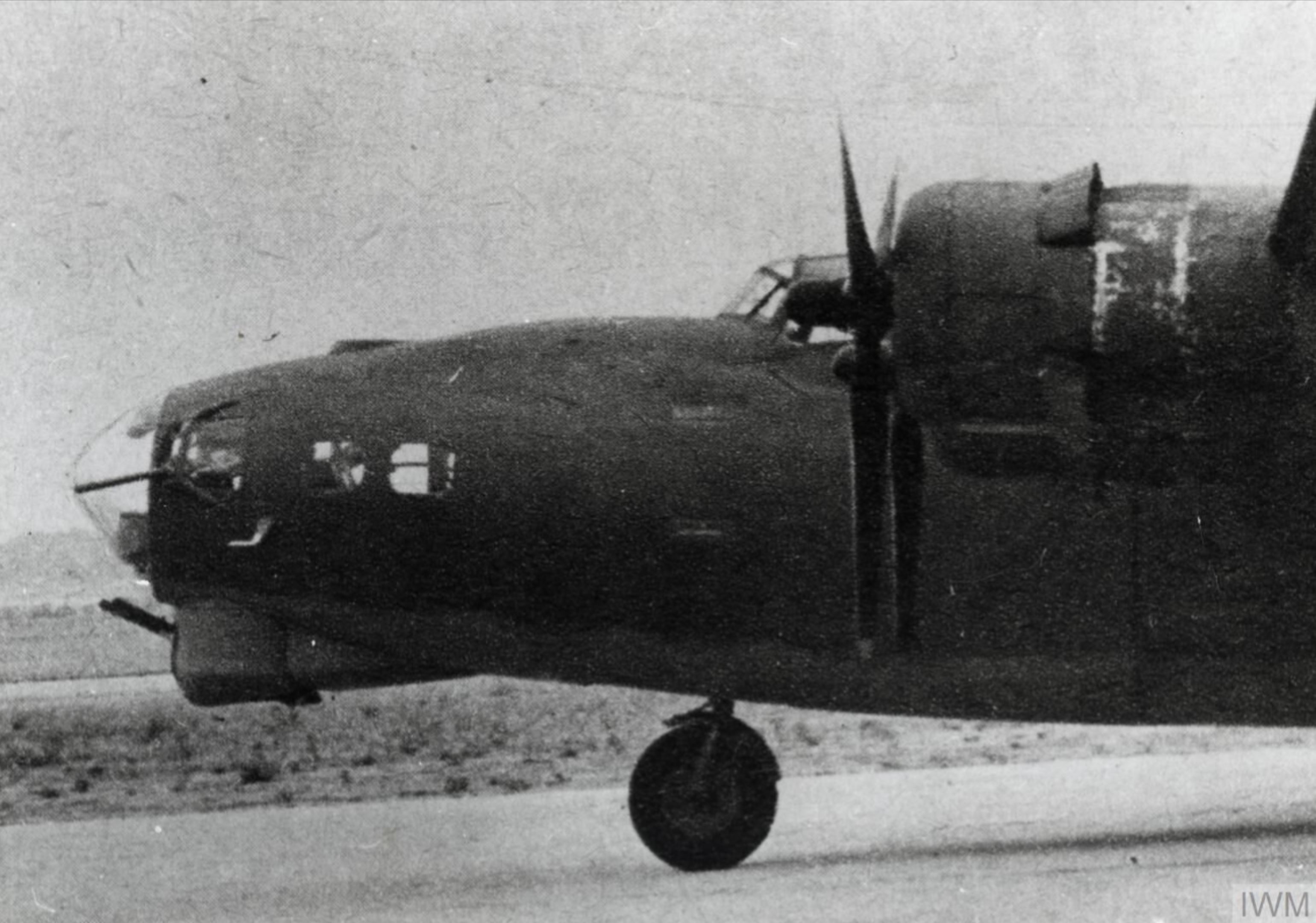
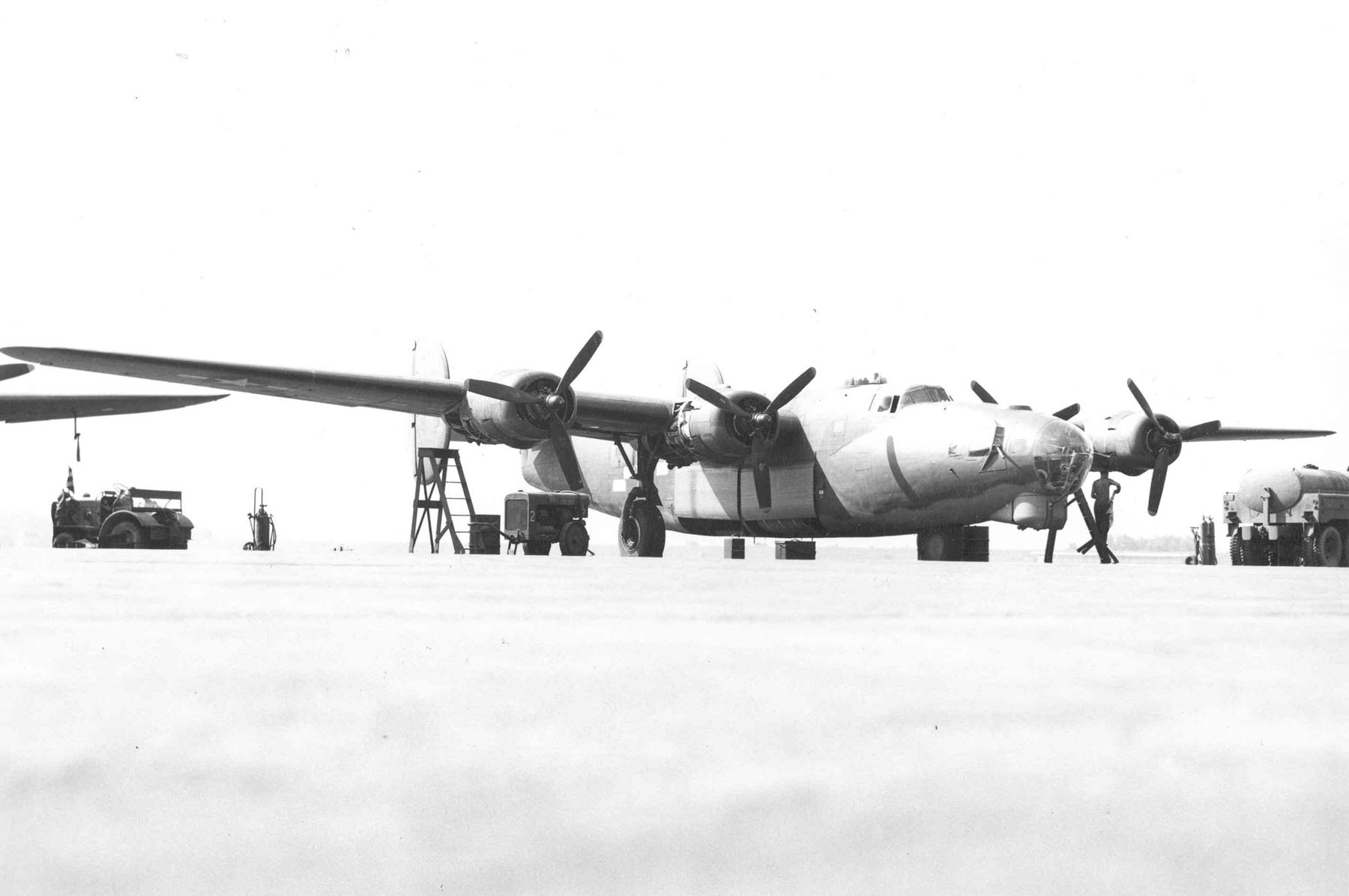
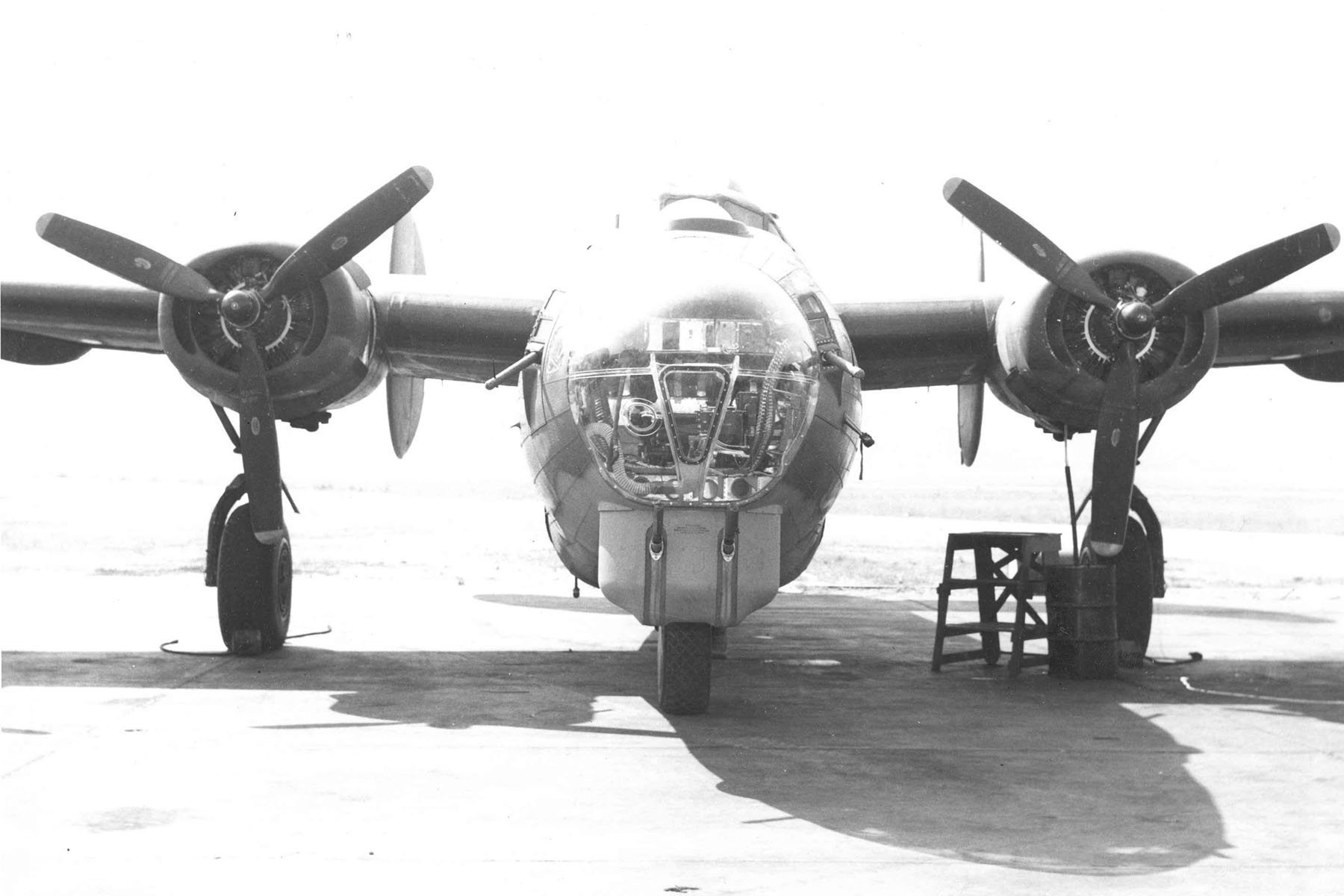
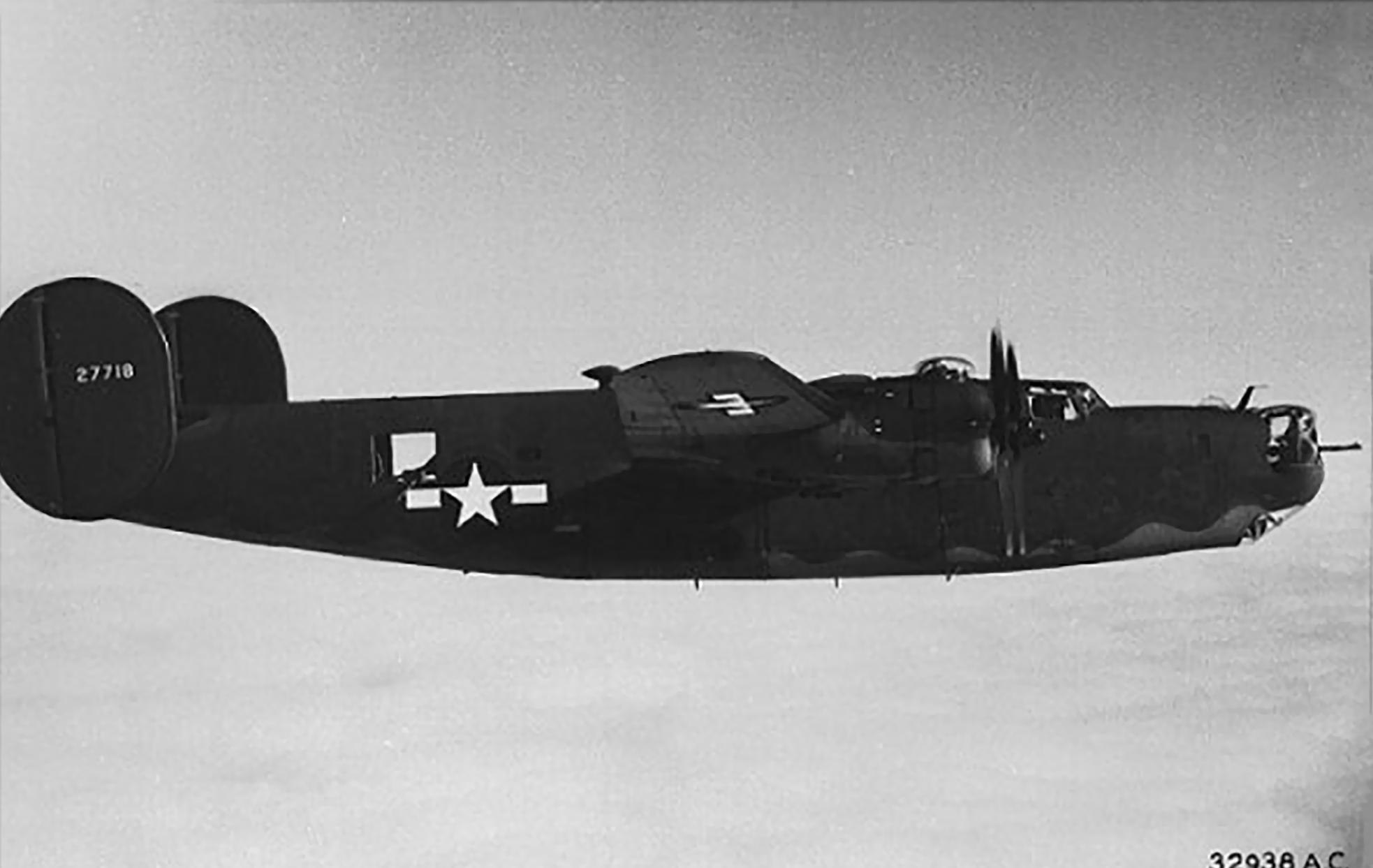
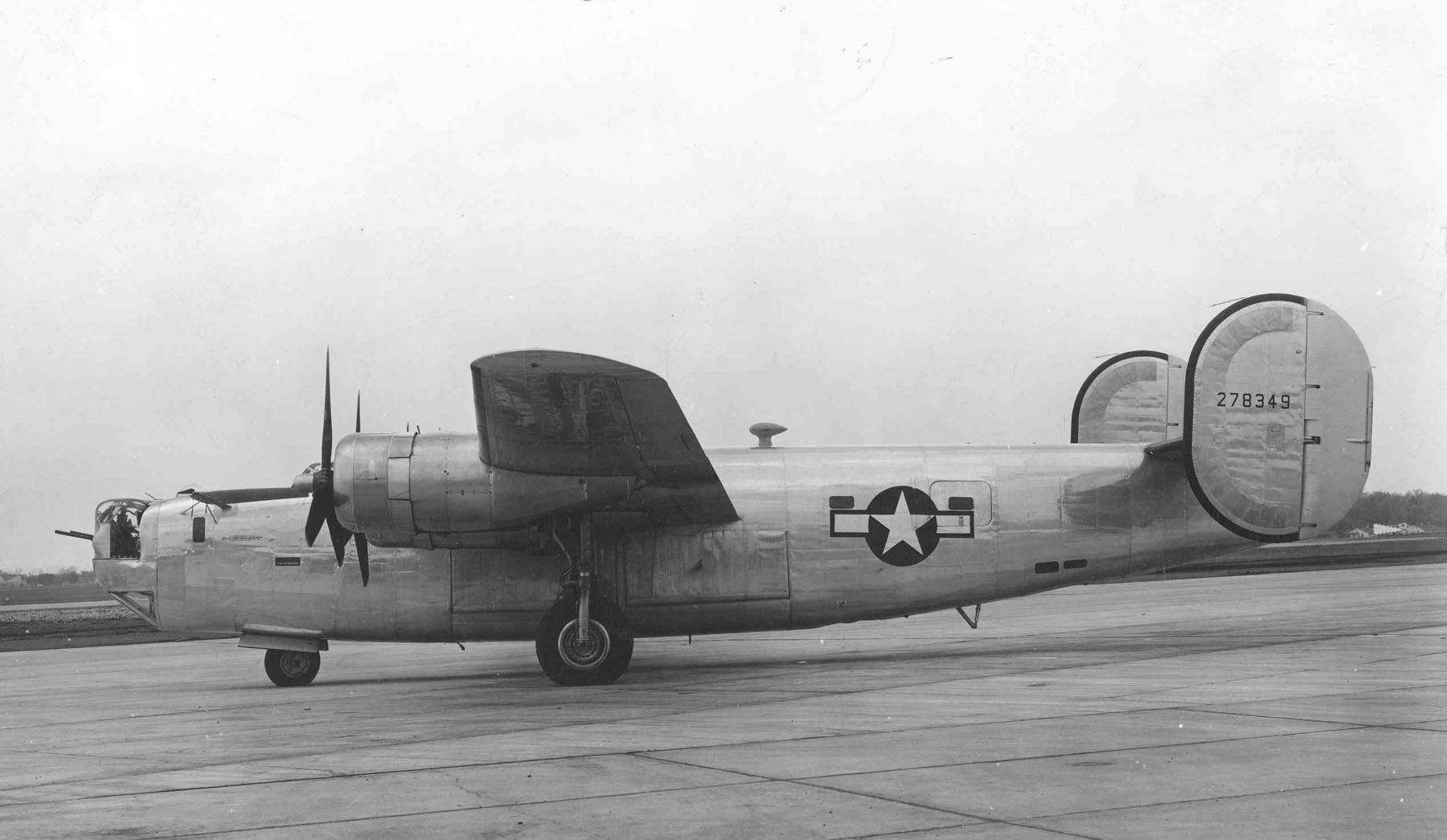
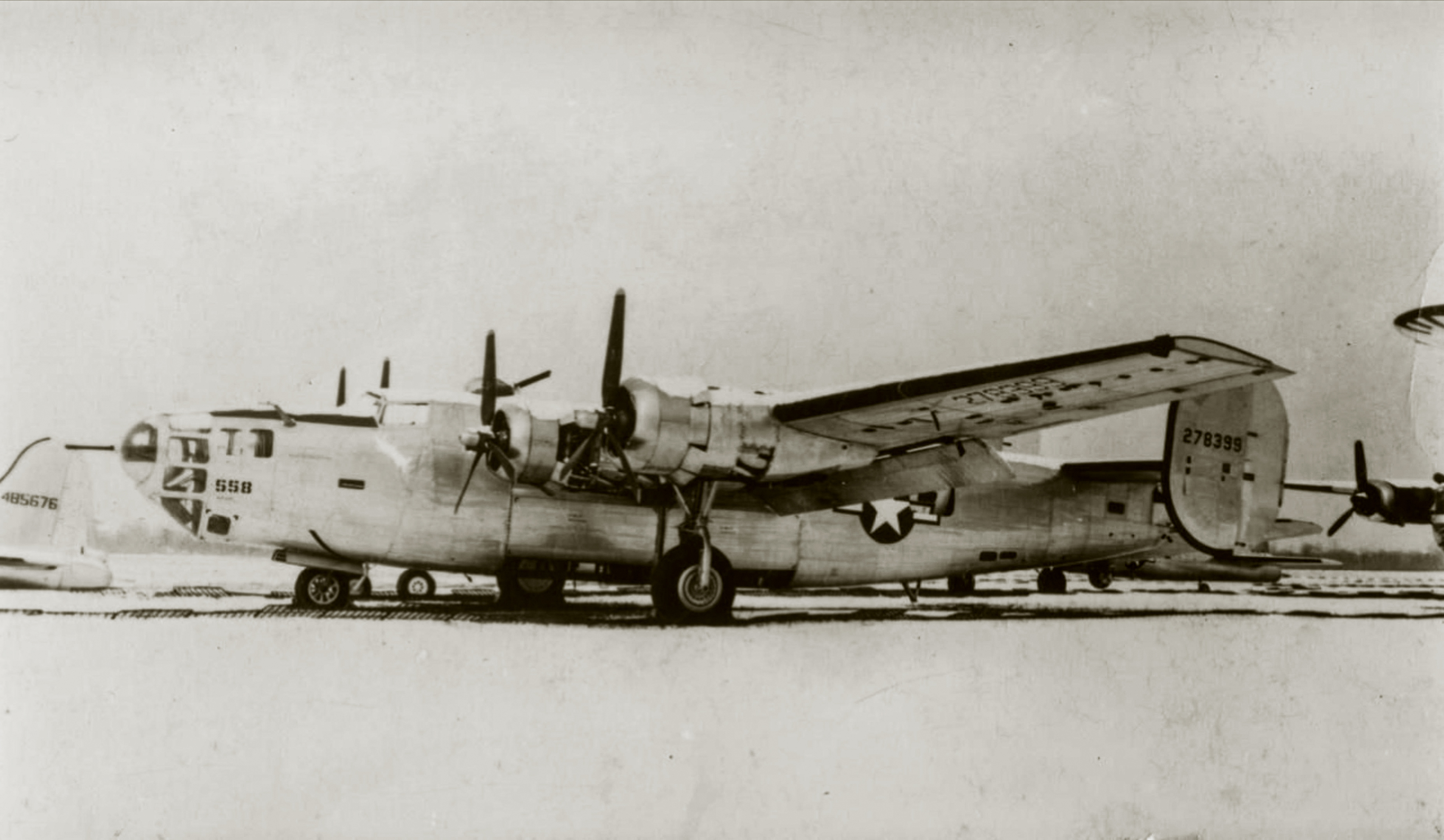
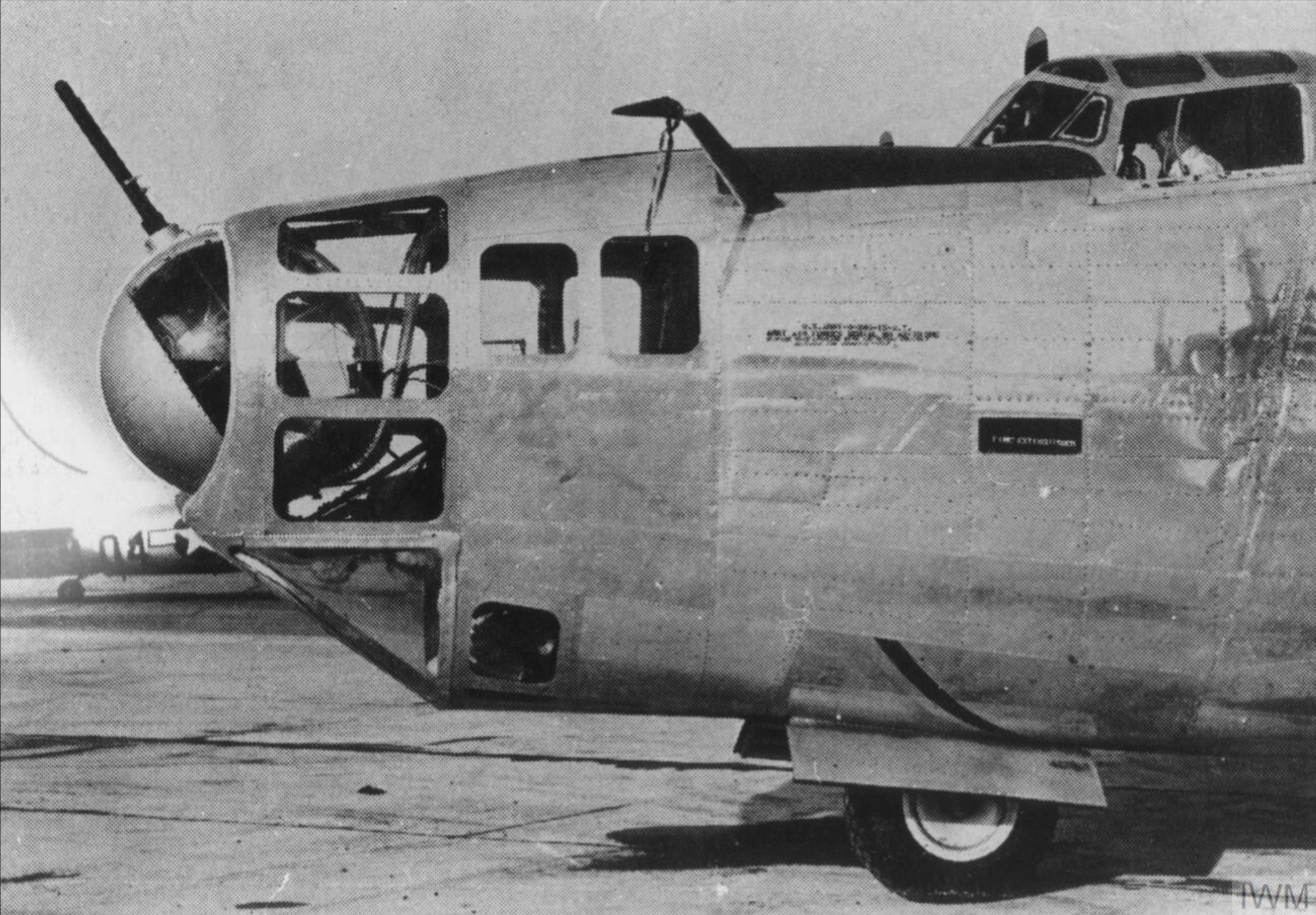
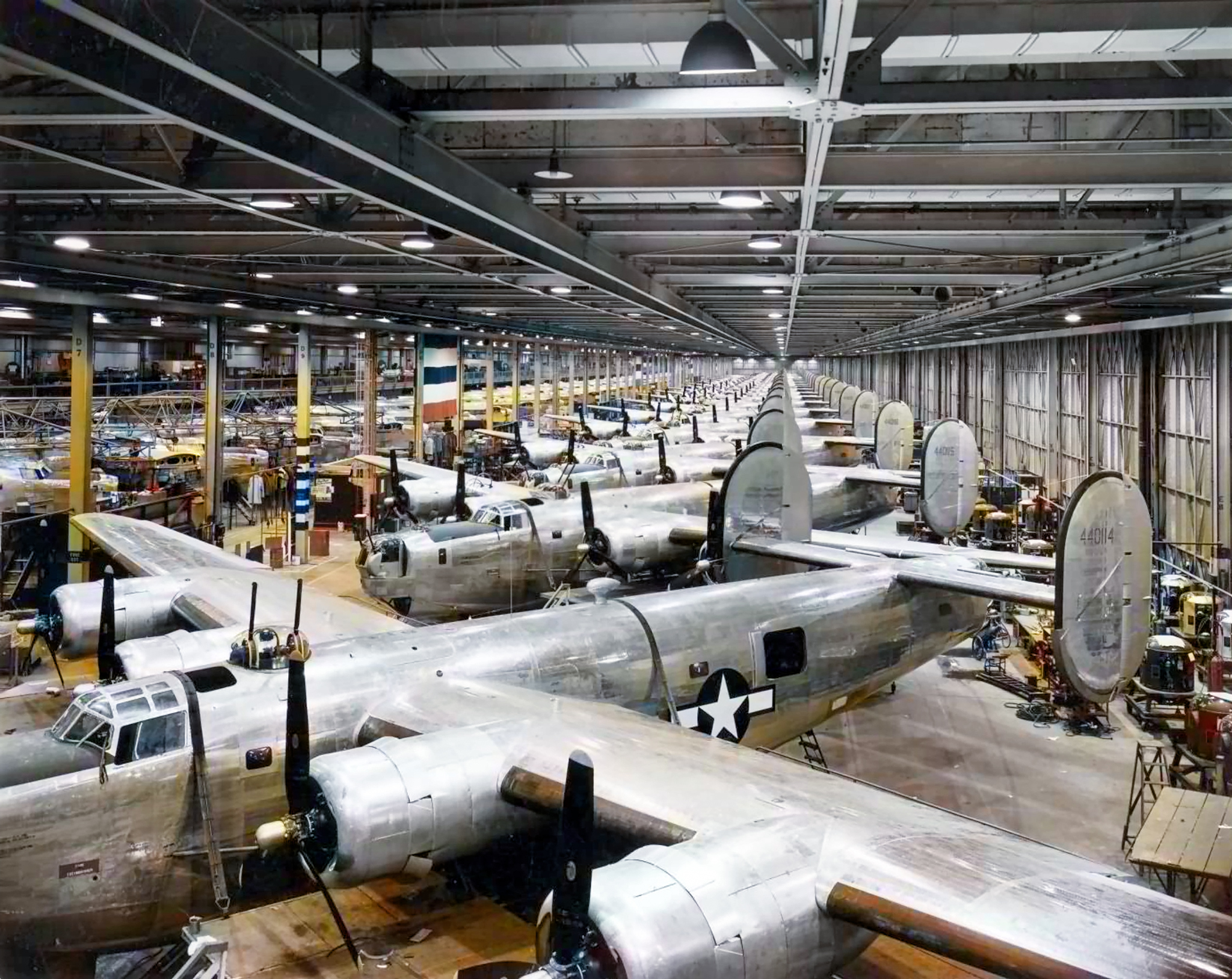
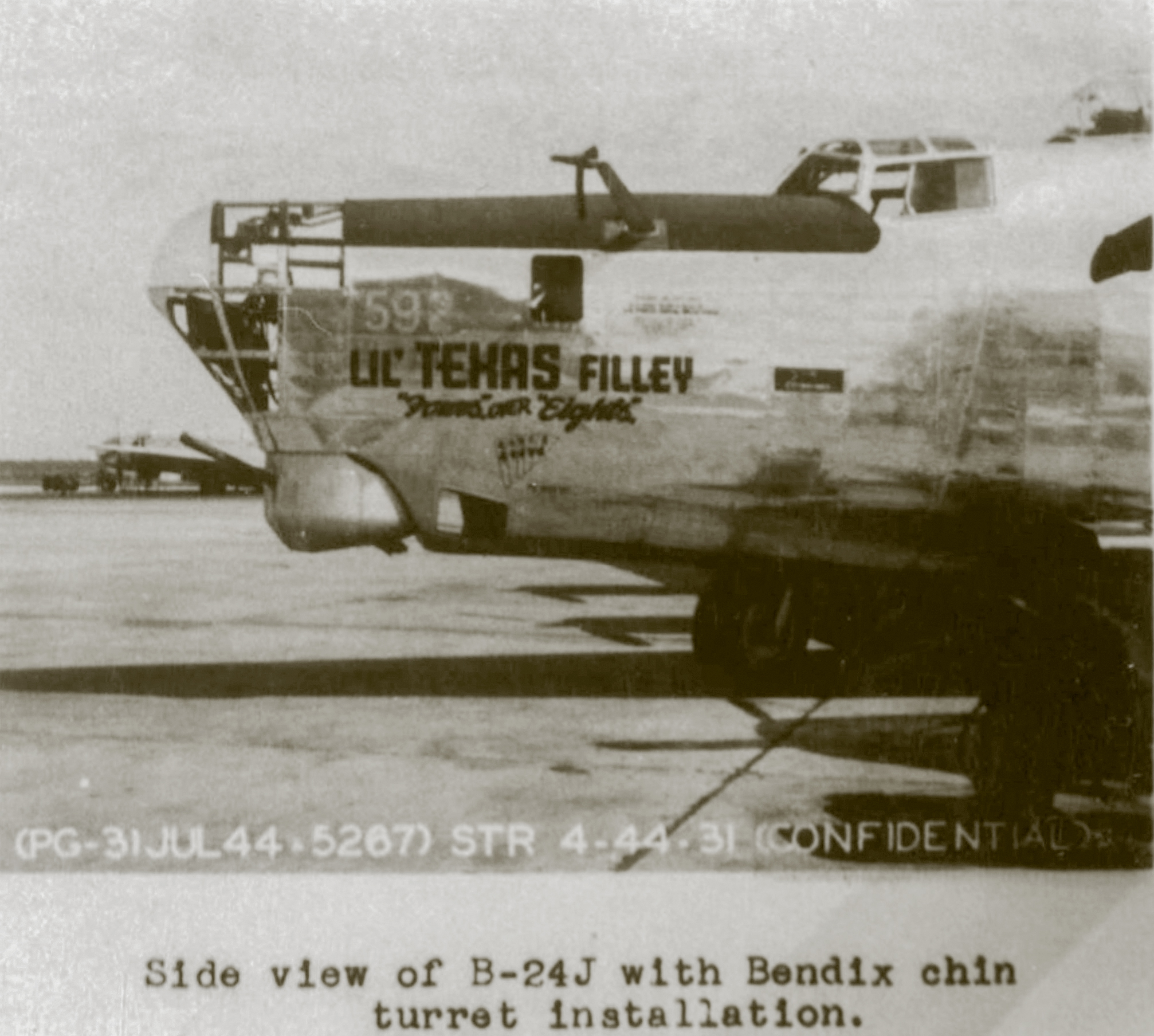
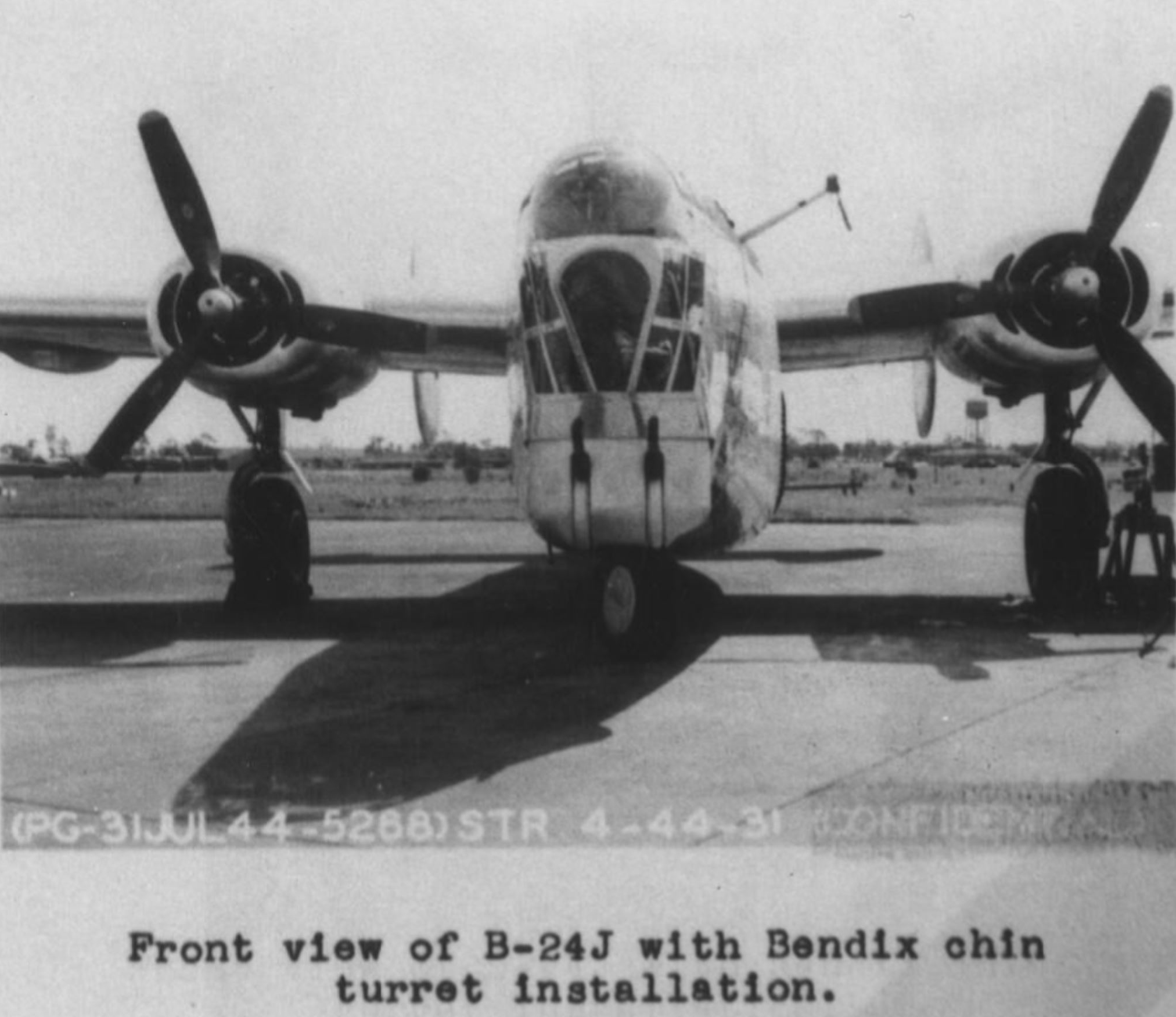

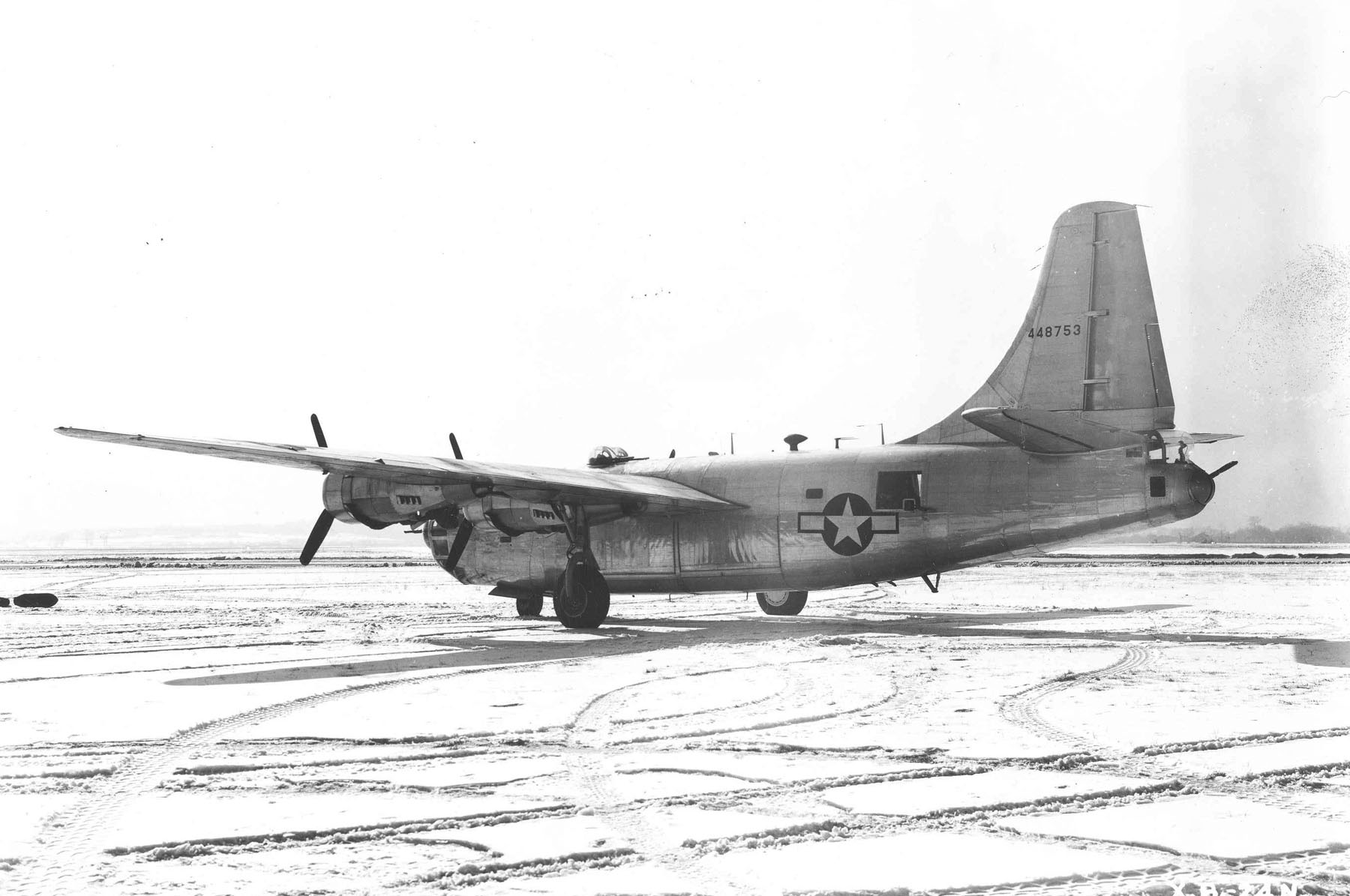
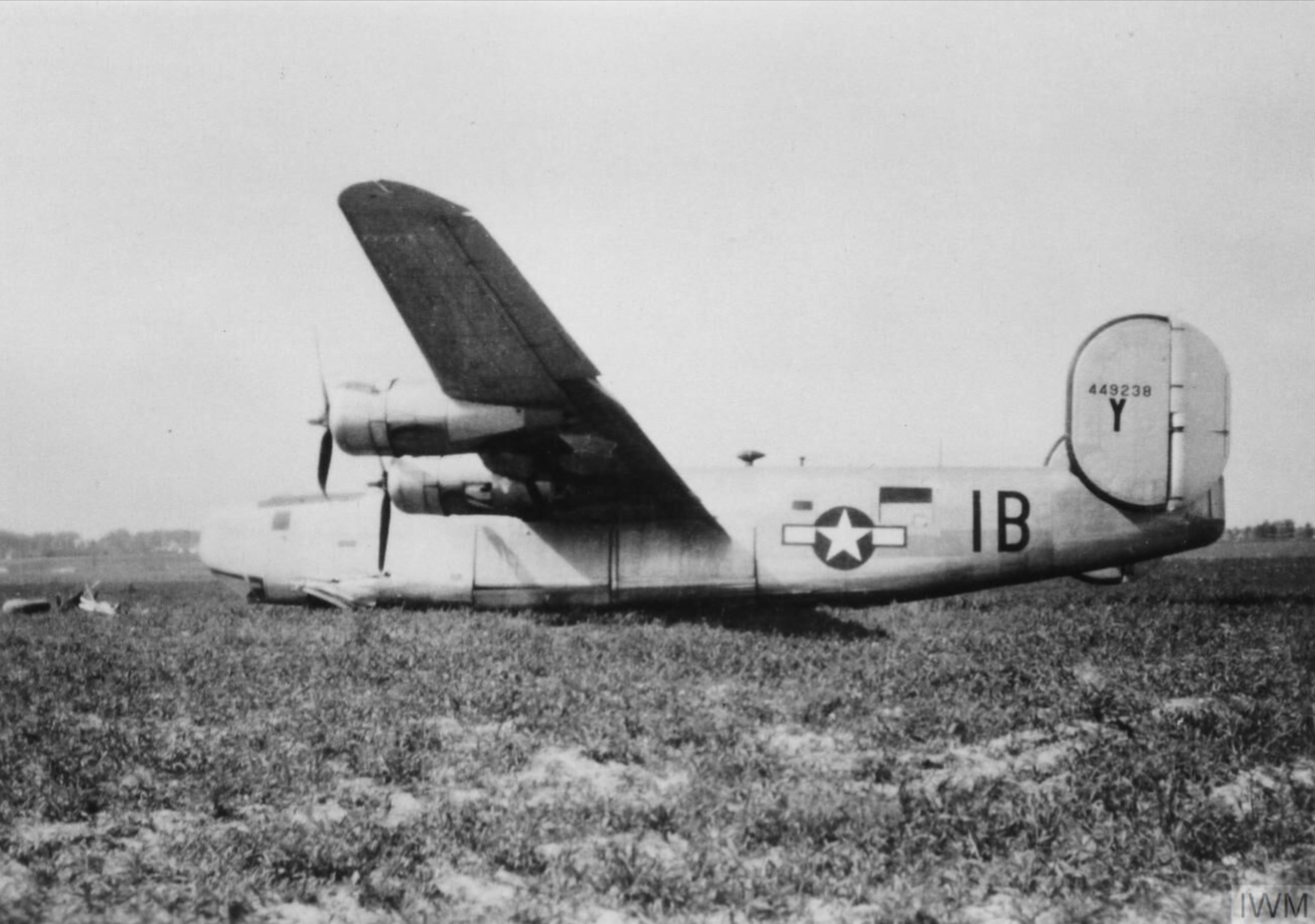
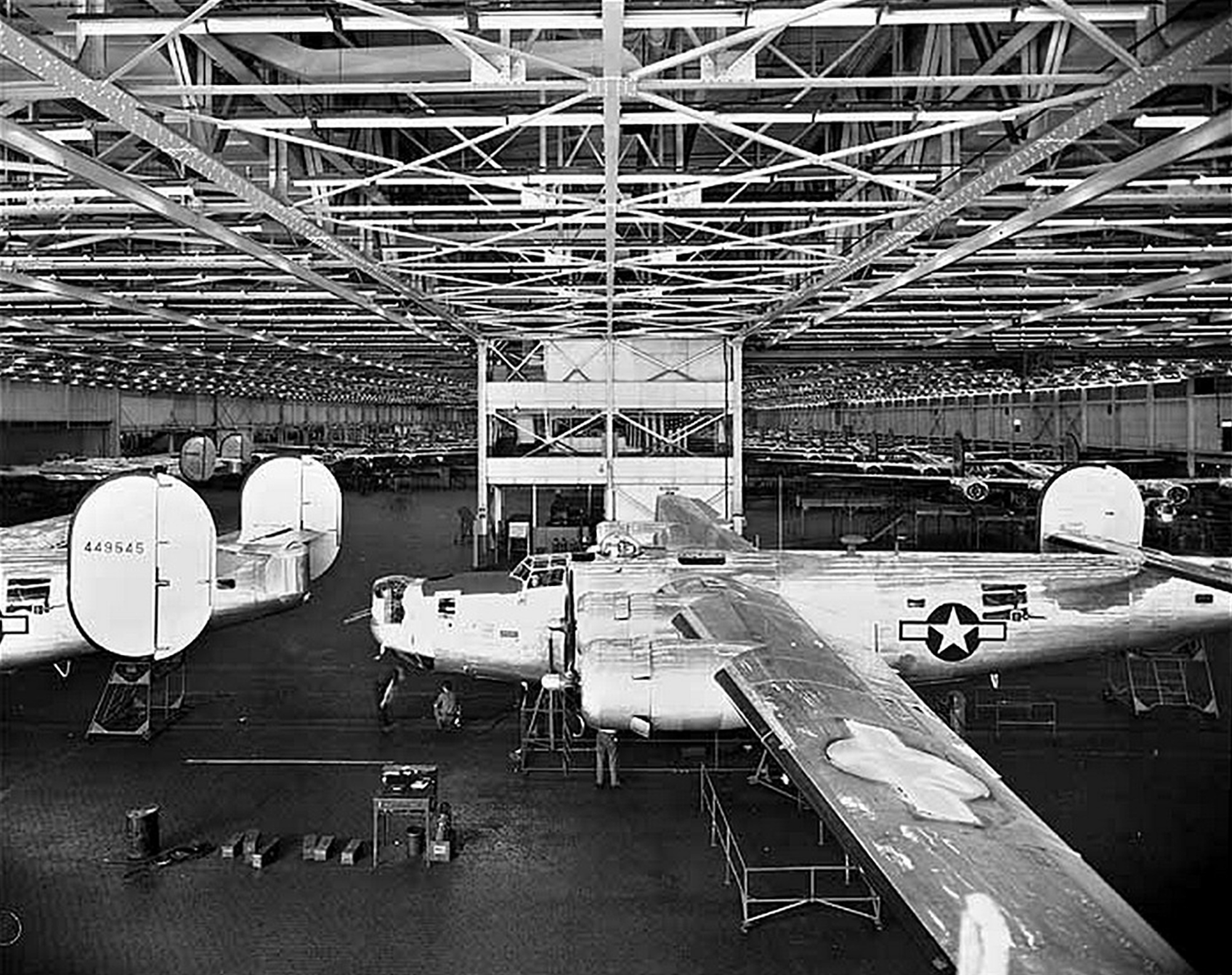

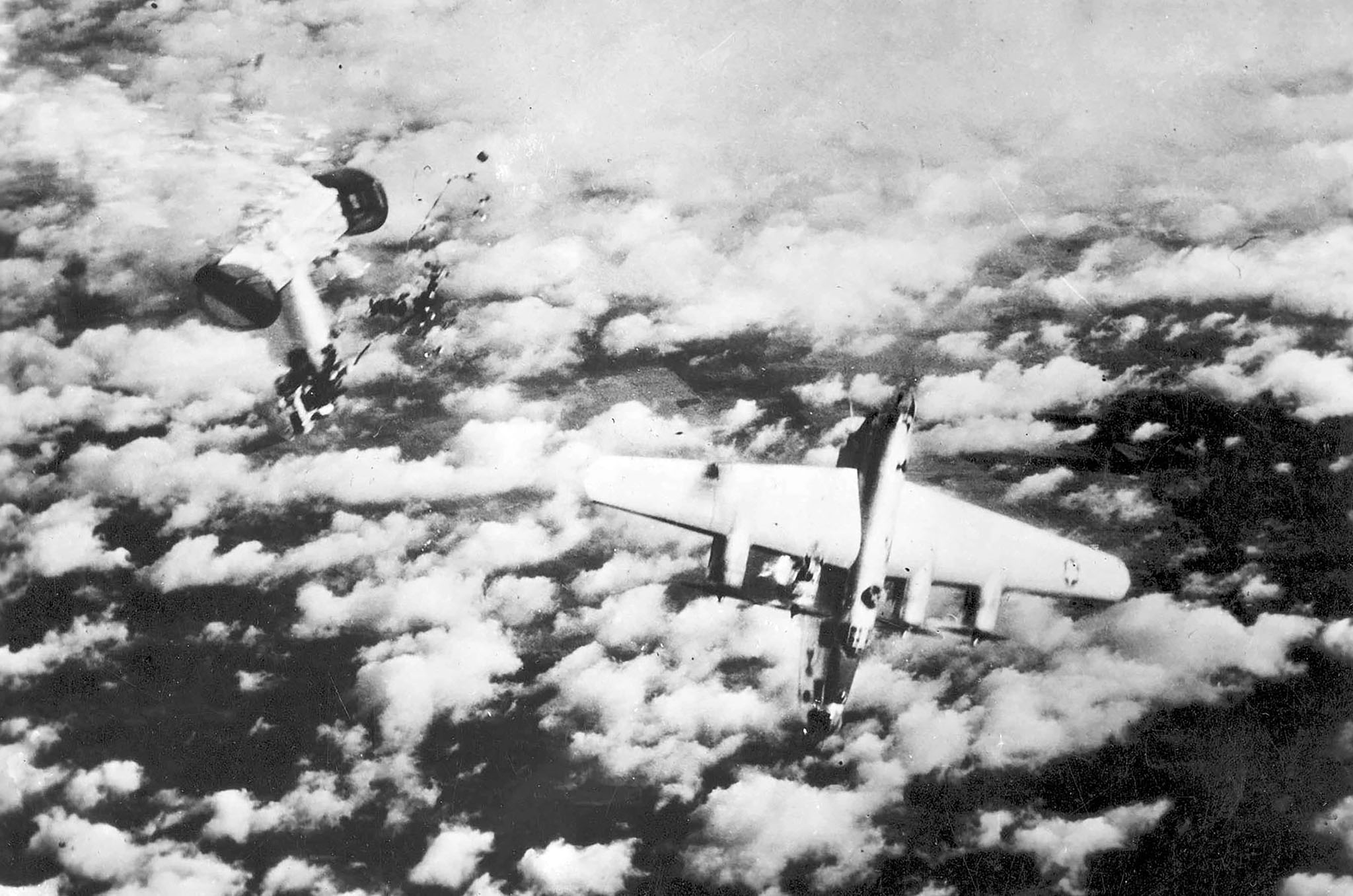

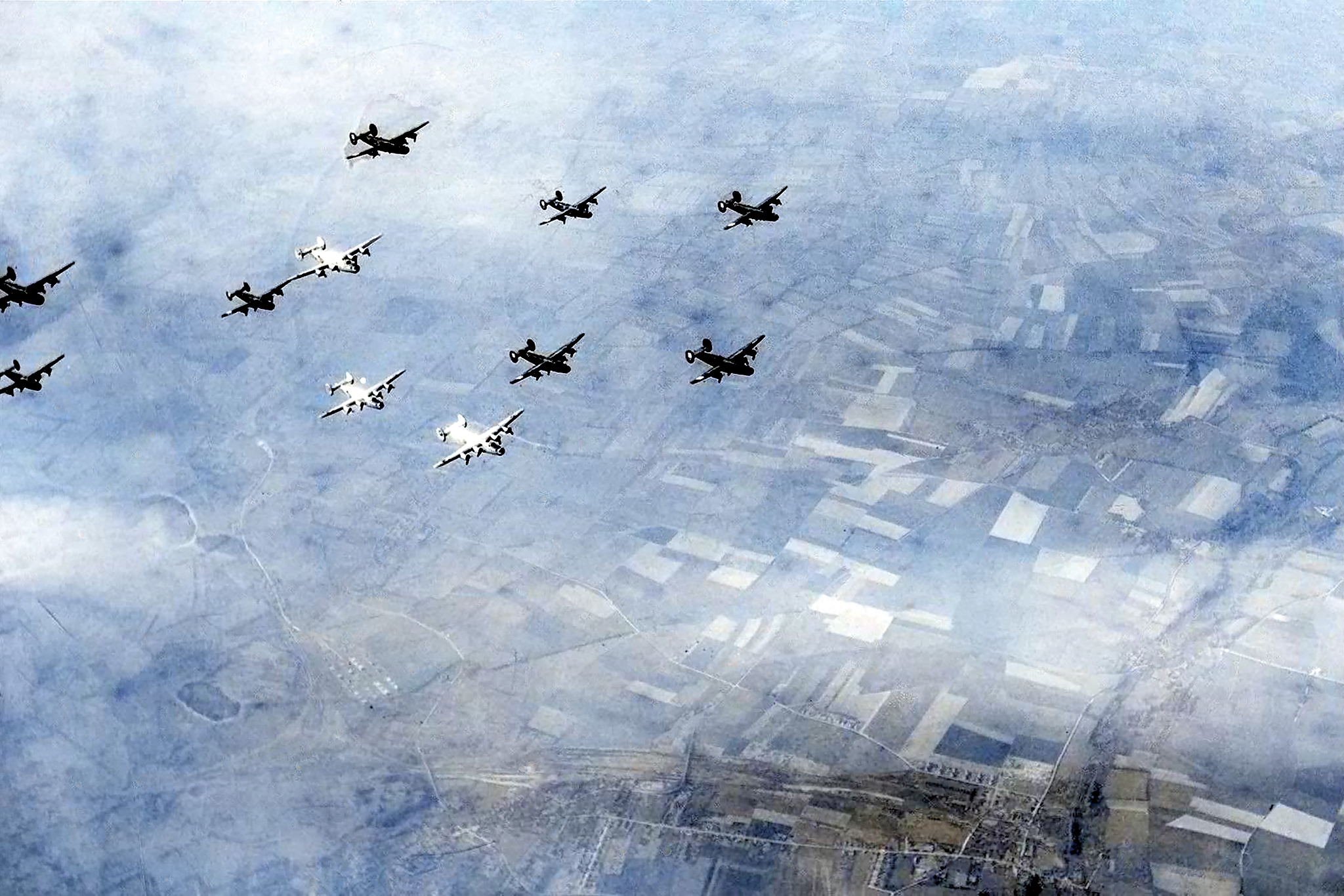
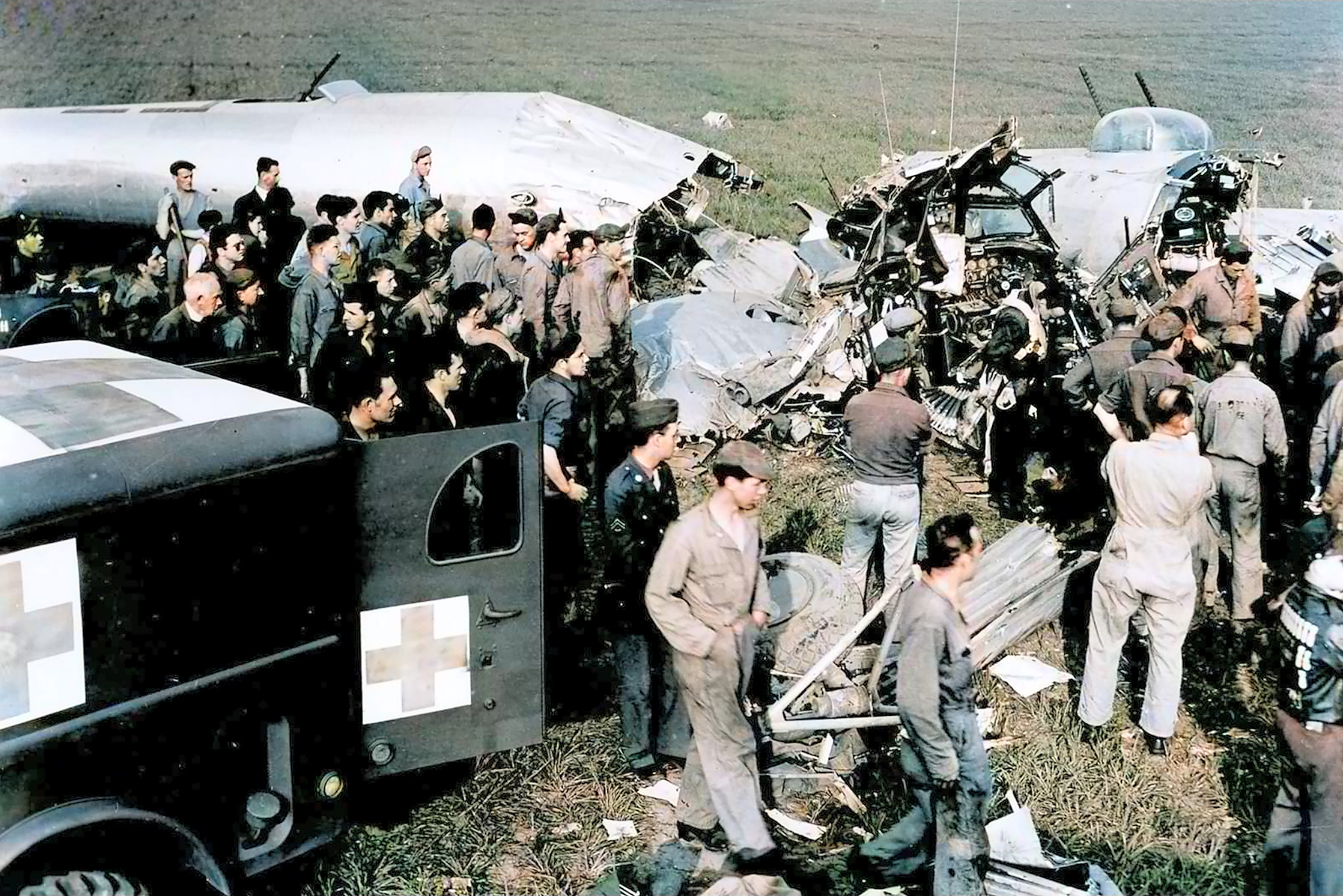
-modifications-at-the-Consolidated-Vultee-Plant-Fort-Worth-Texas-01.jpg)
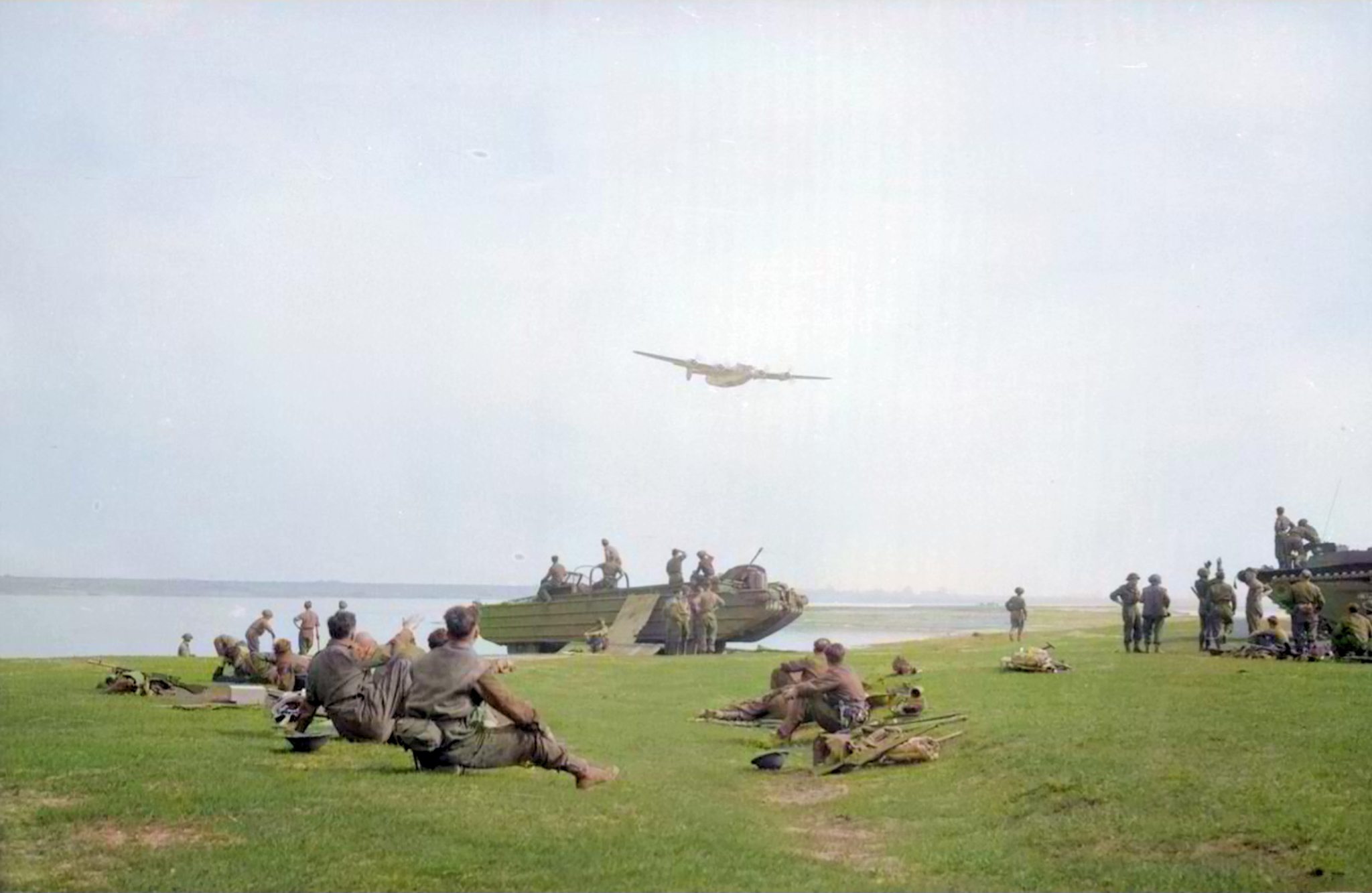
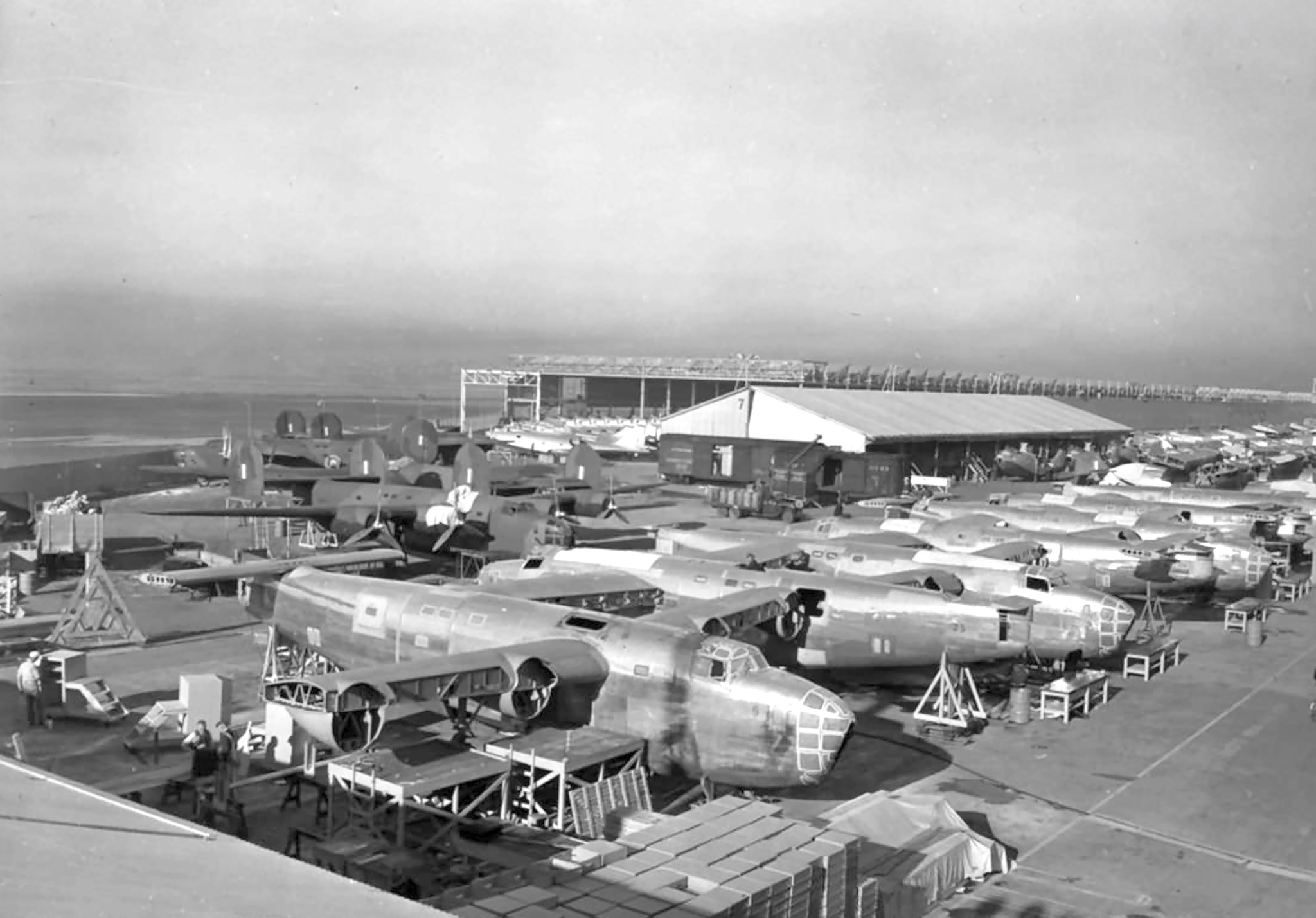
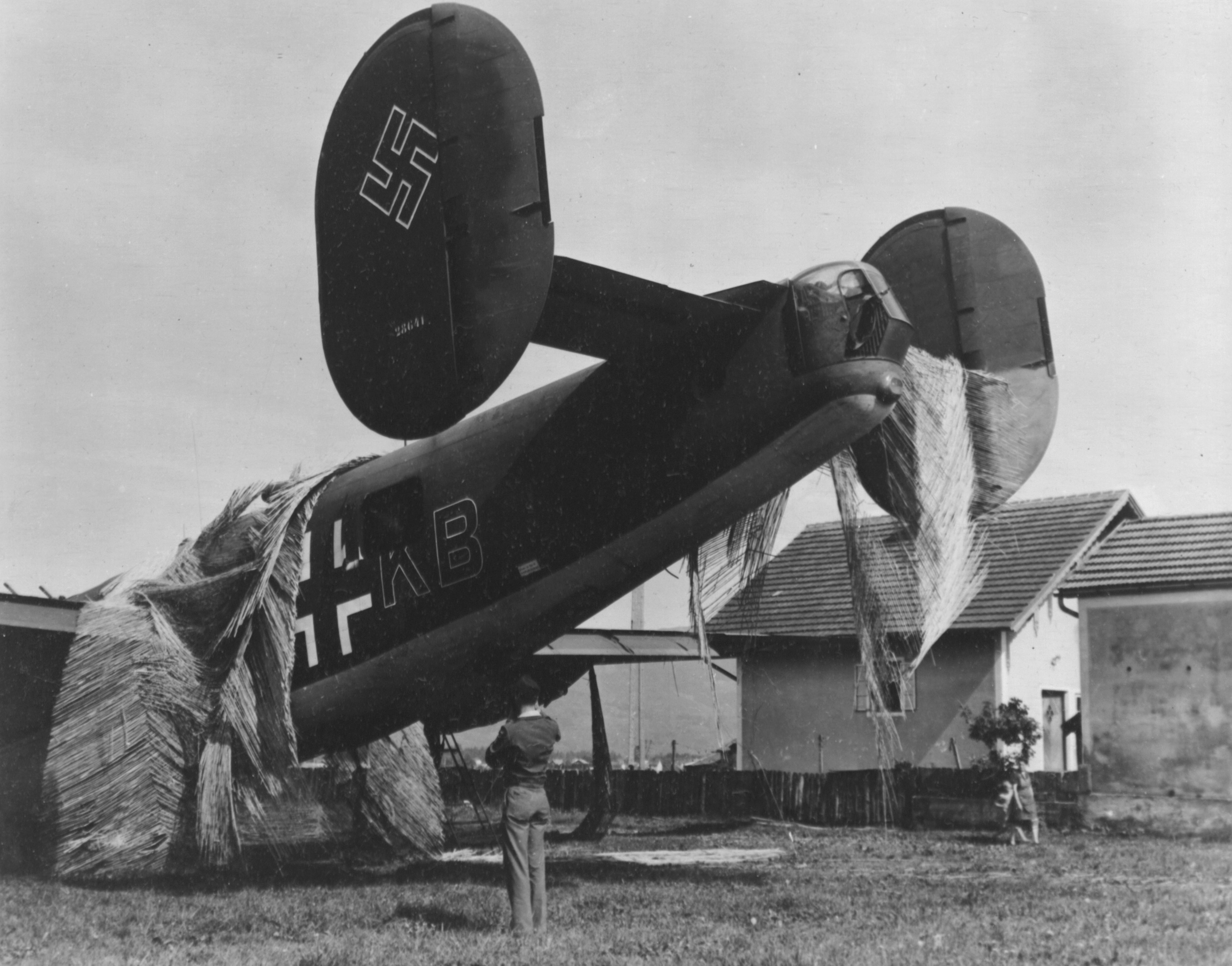
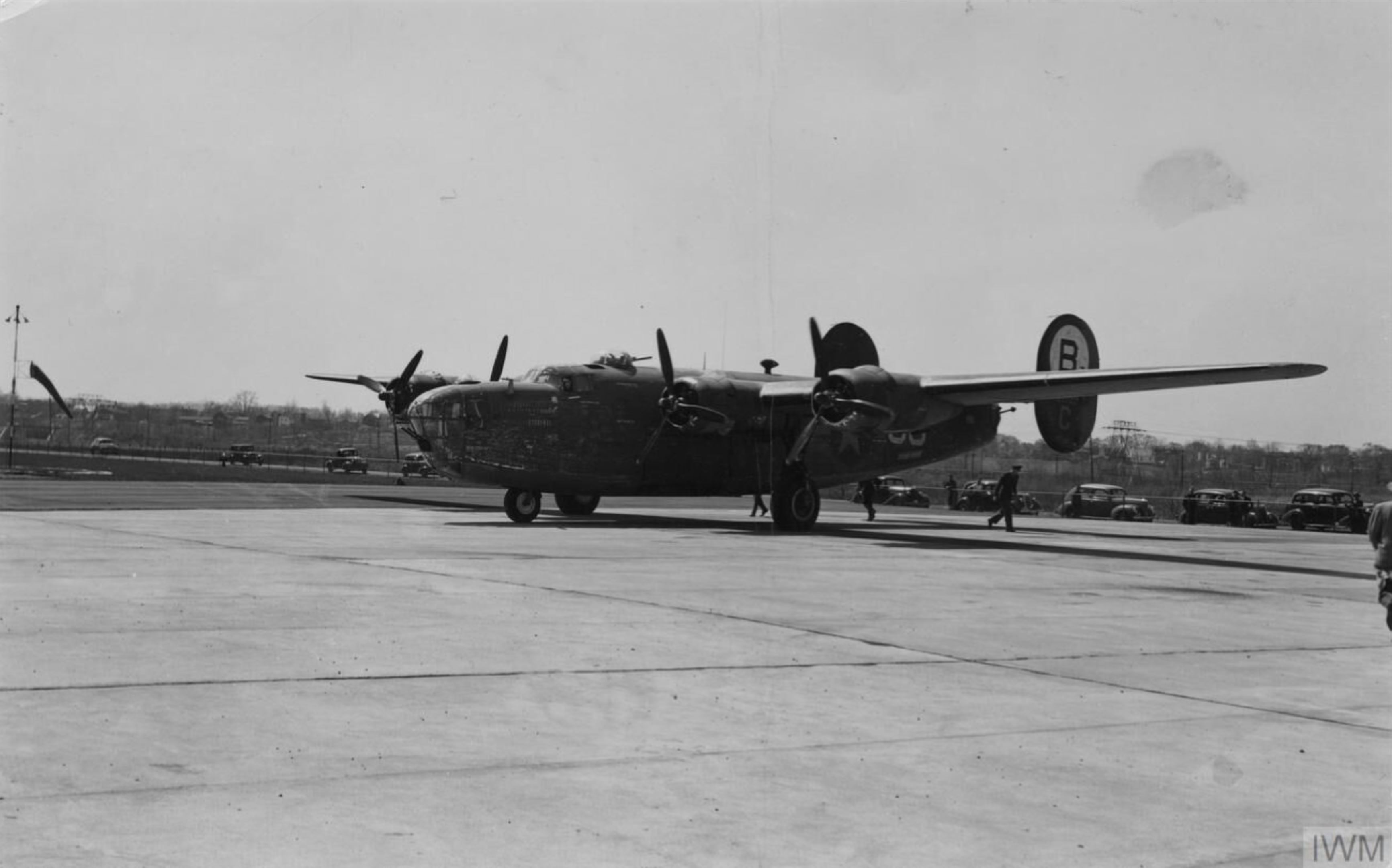


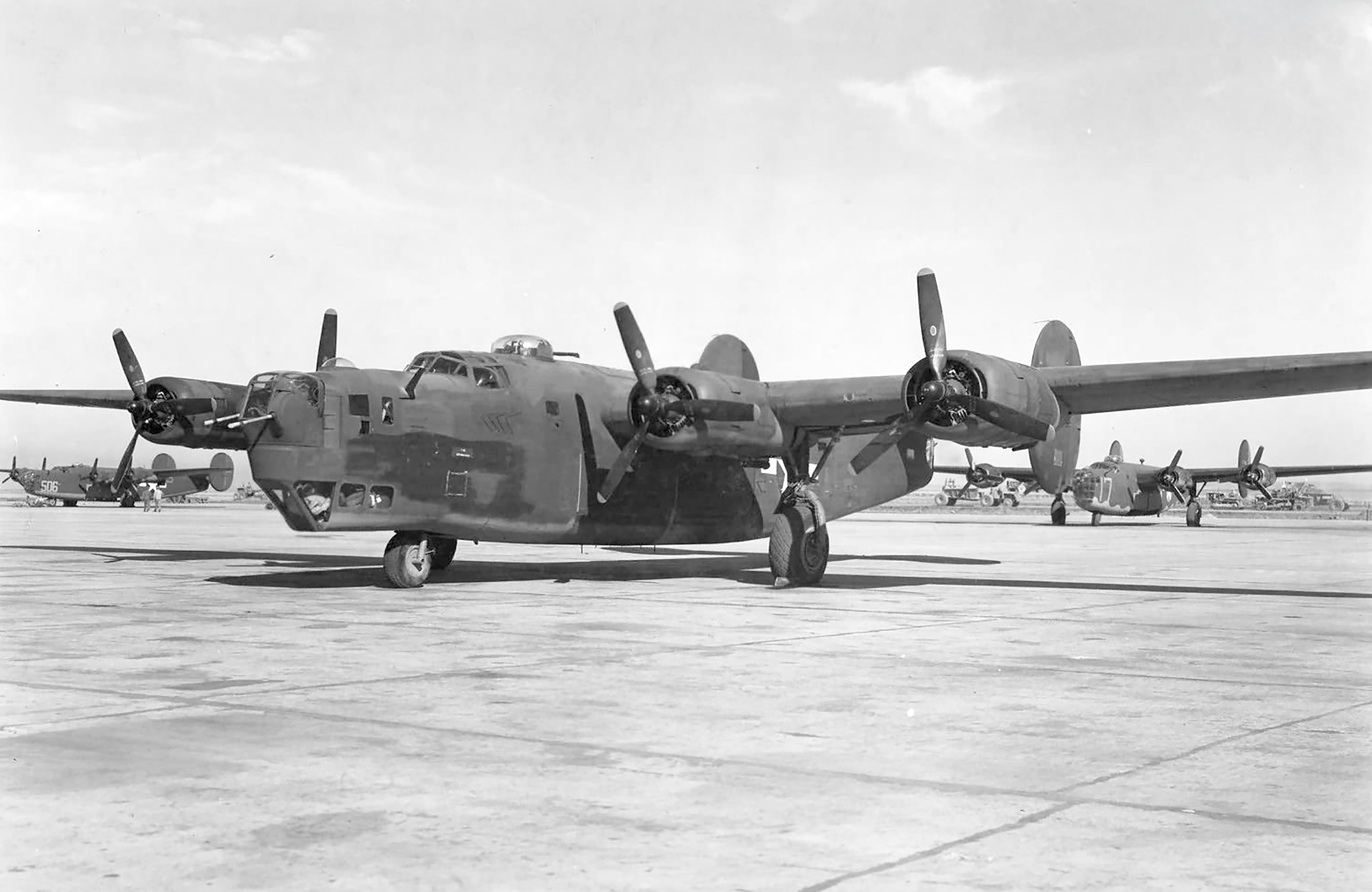
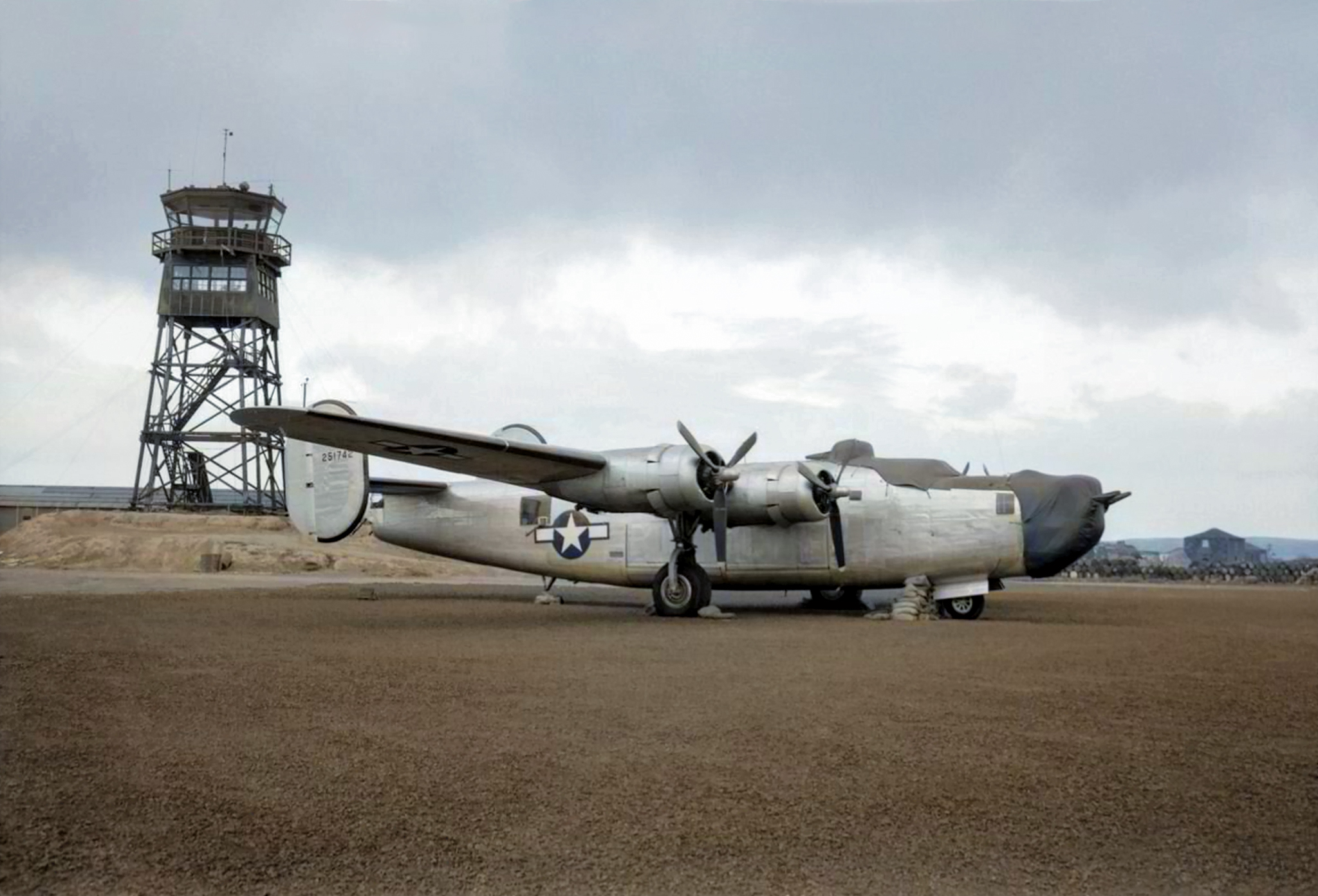

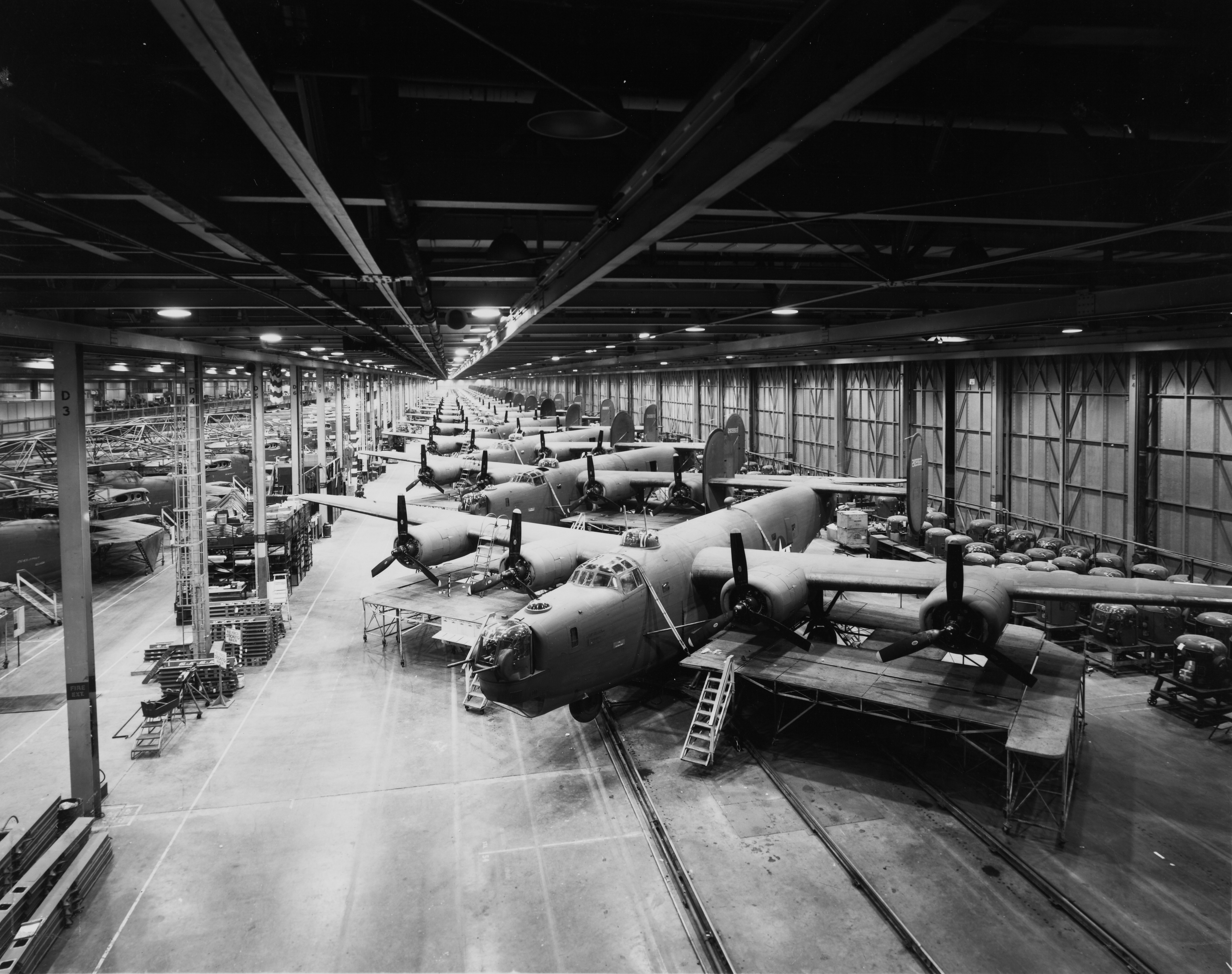
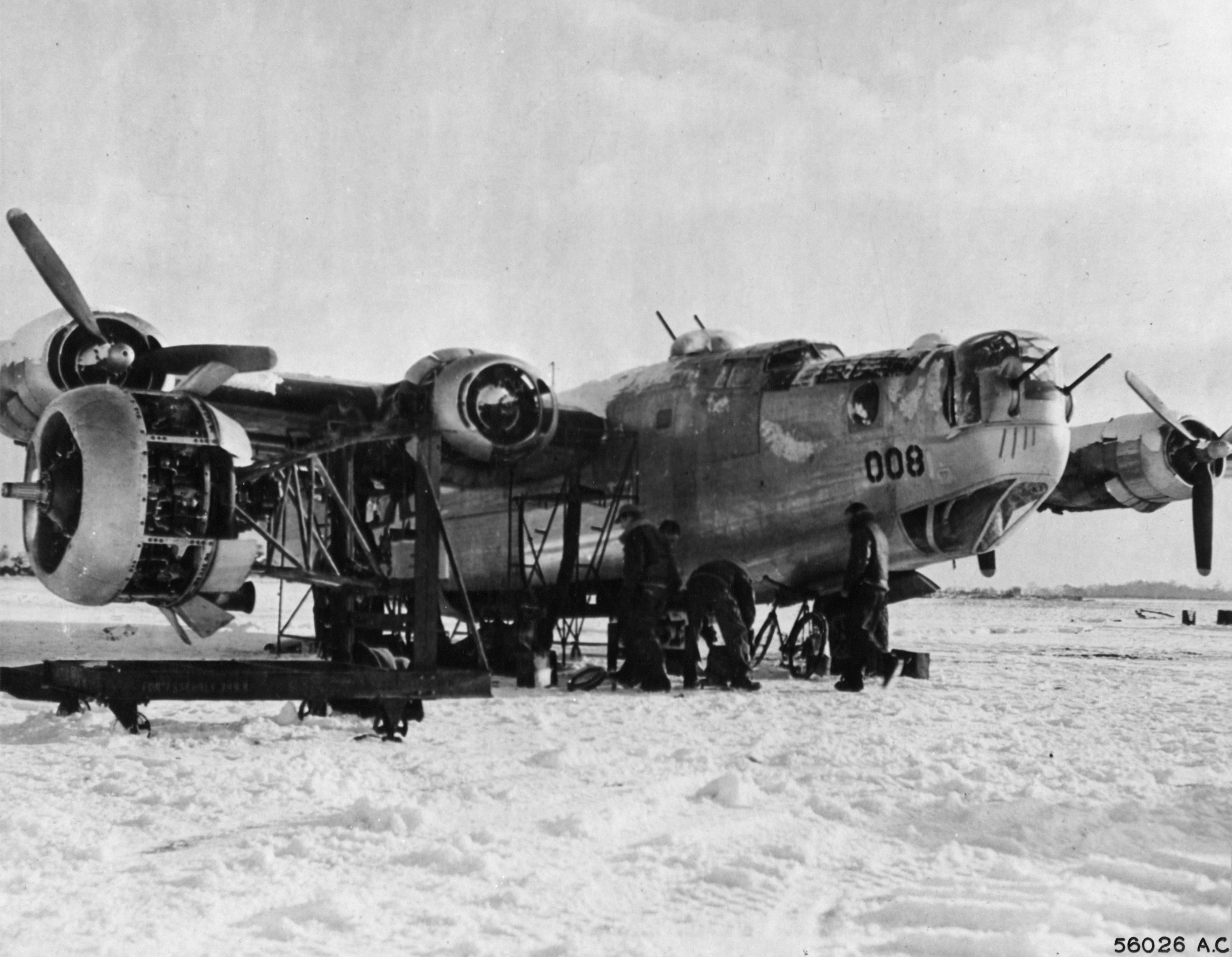
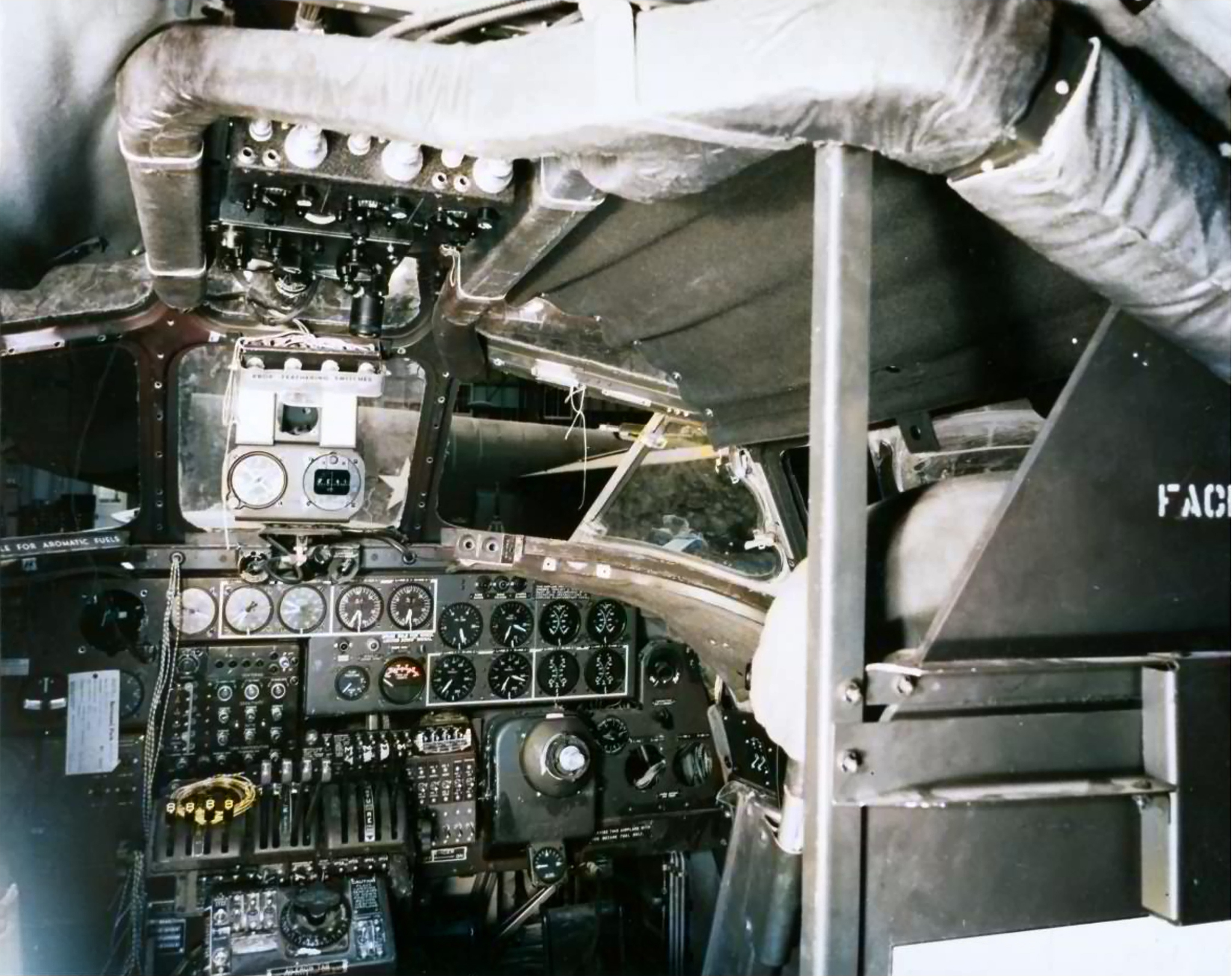
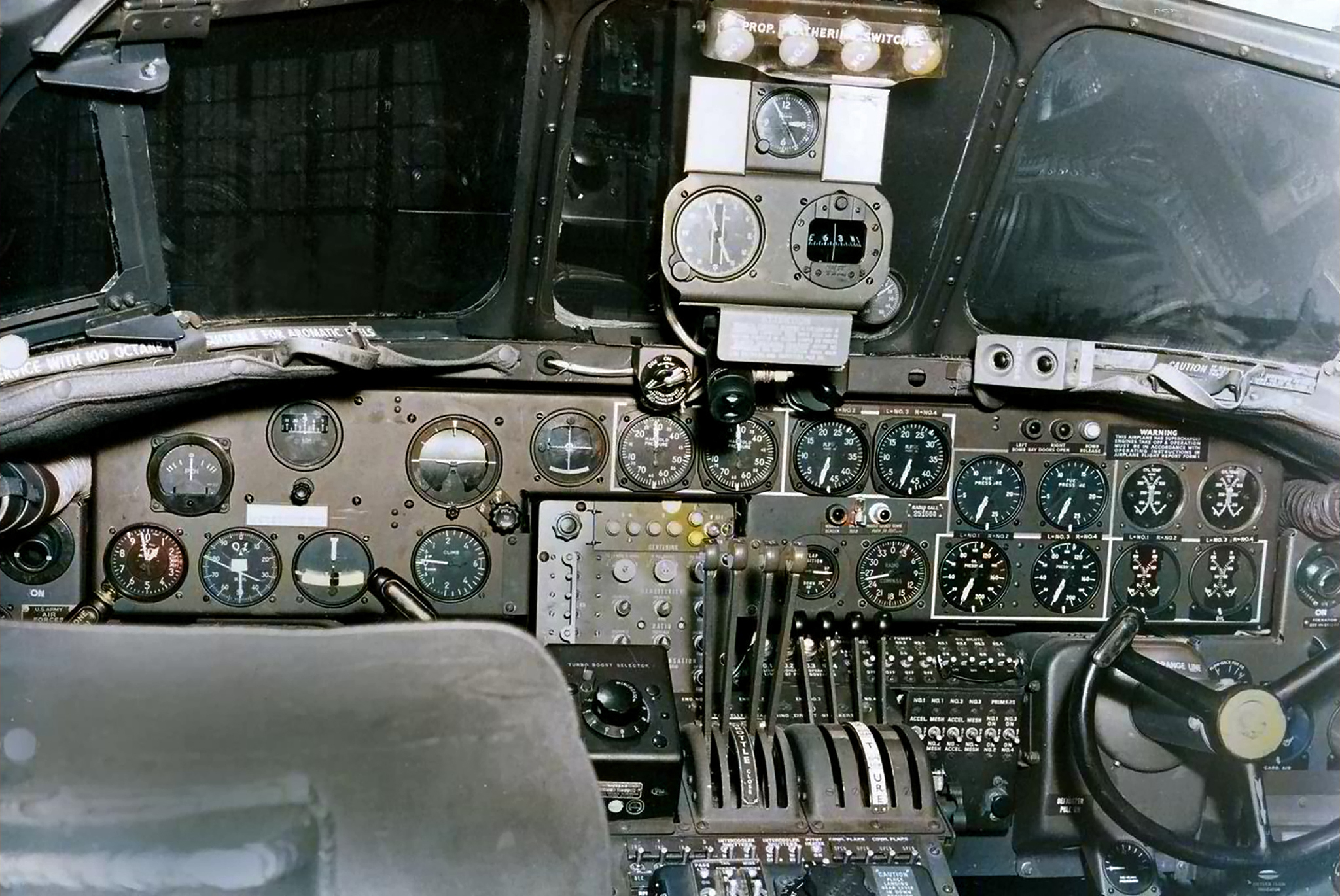

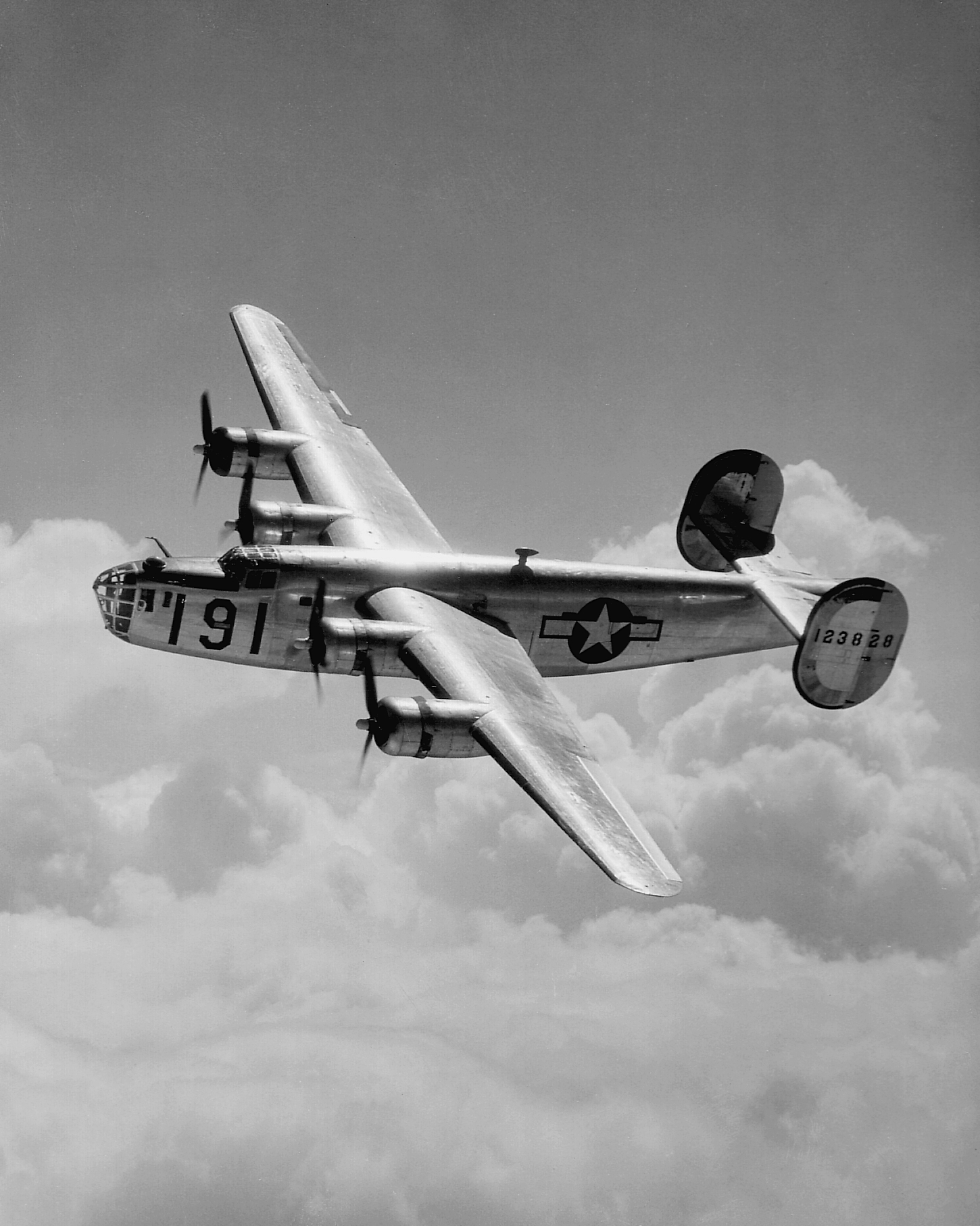
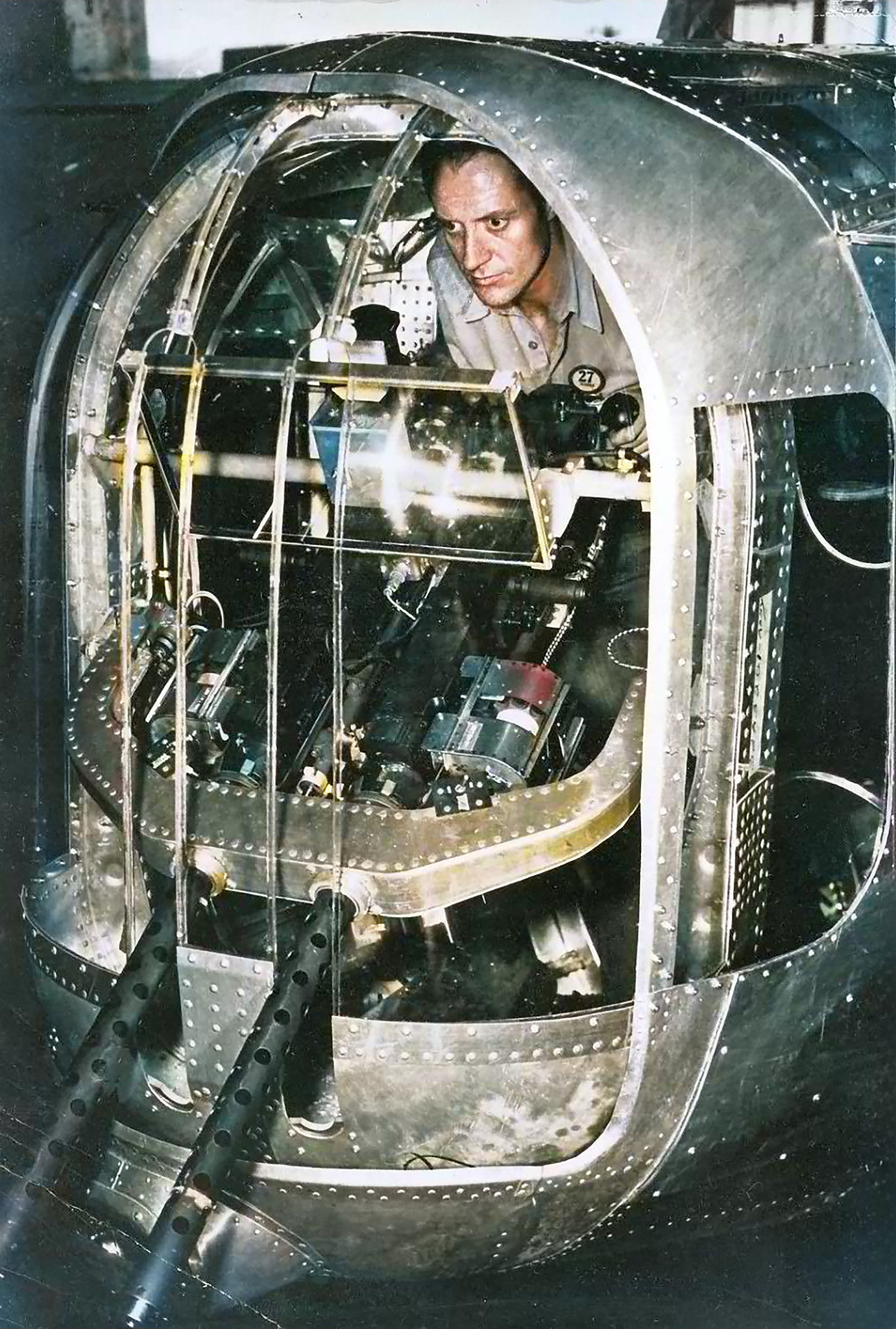


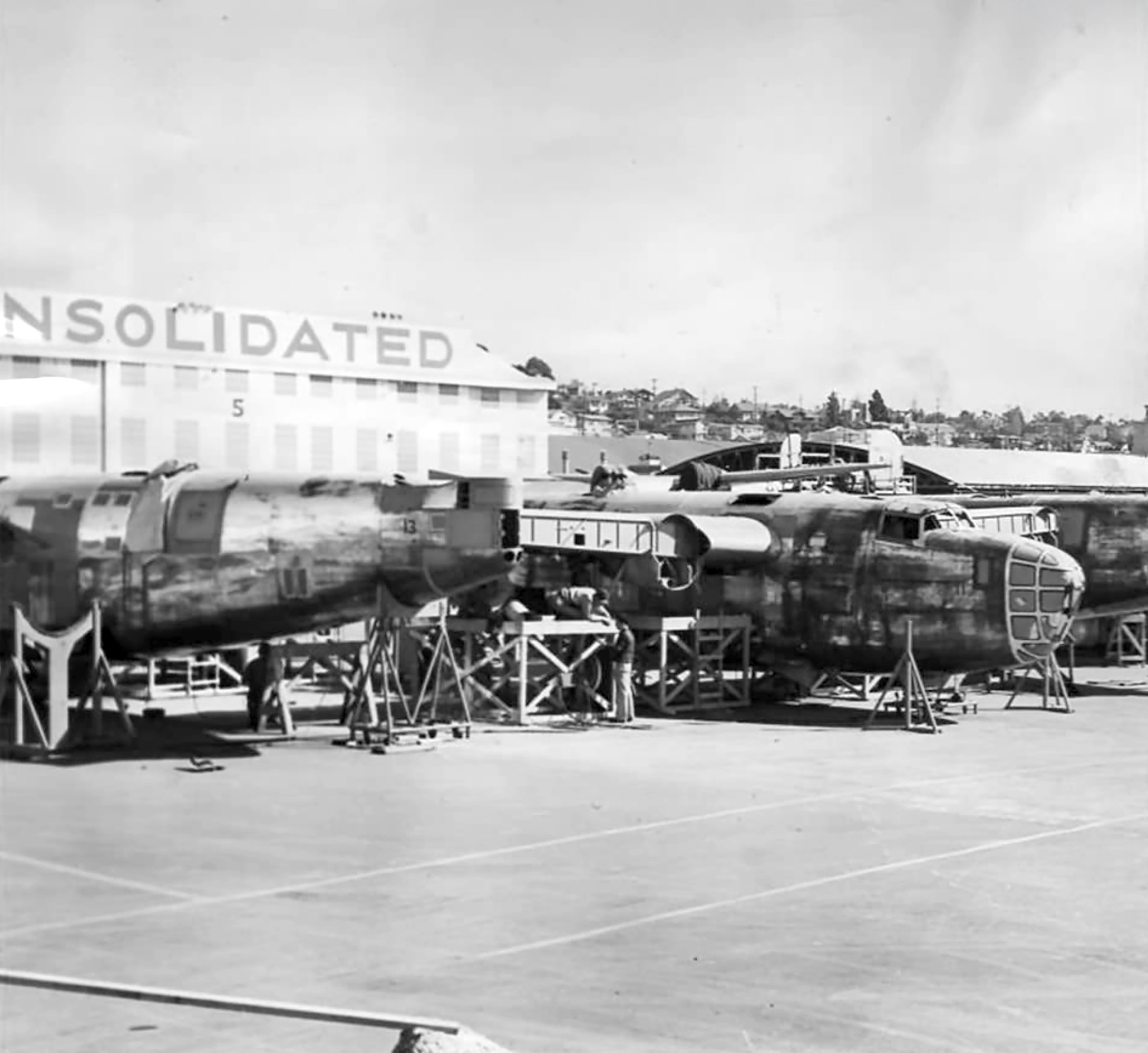

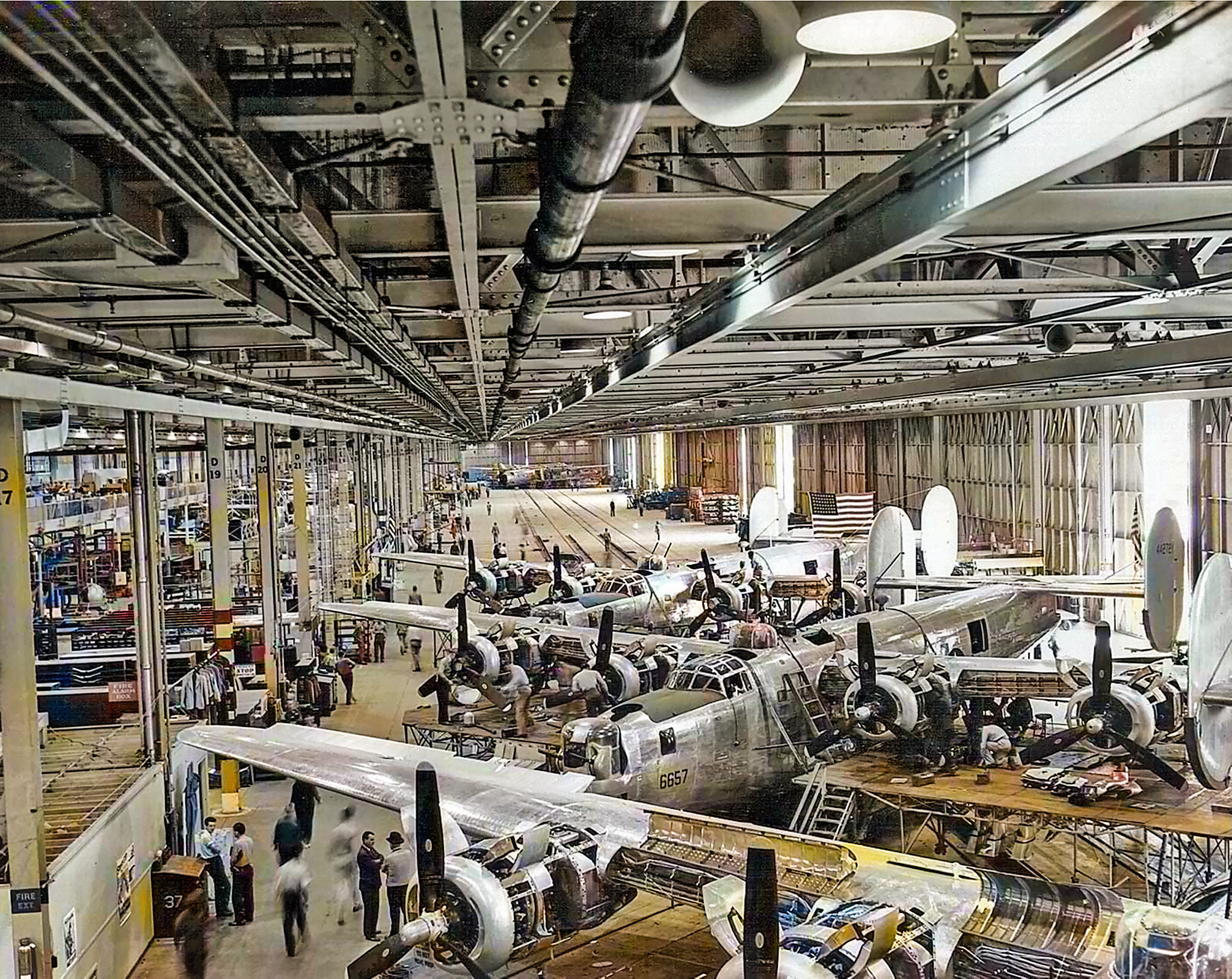
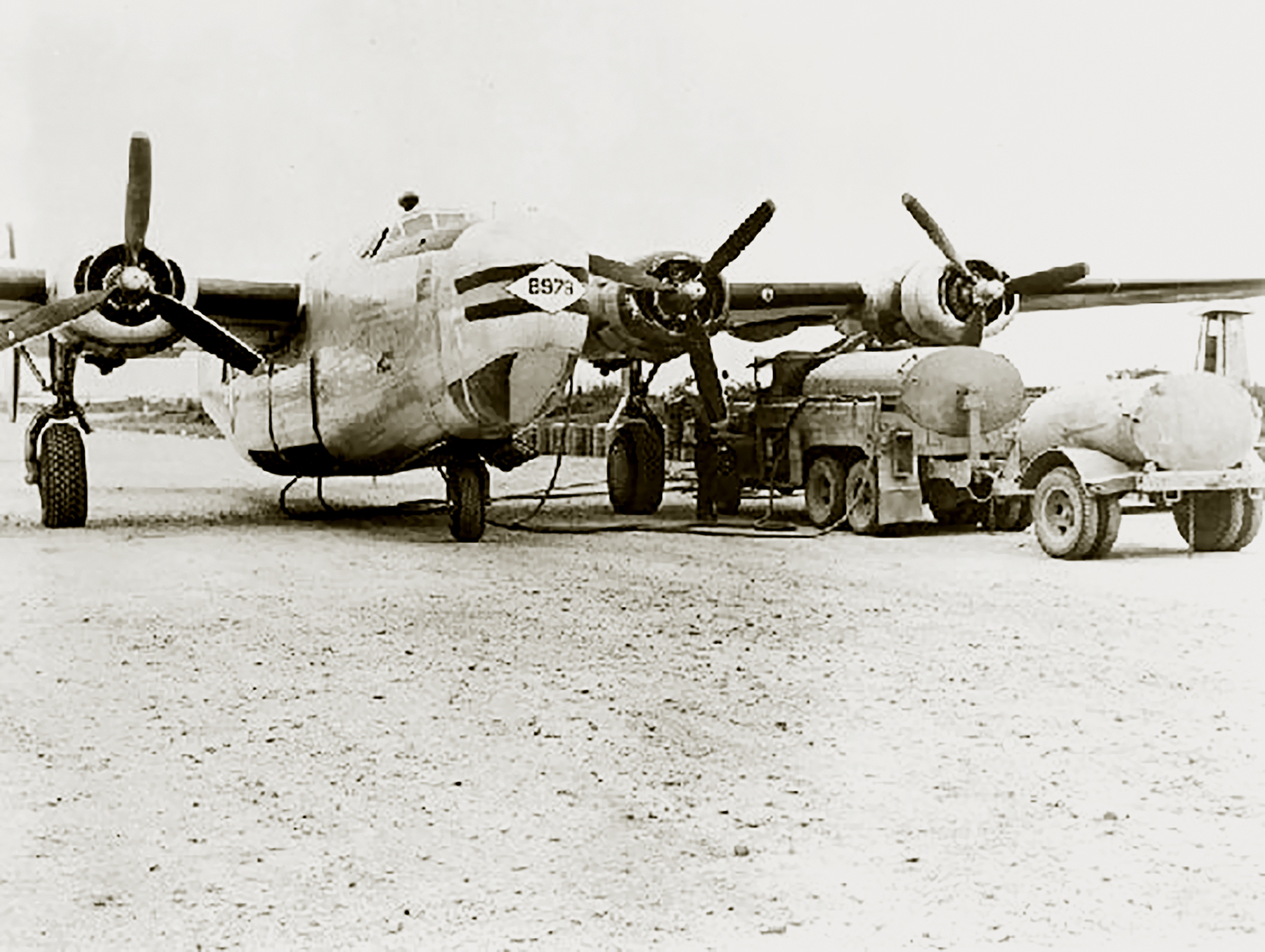

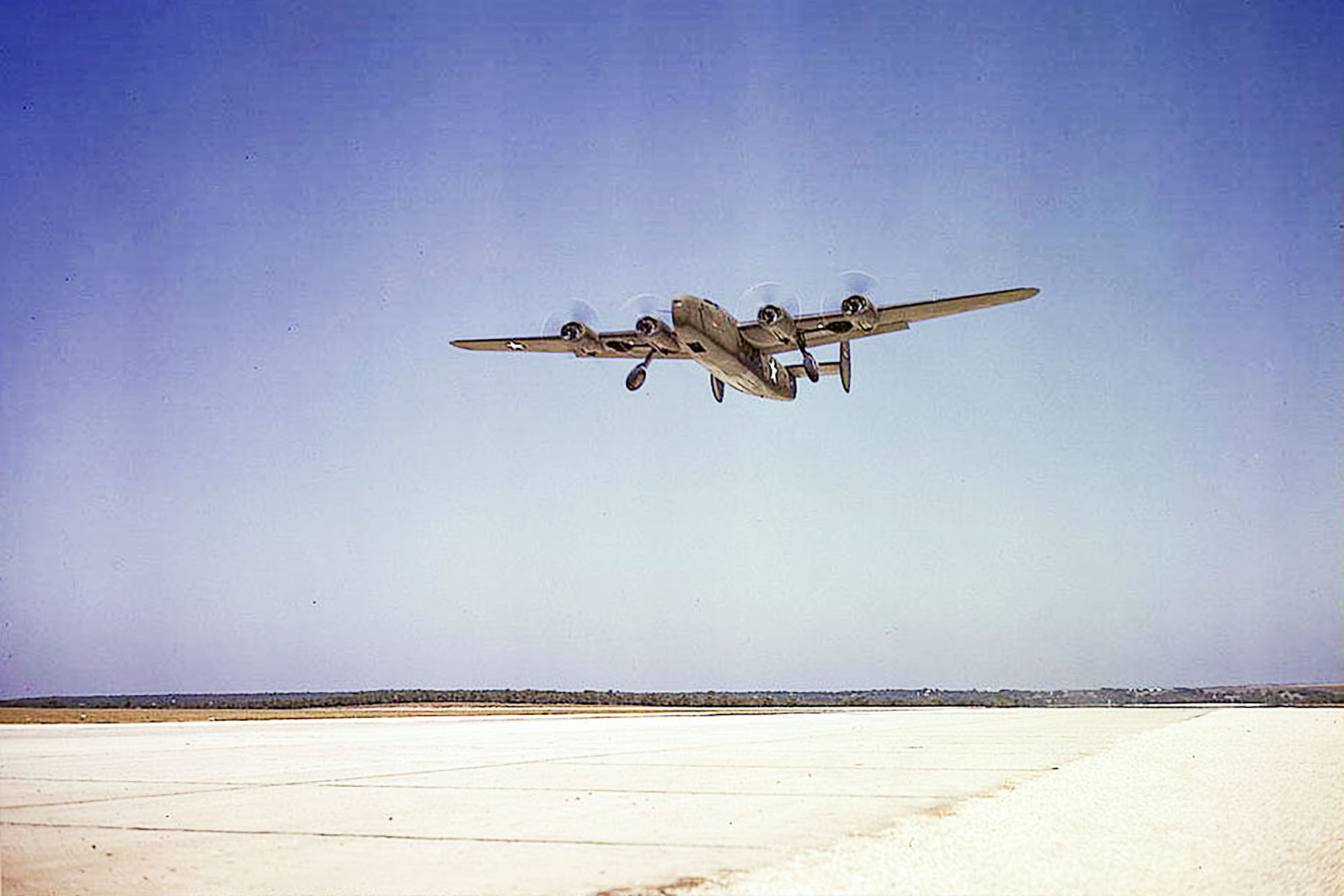
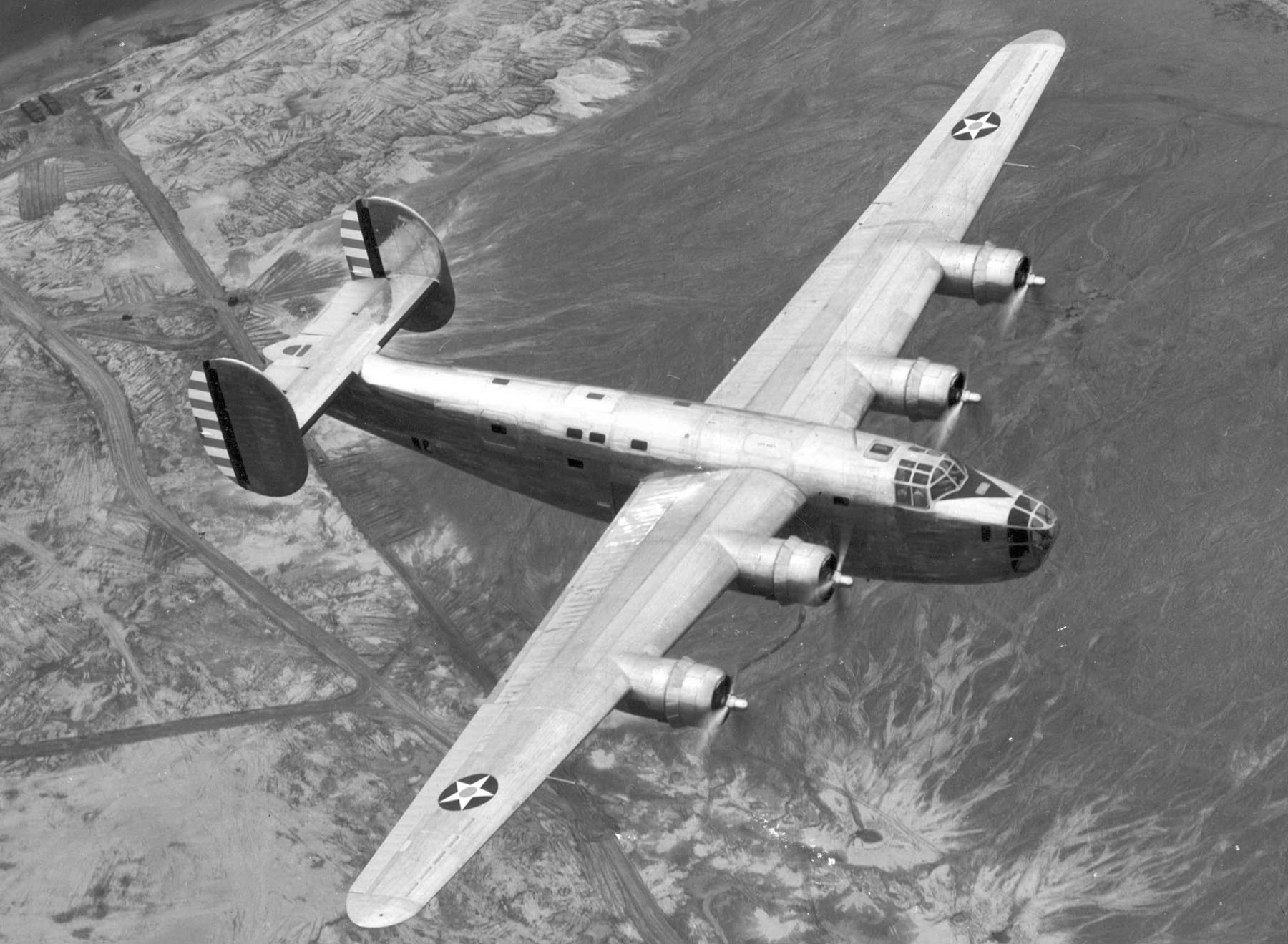


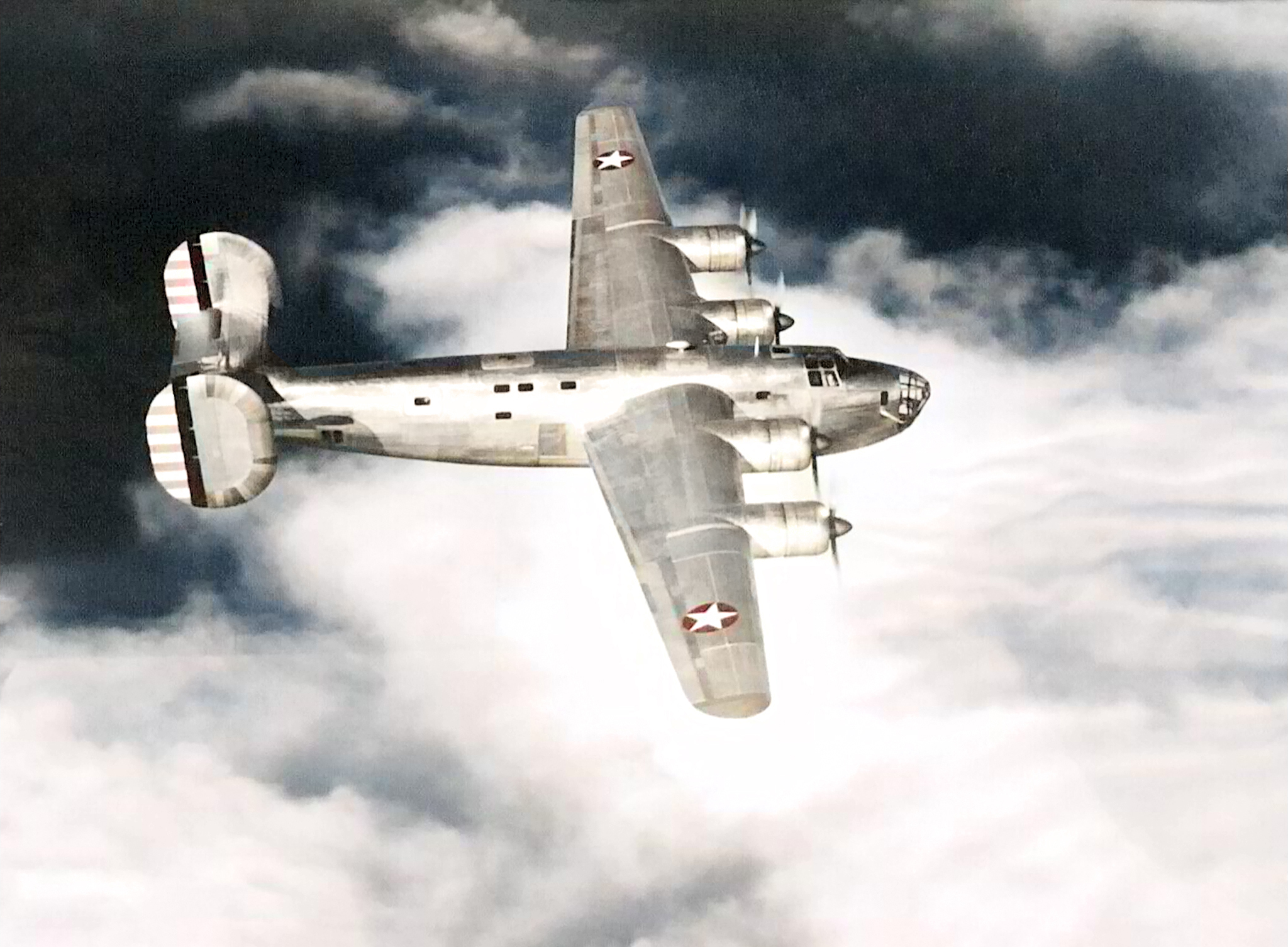

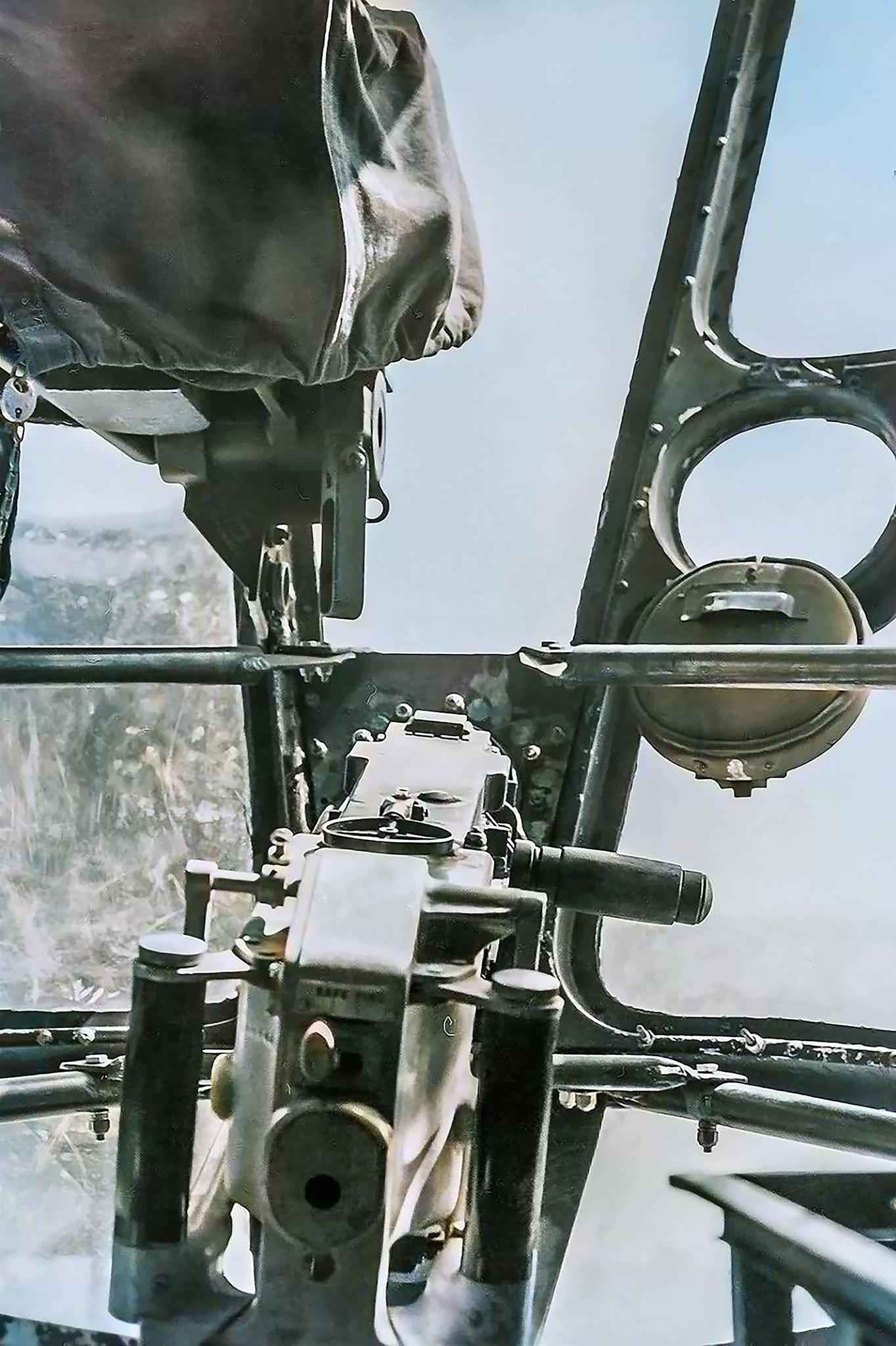
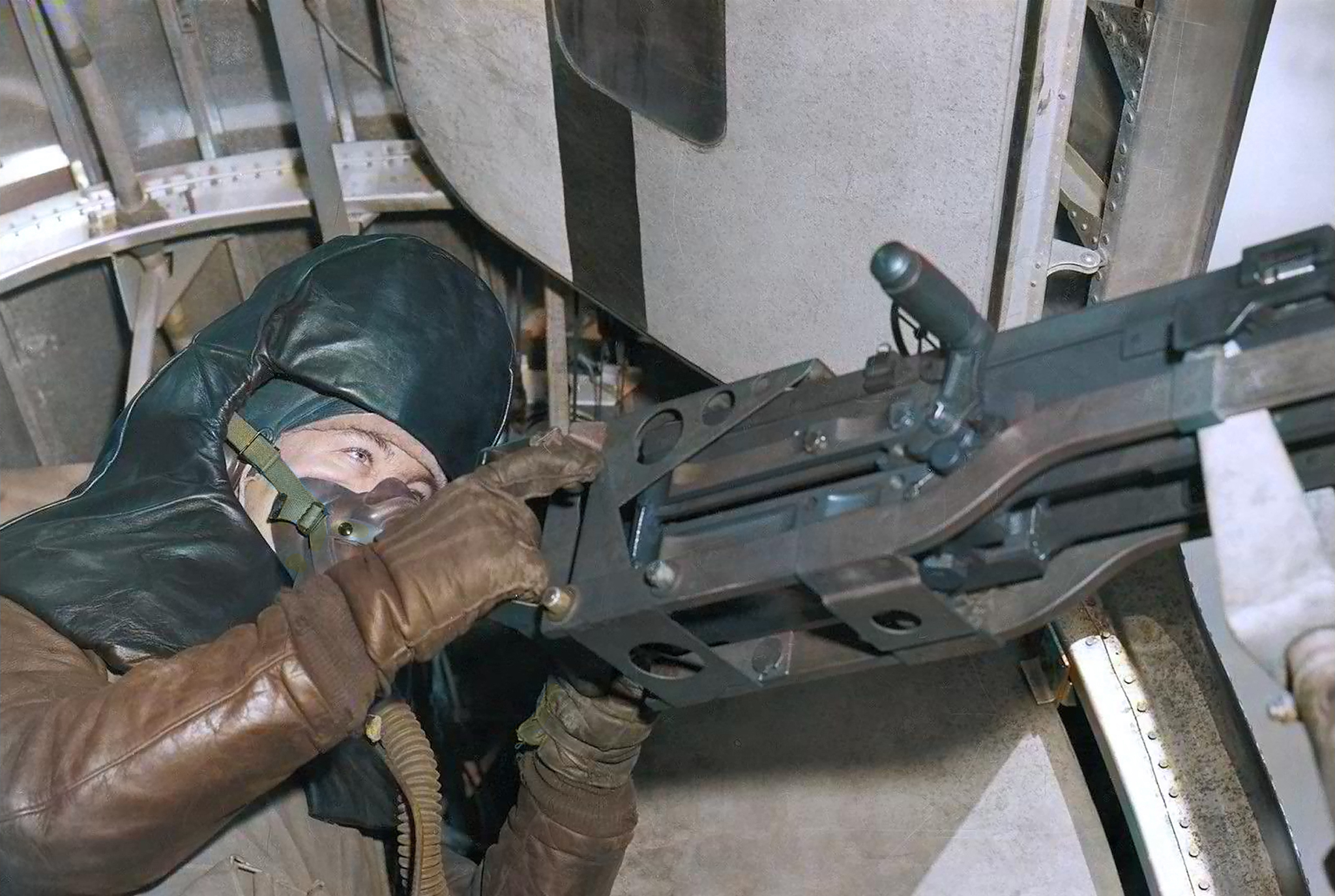
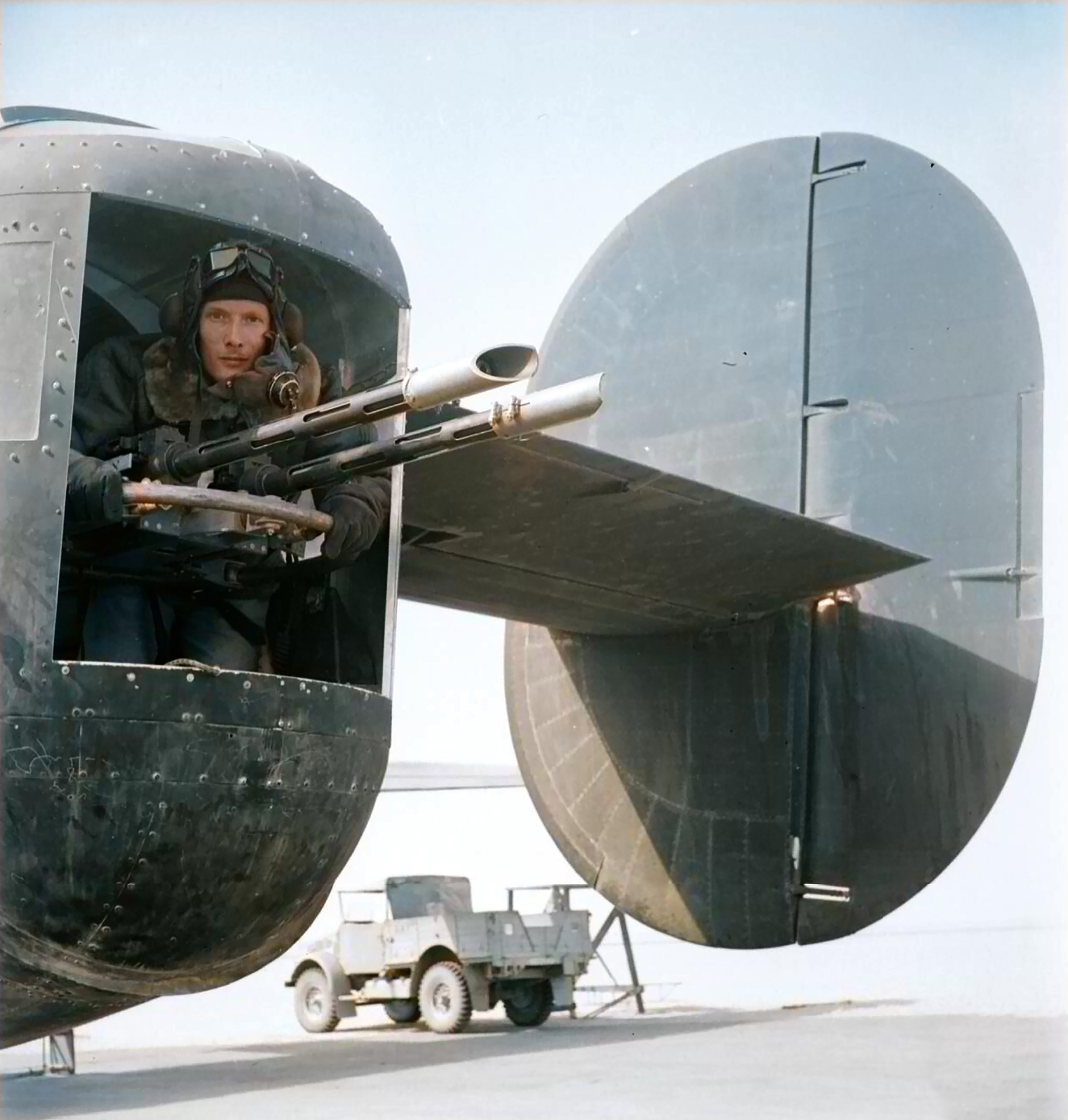

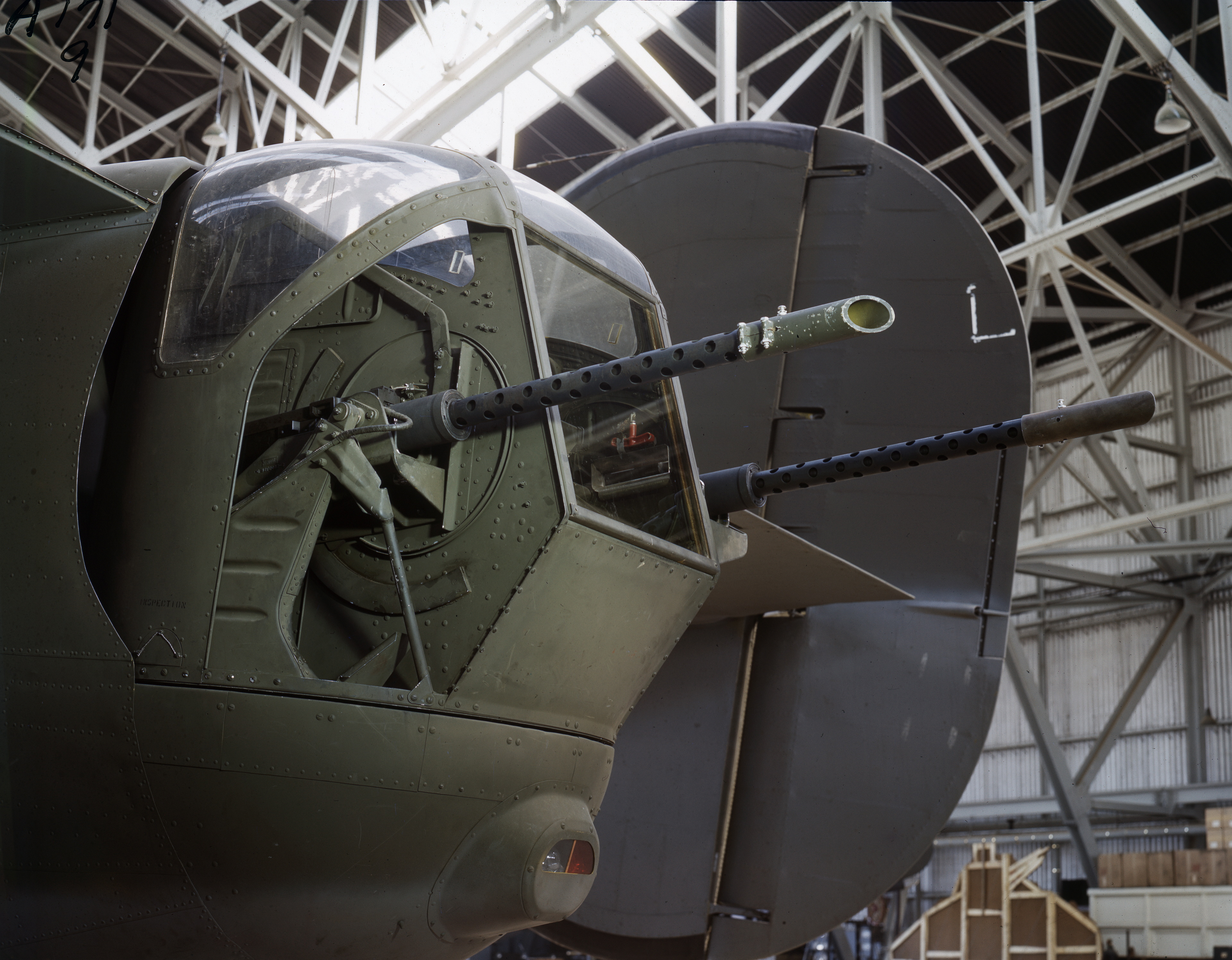
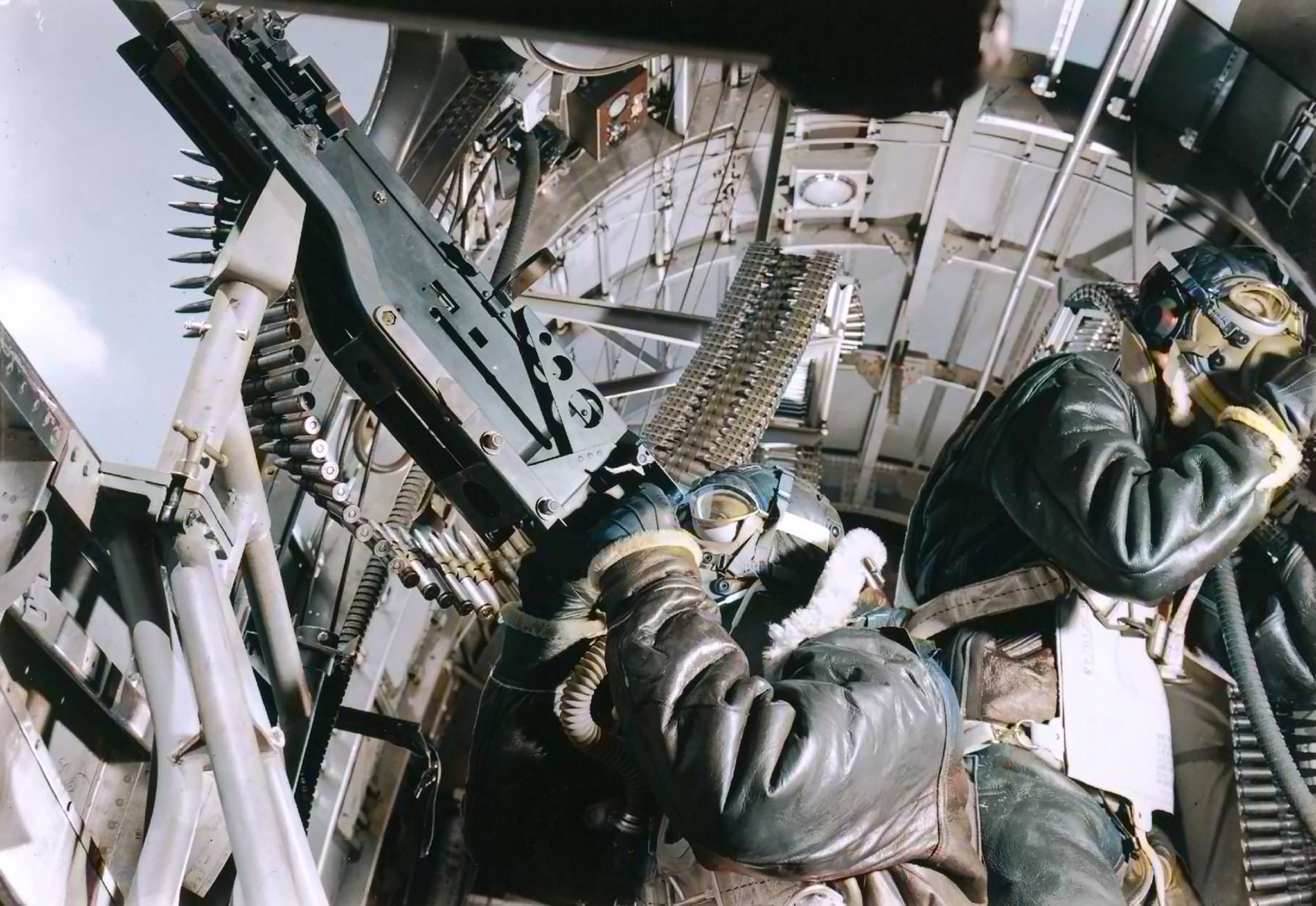
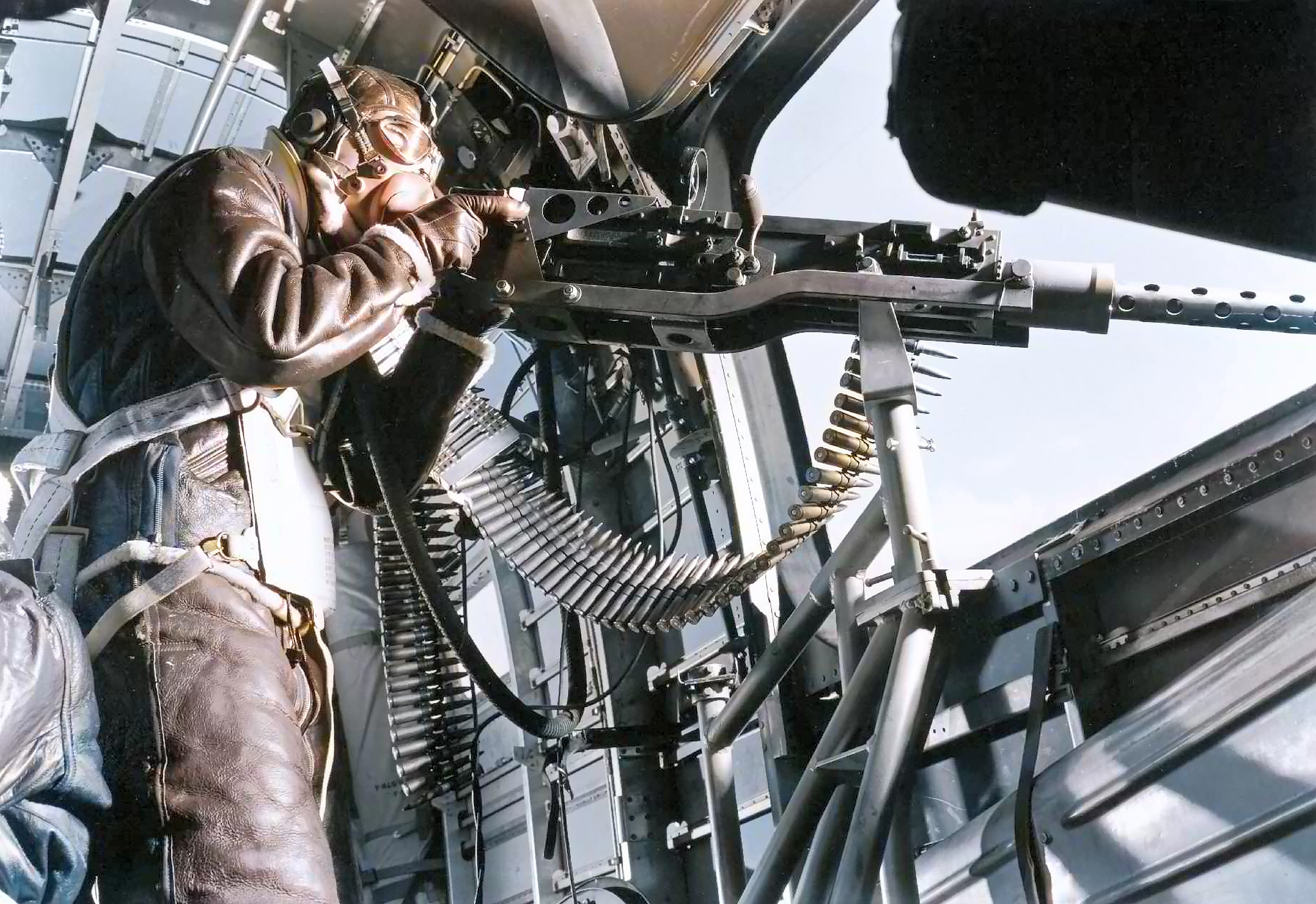
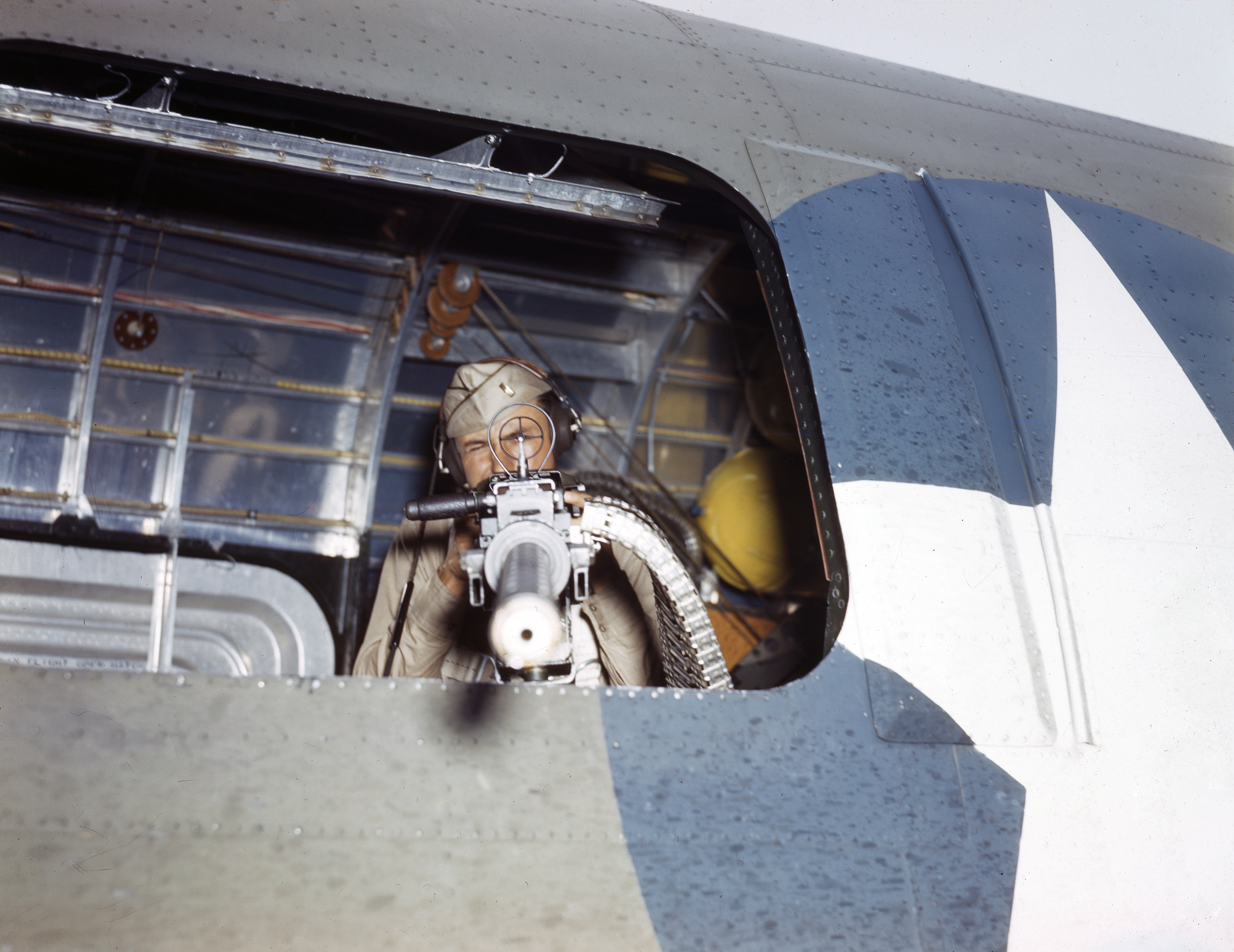
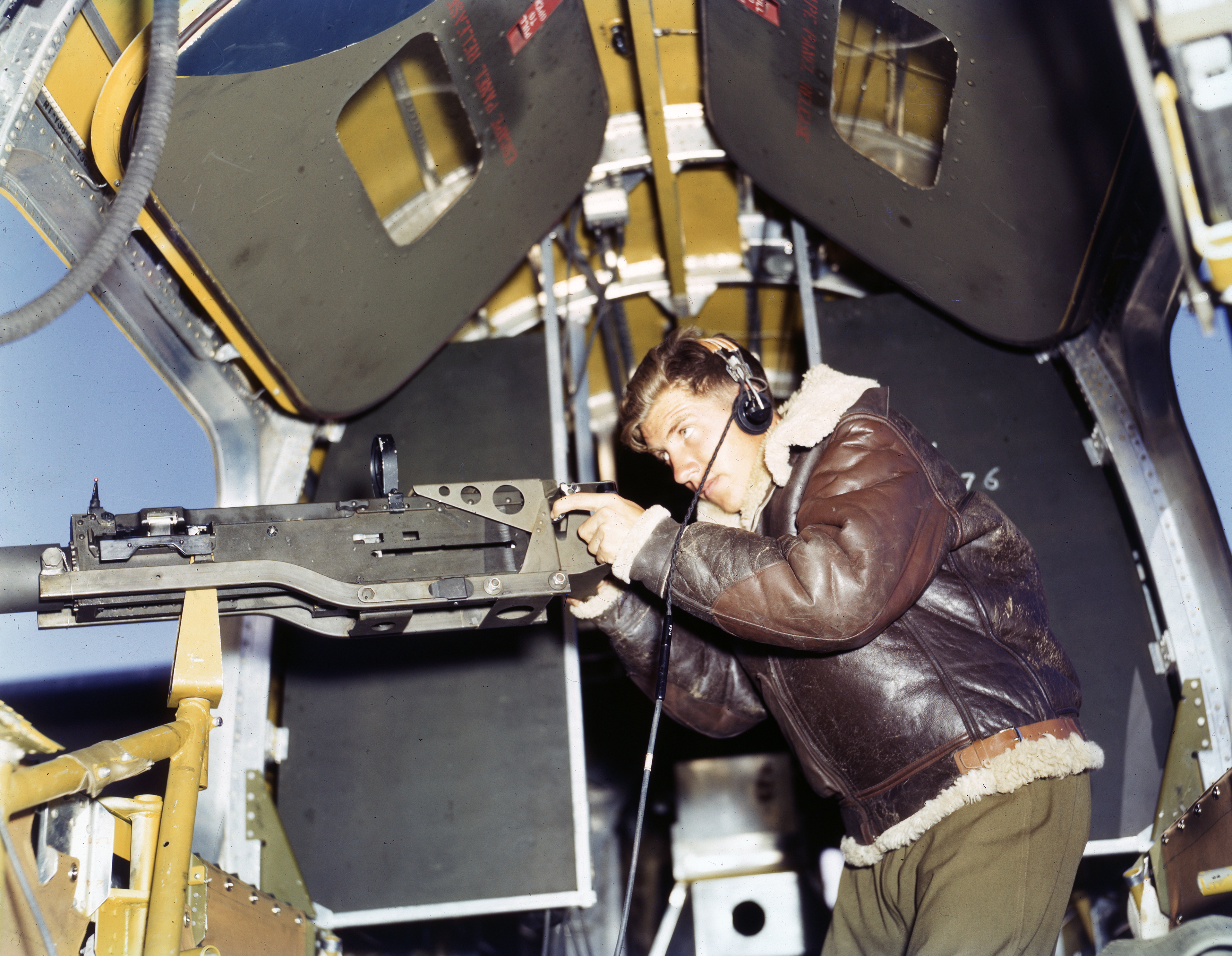
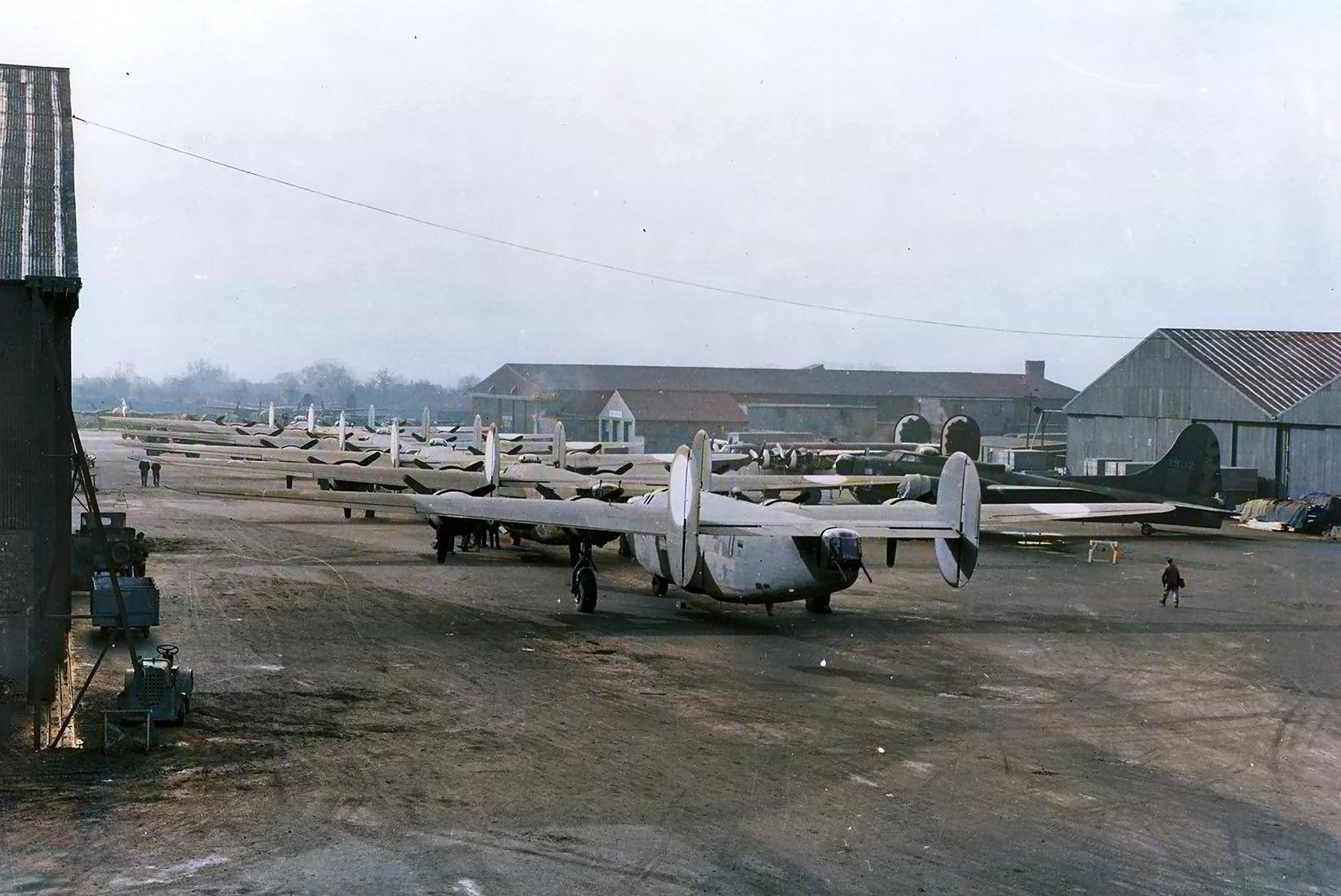
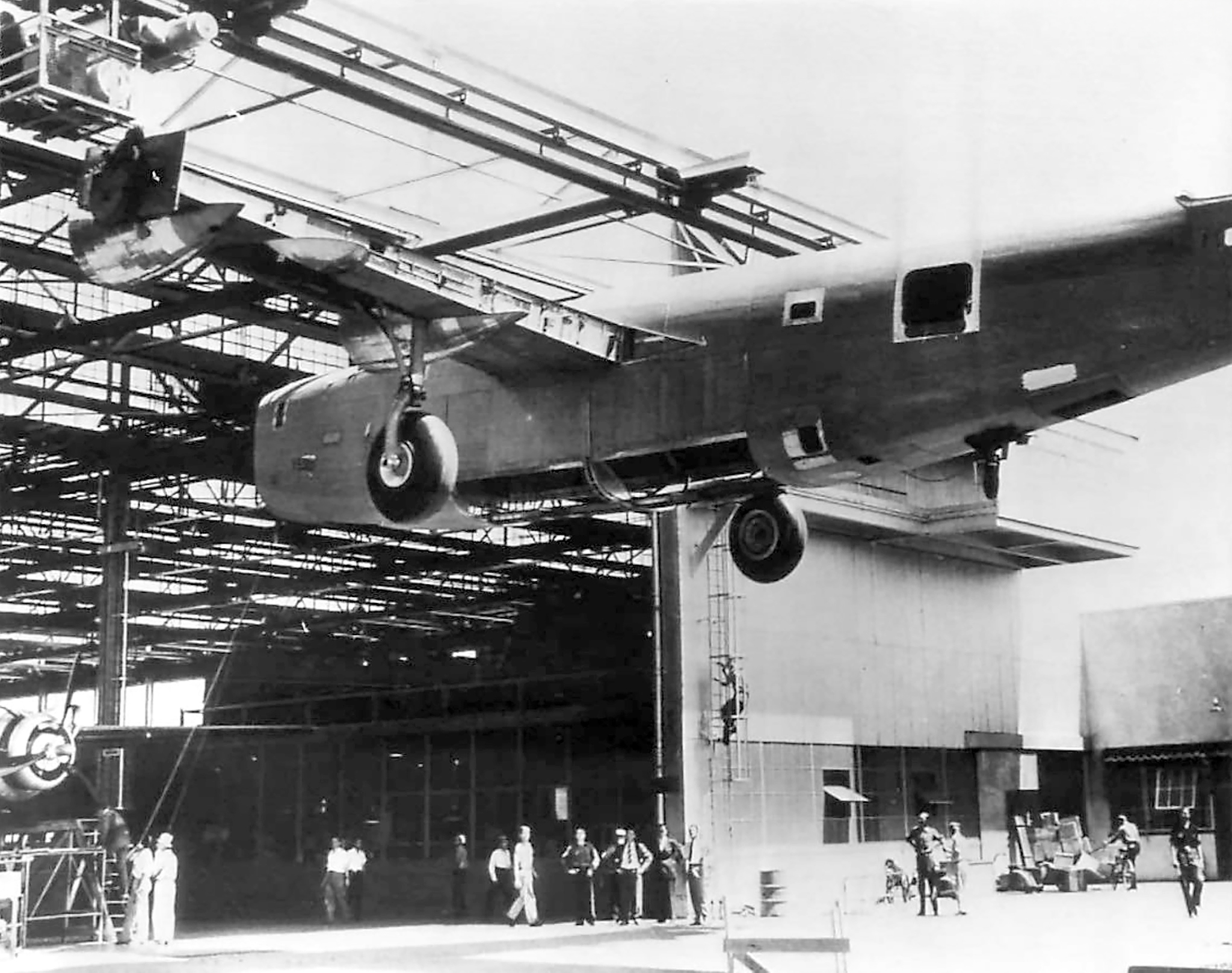

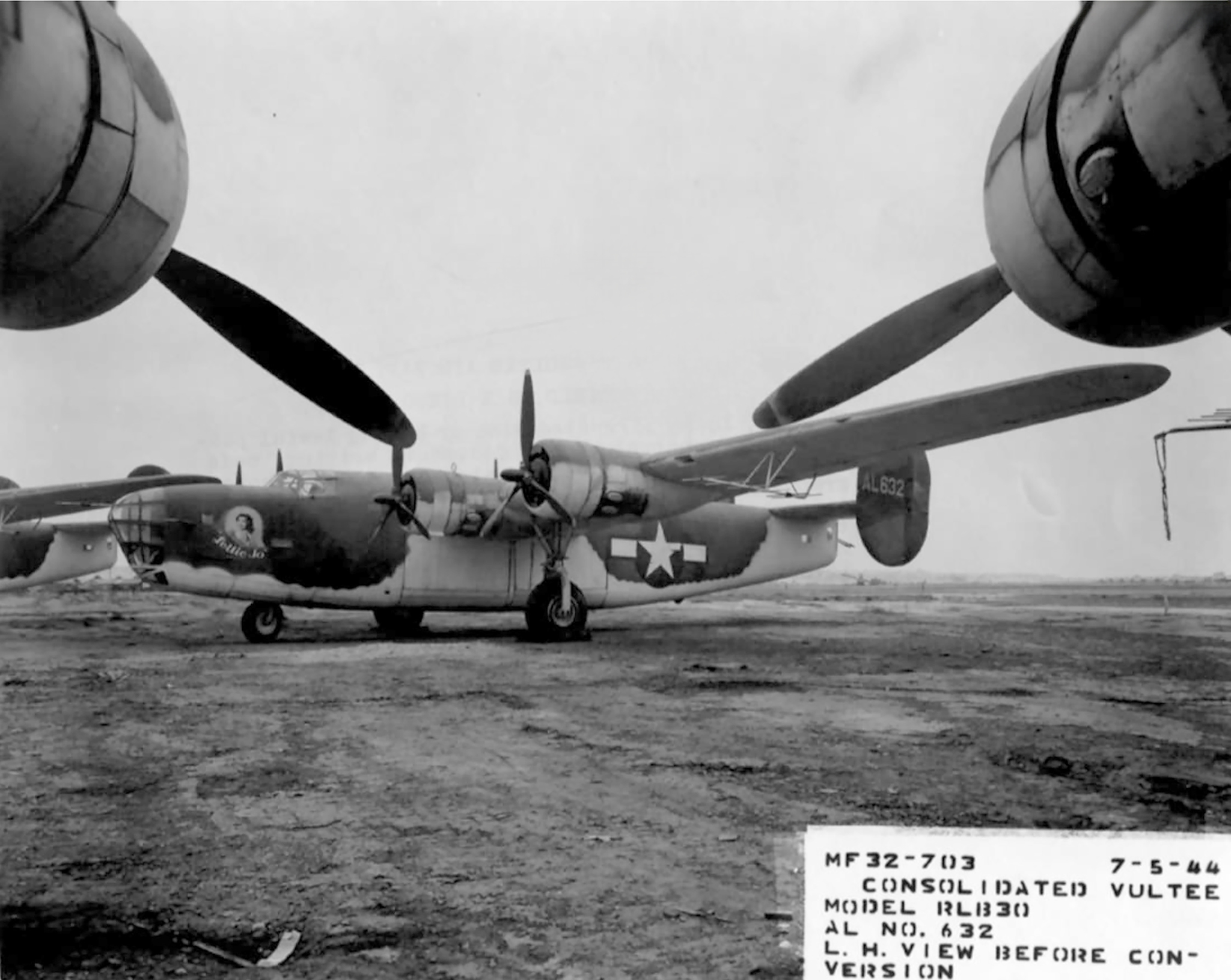


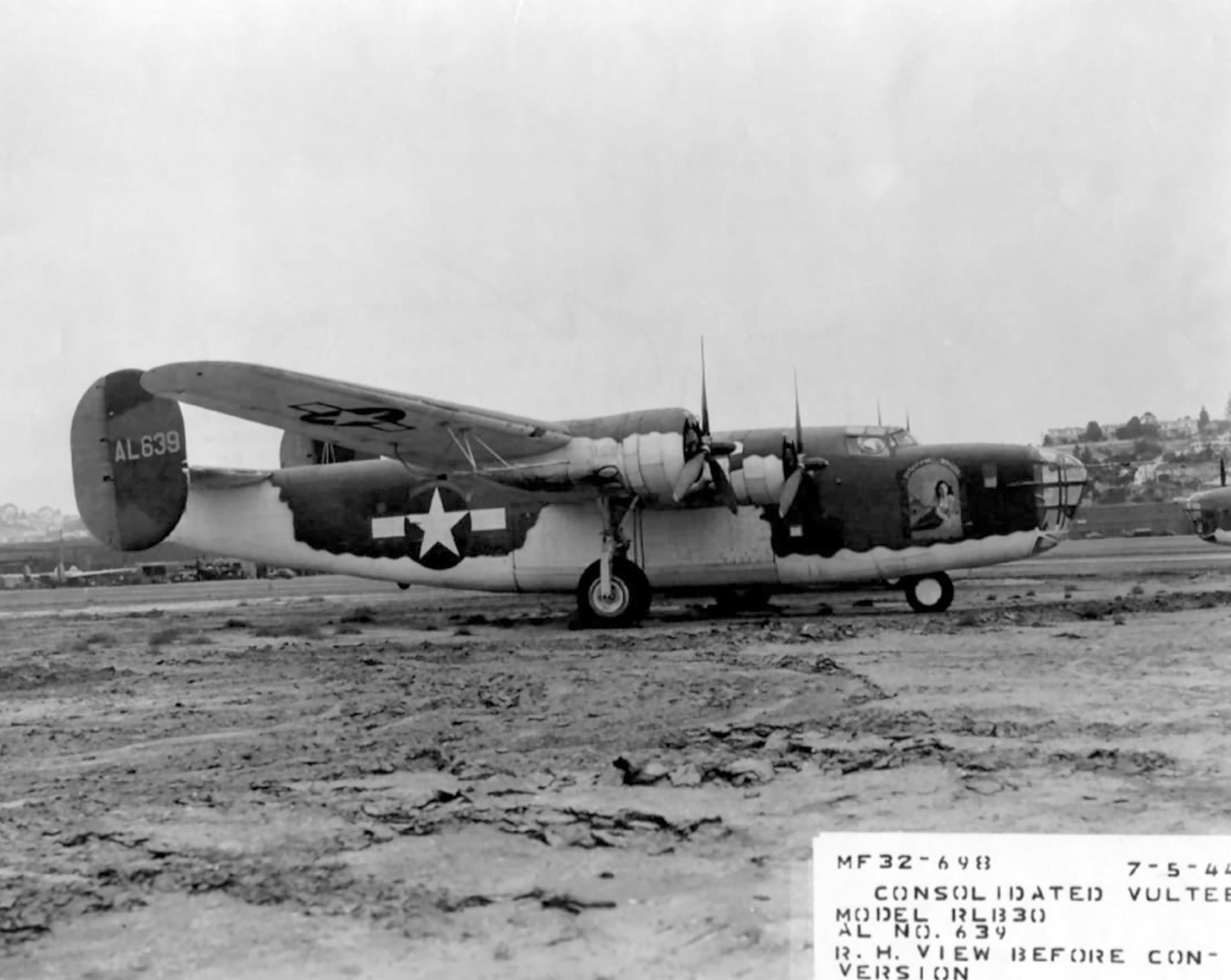

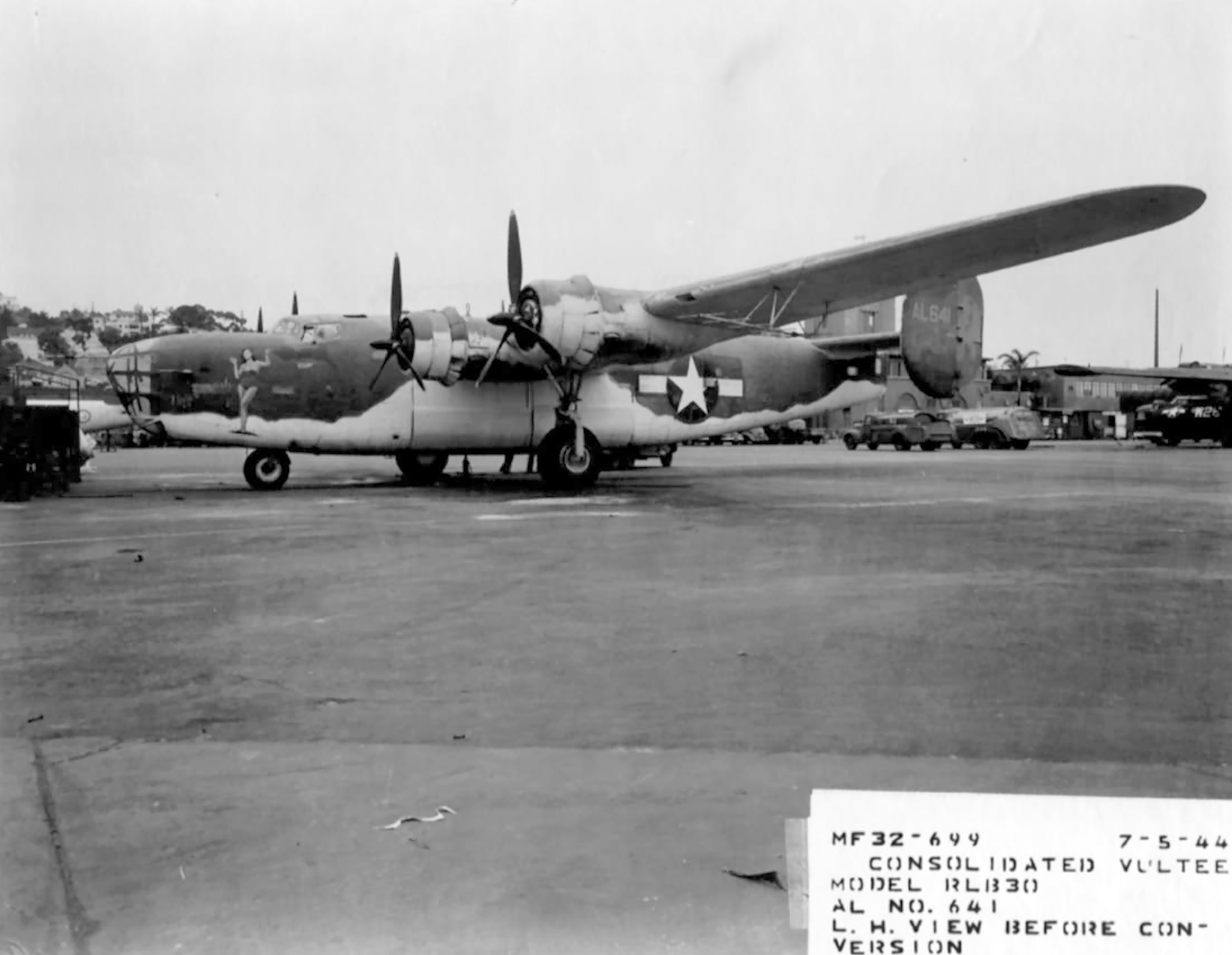
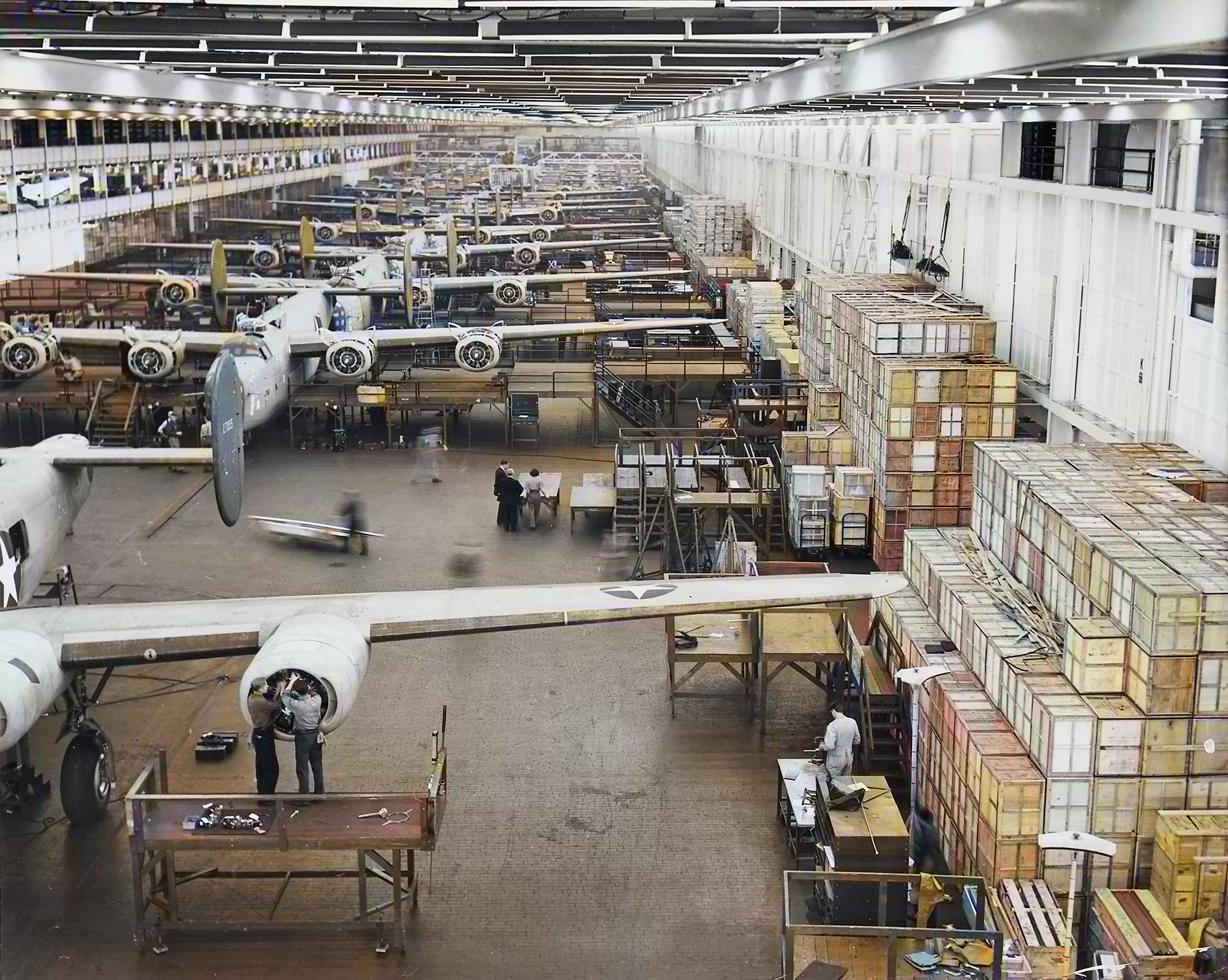

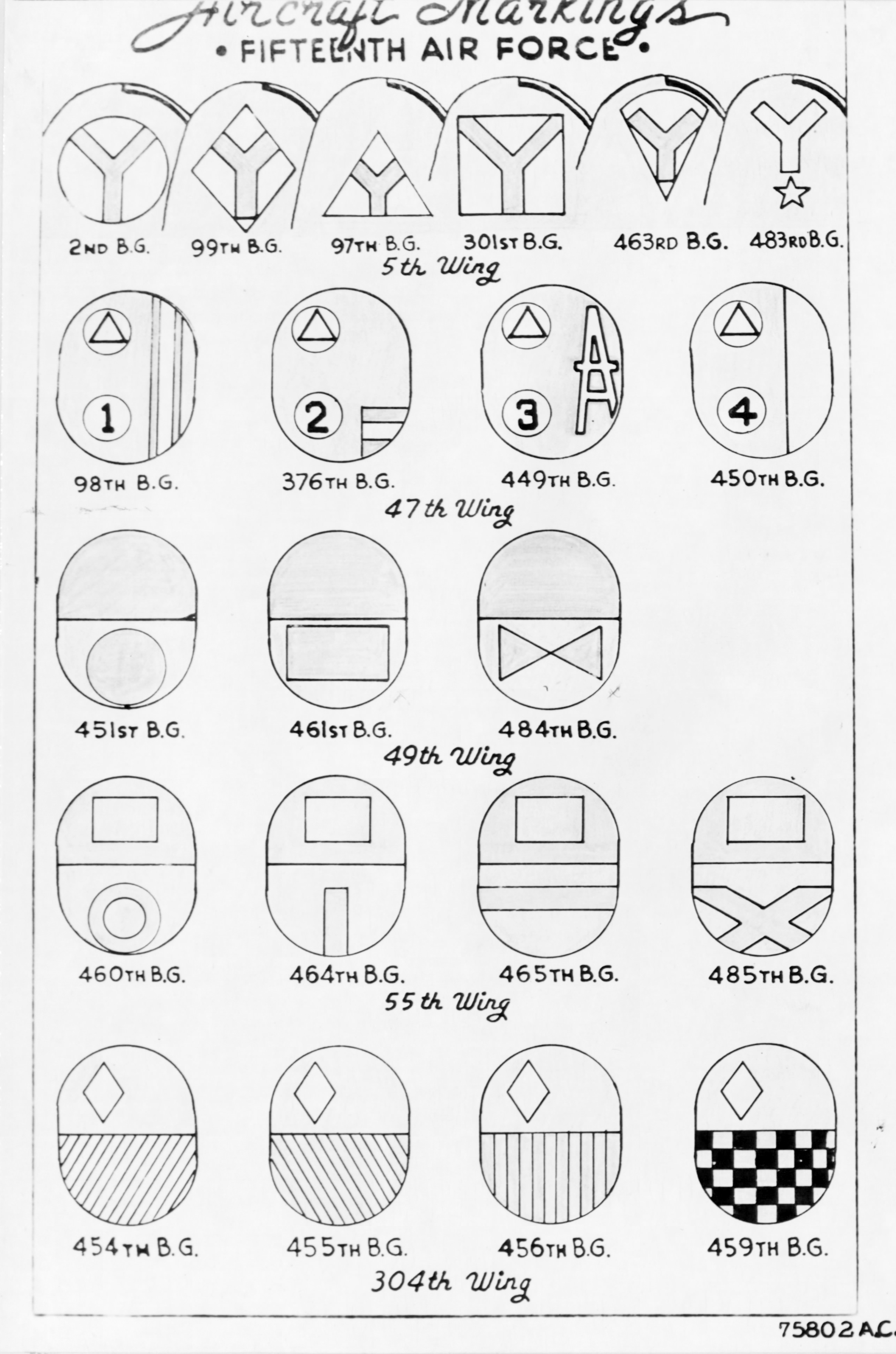


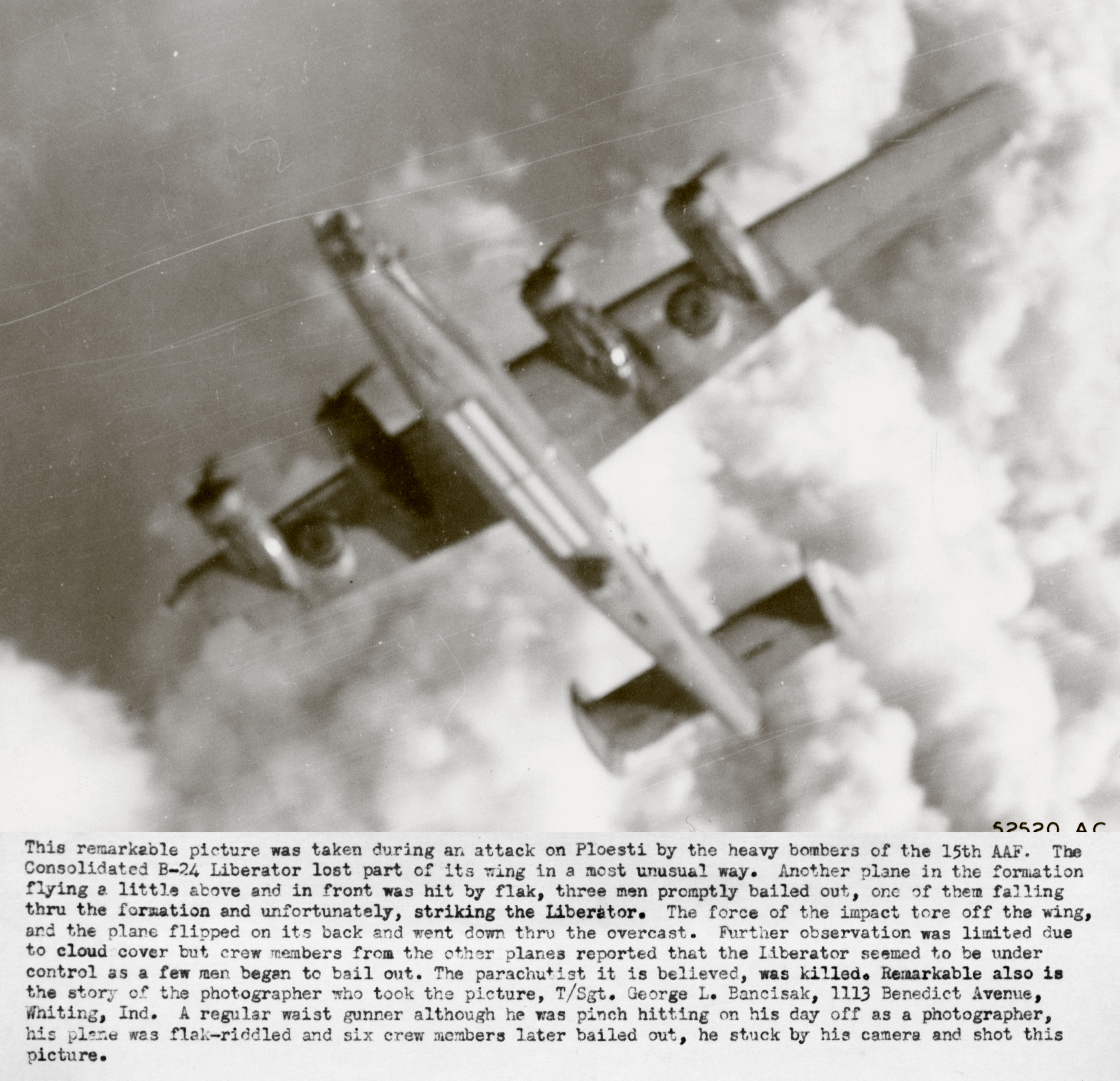
-between-the-major-Allies-of-WWII-took-place-from-12th-to-17th-Aug-1942-01.jpg)
-Eloise-Huffines-Bailey,-Millie-Davidson-Dalrymple,-Elizabeth-McKethan-Magid-and-Clara-Jo-Marsh-Stember.jpg)

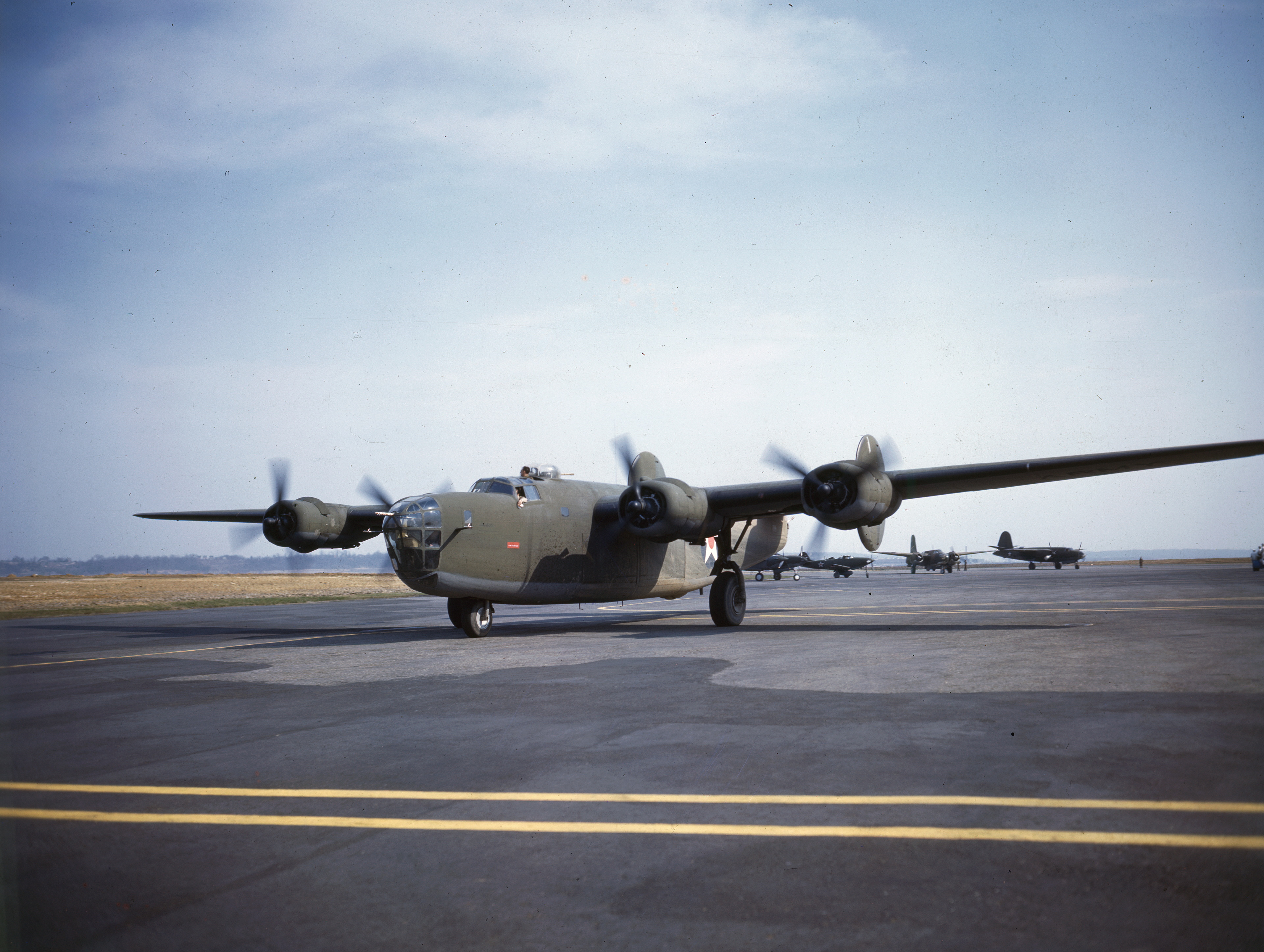
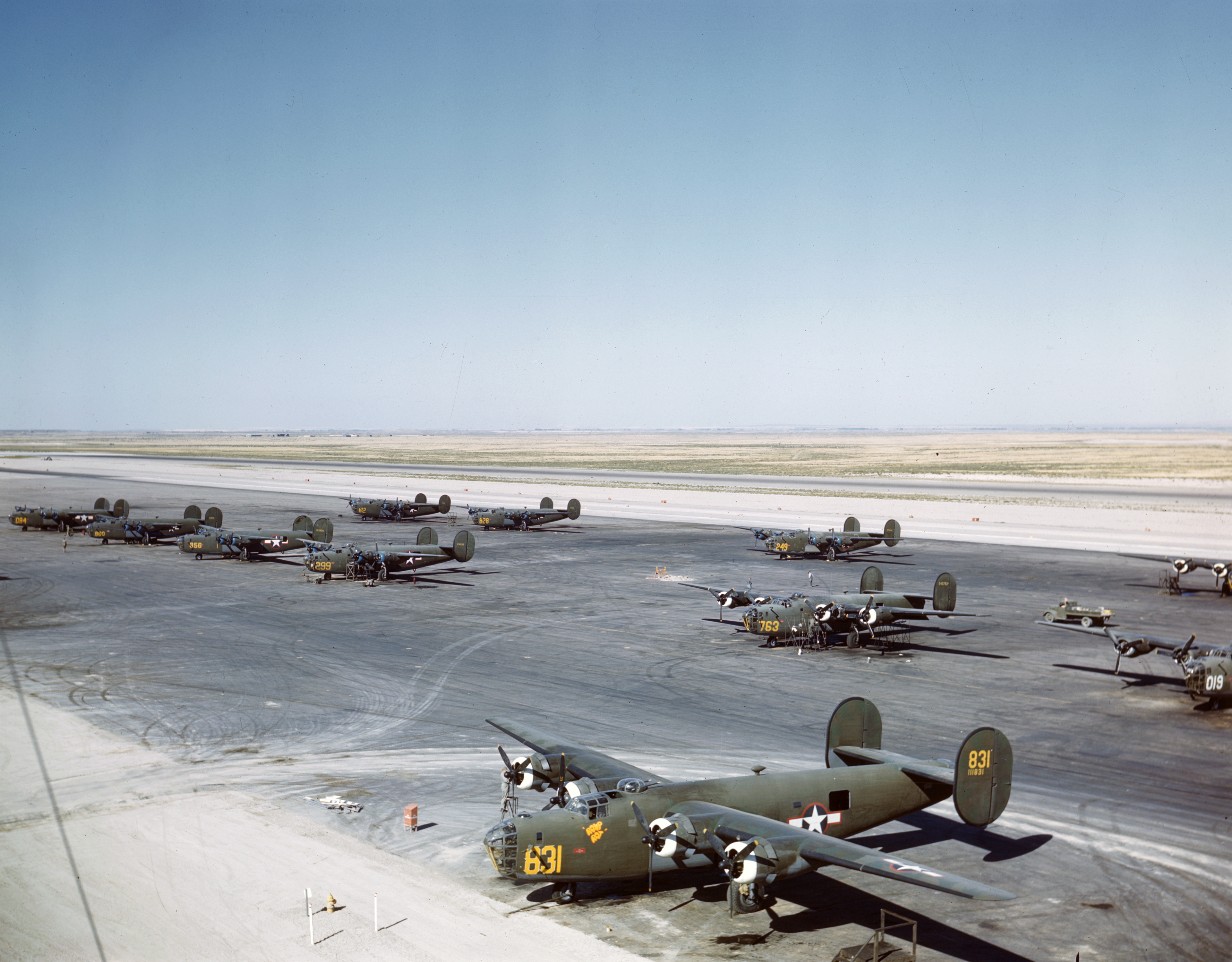
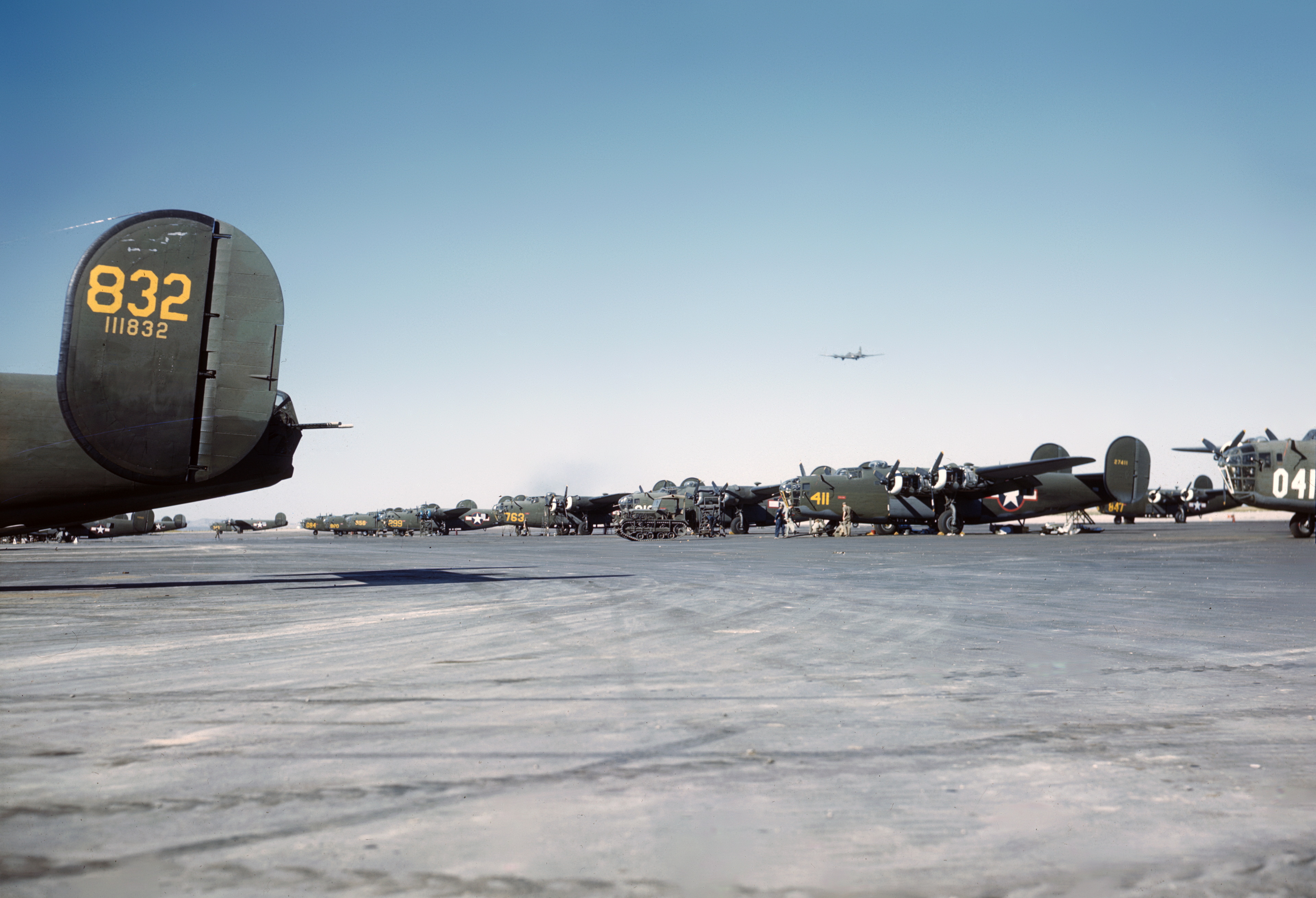
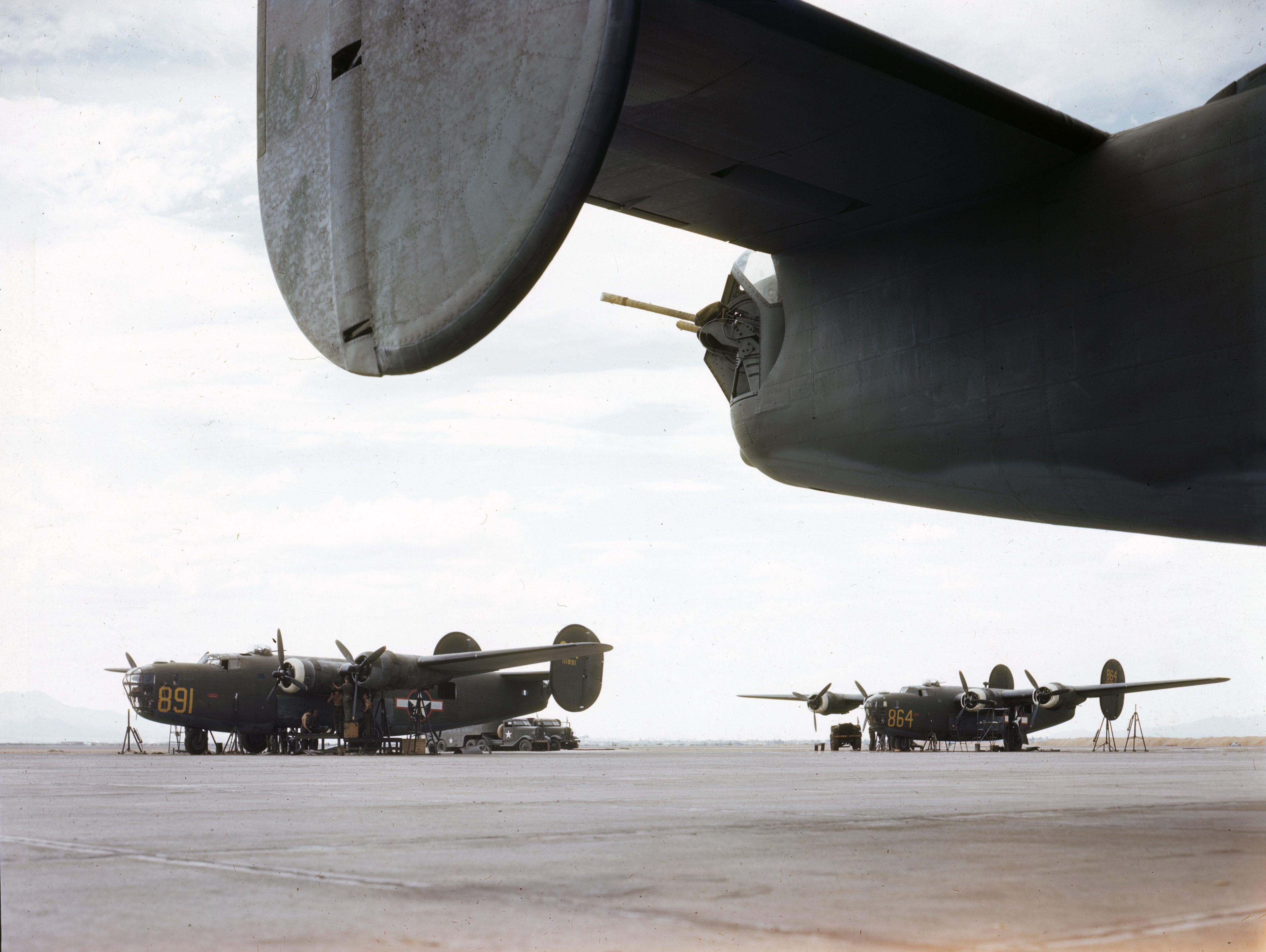
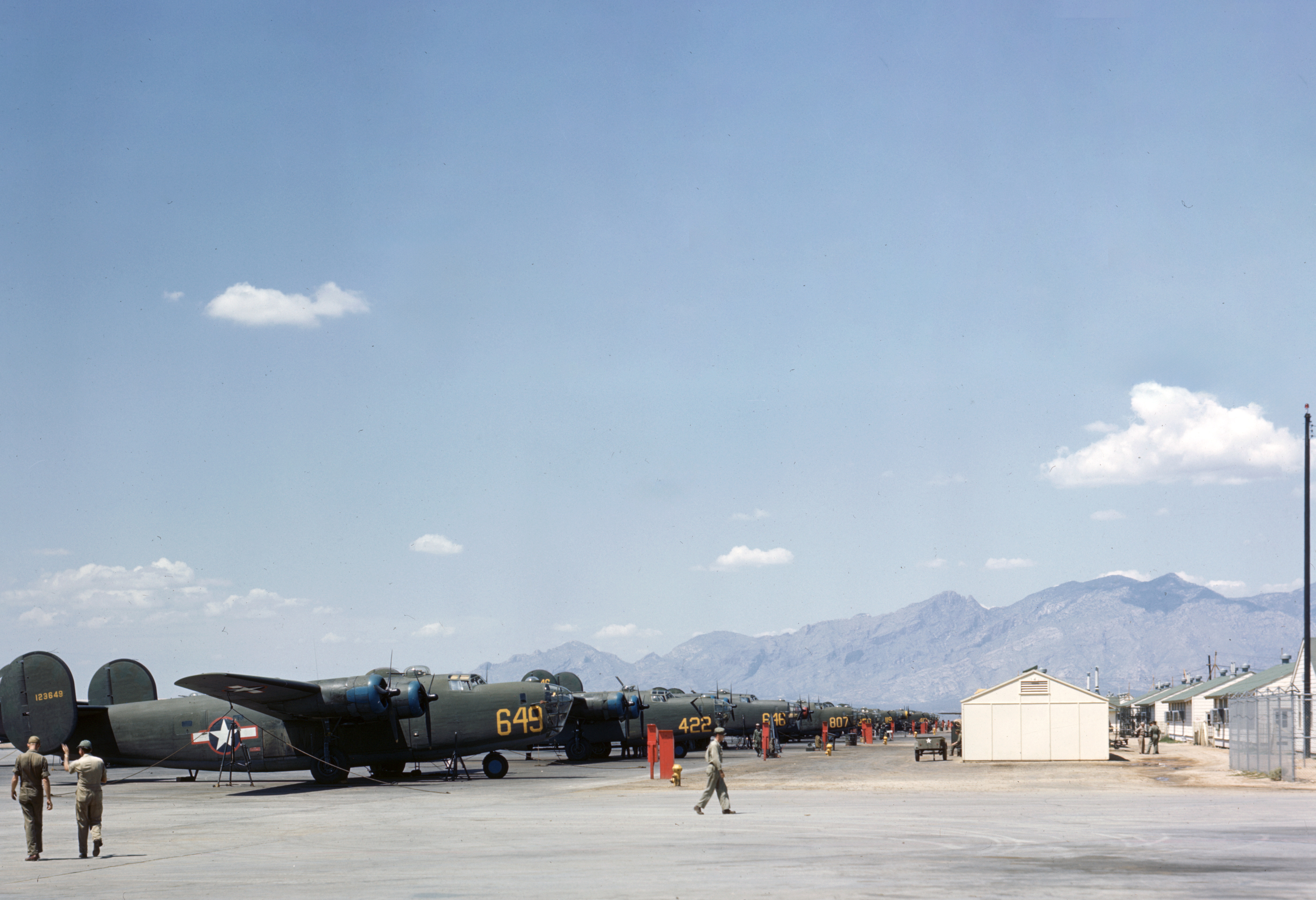
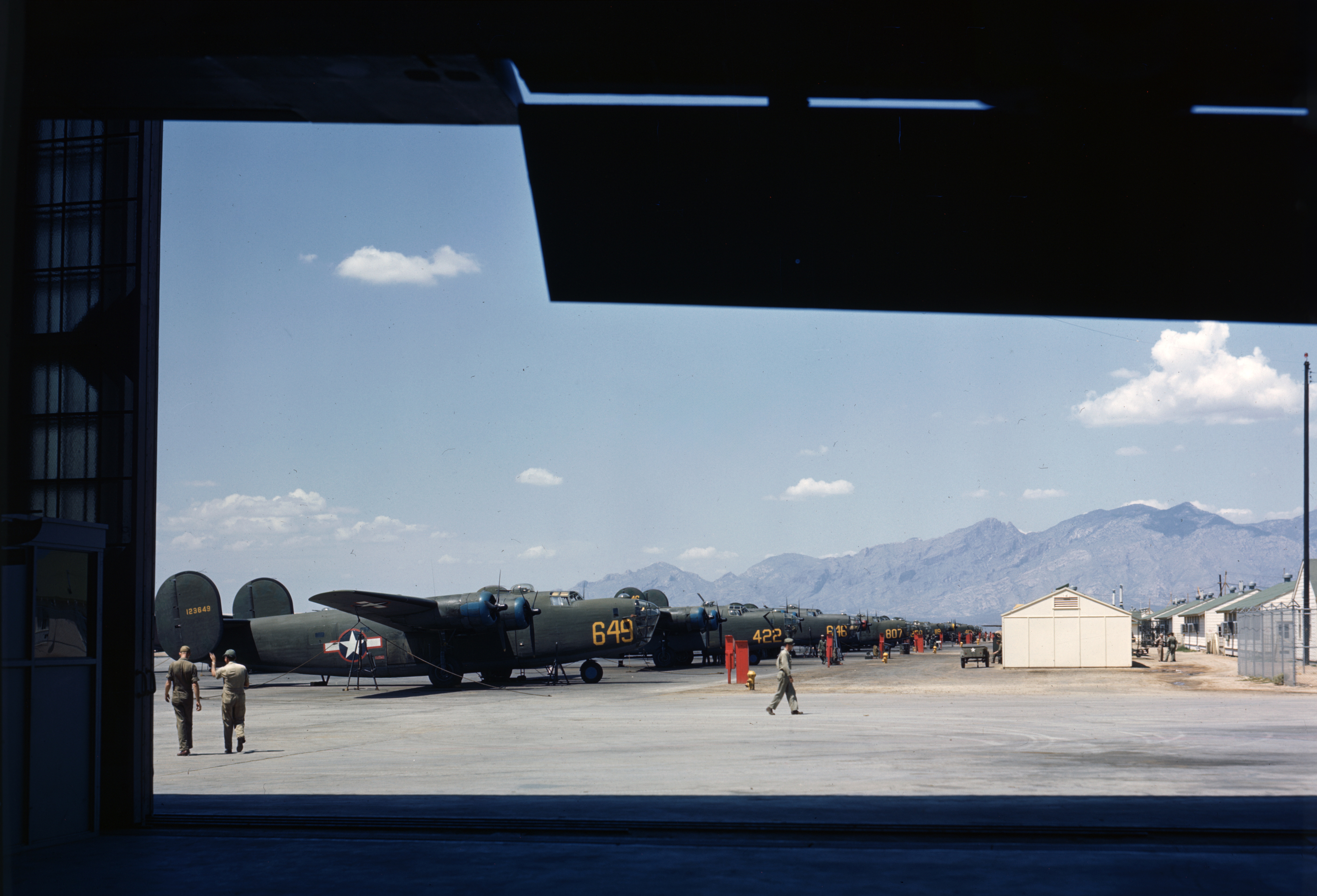

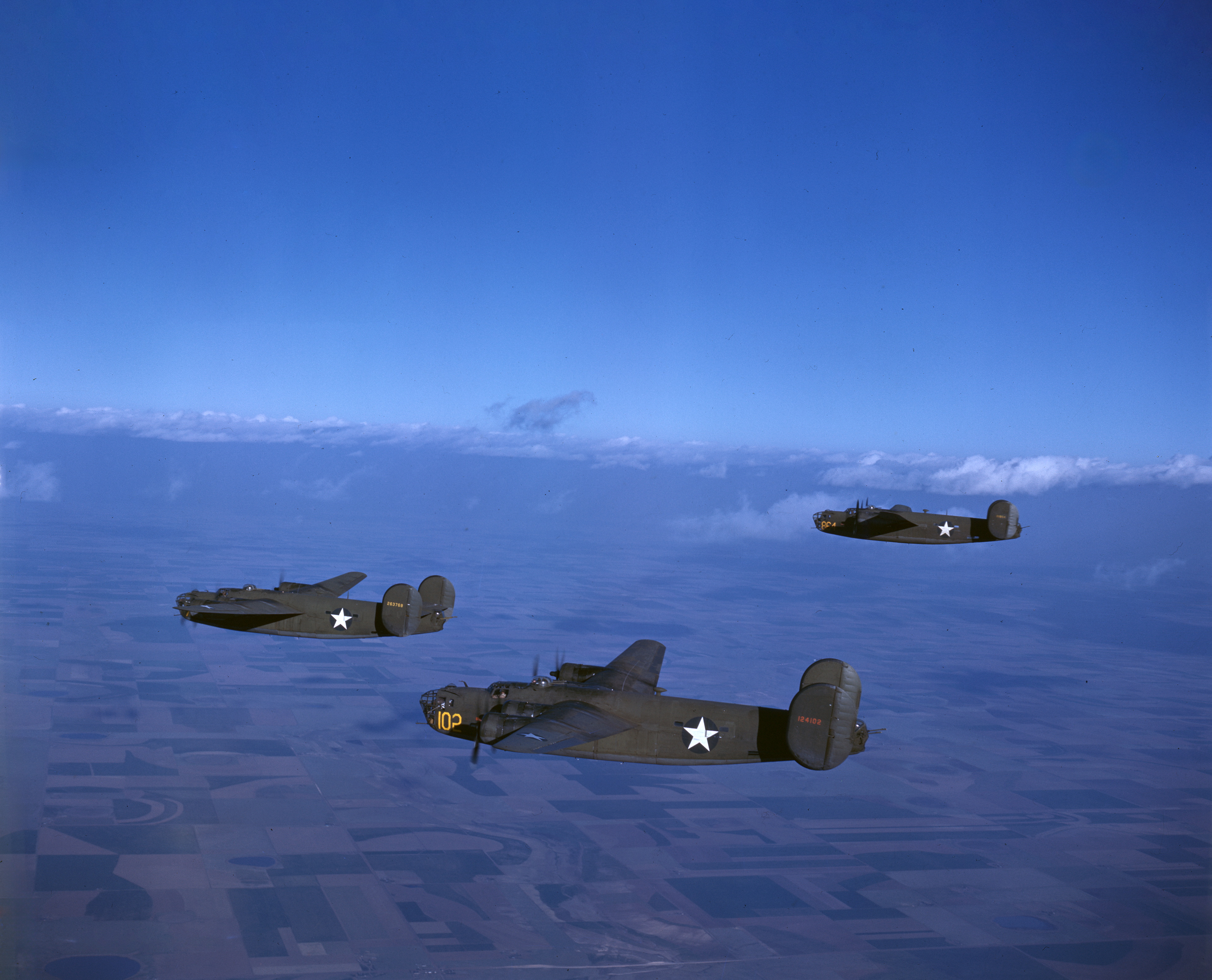
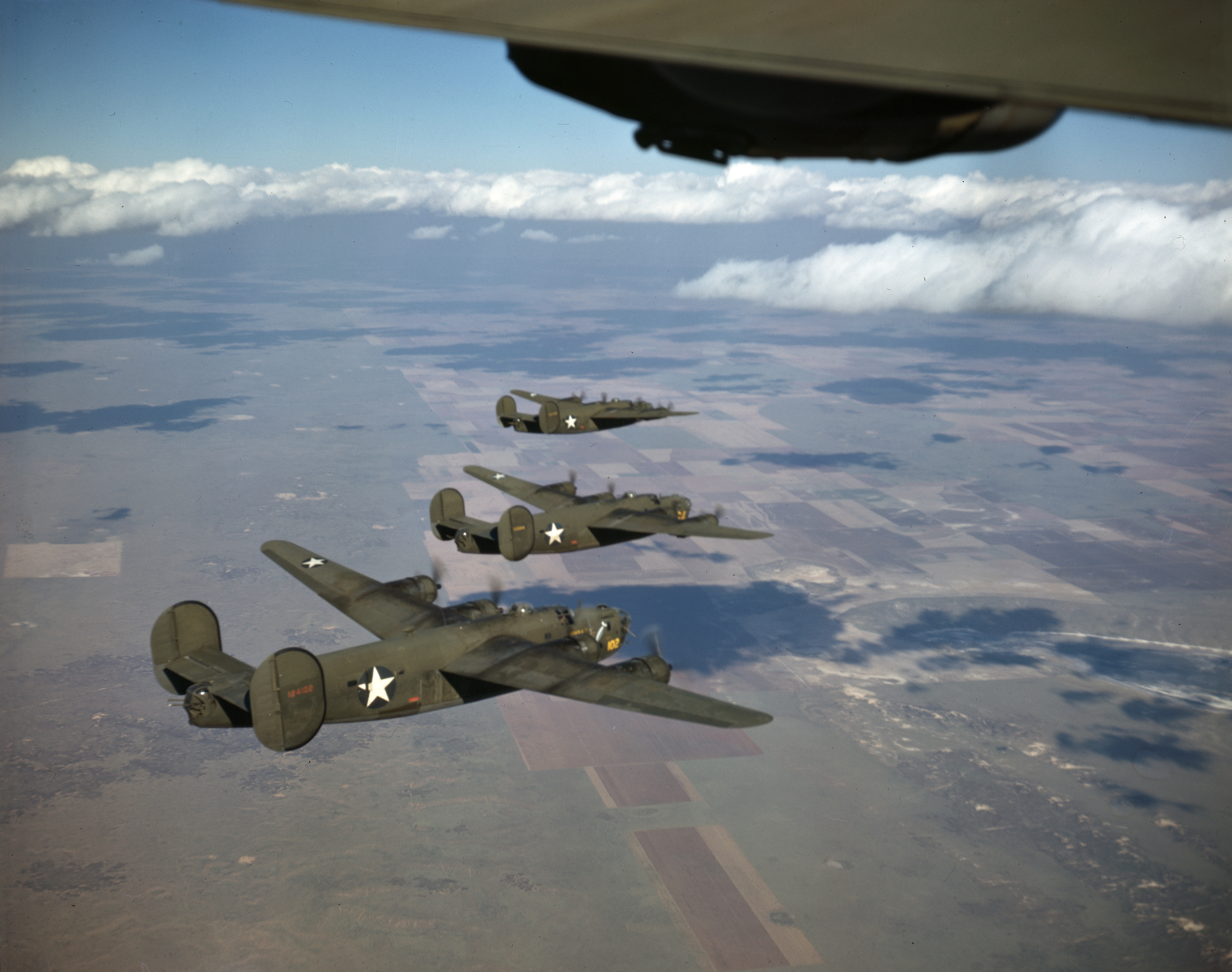
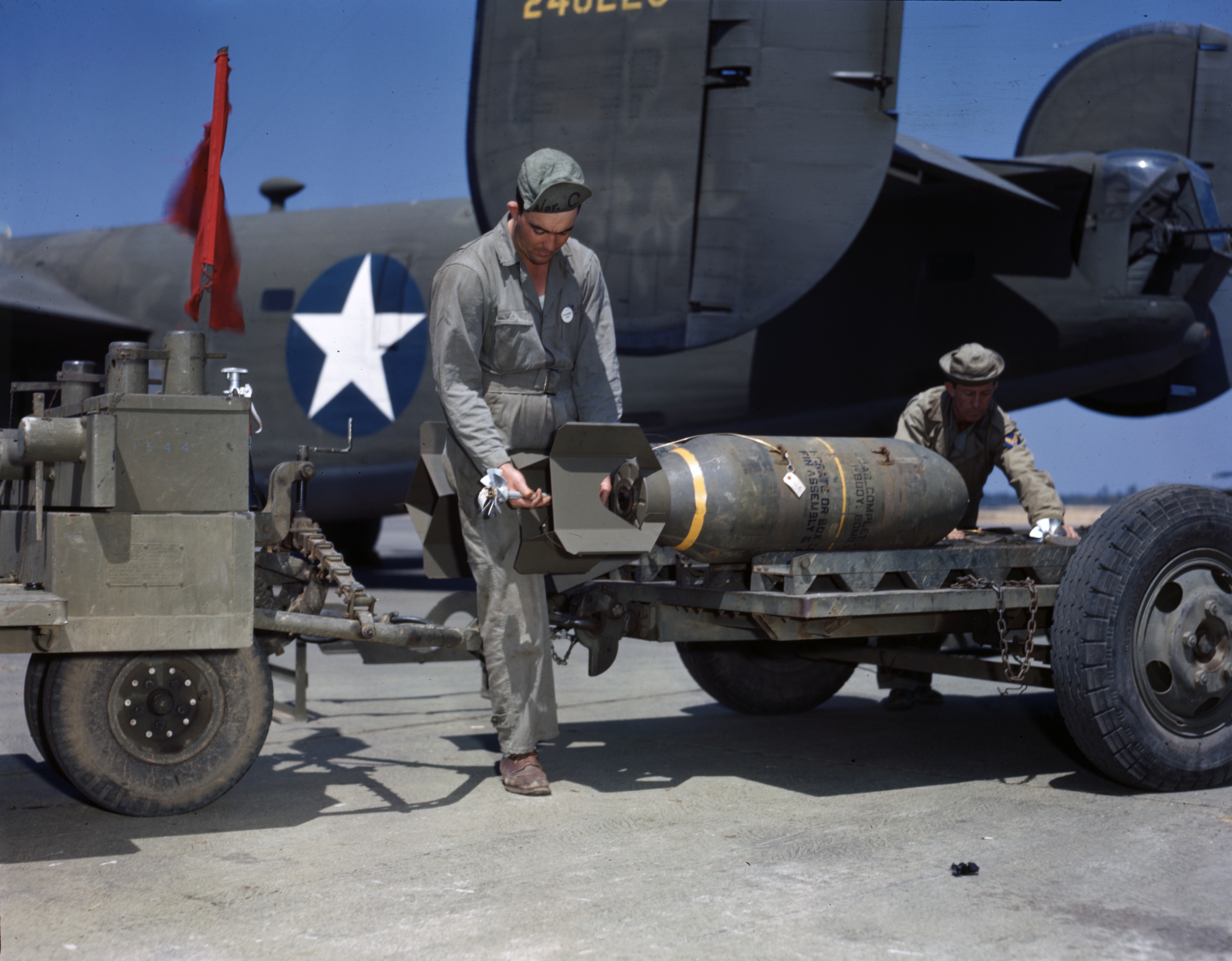
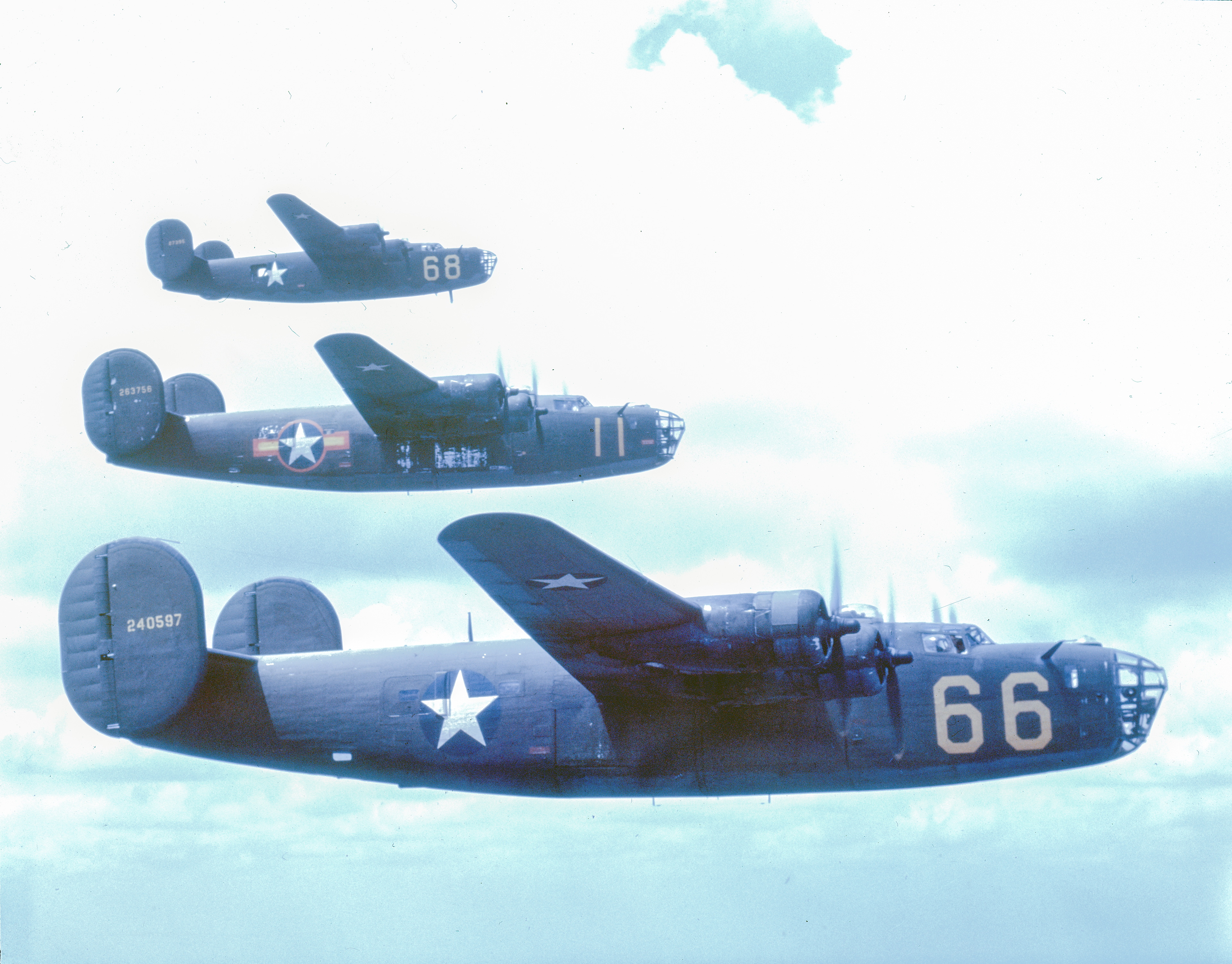
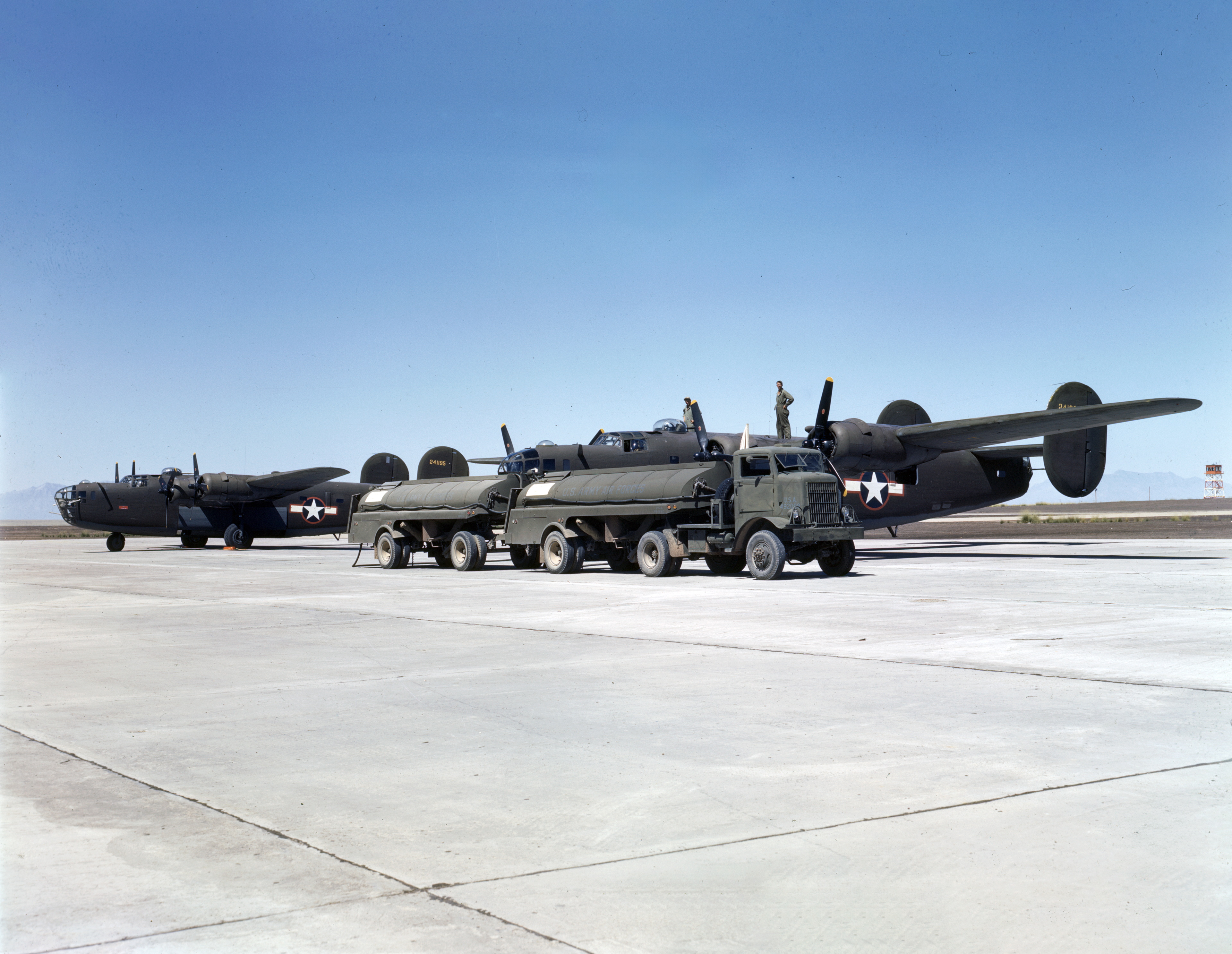
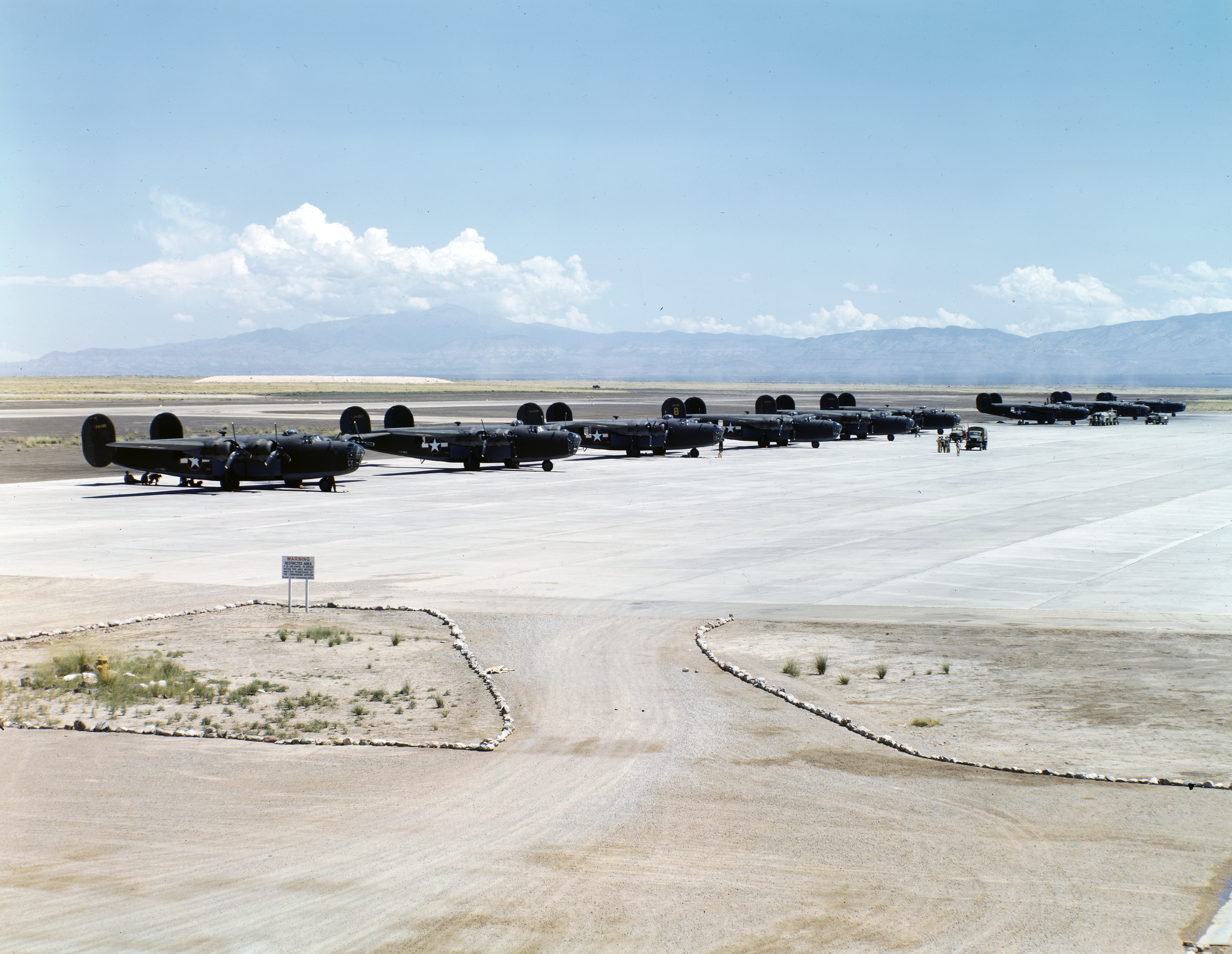

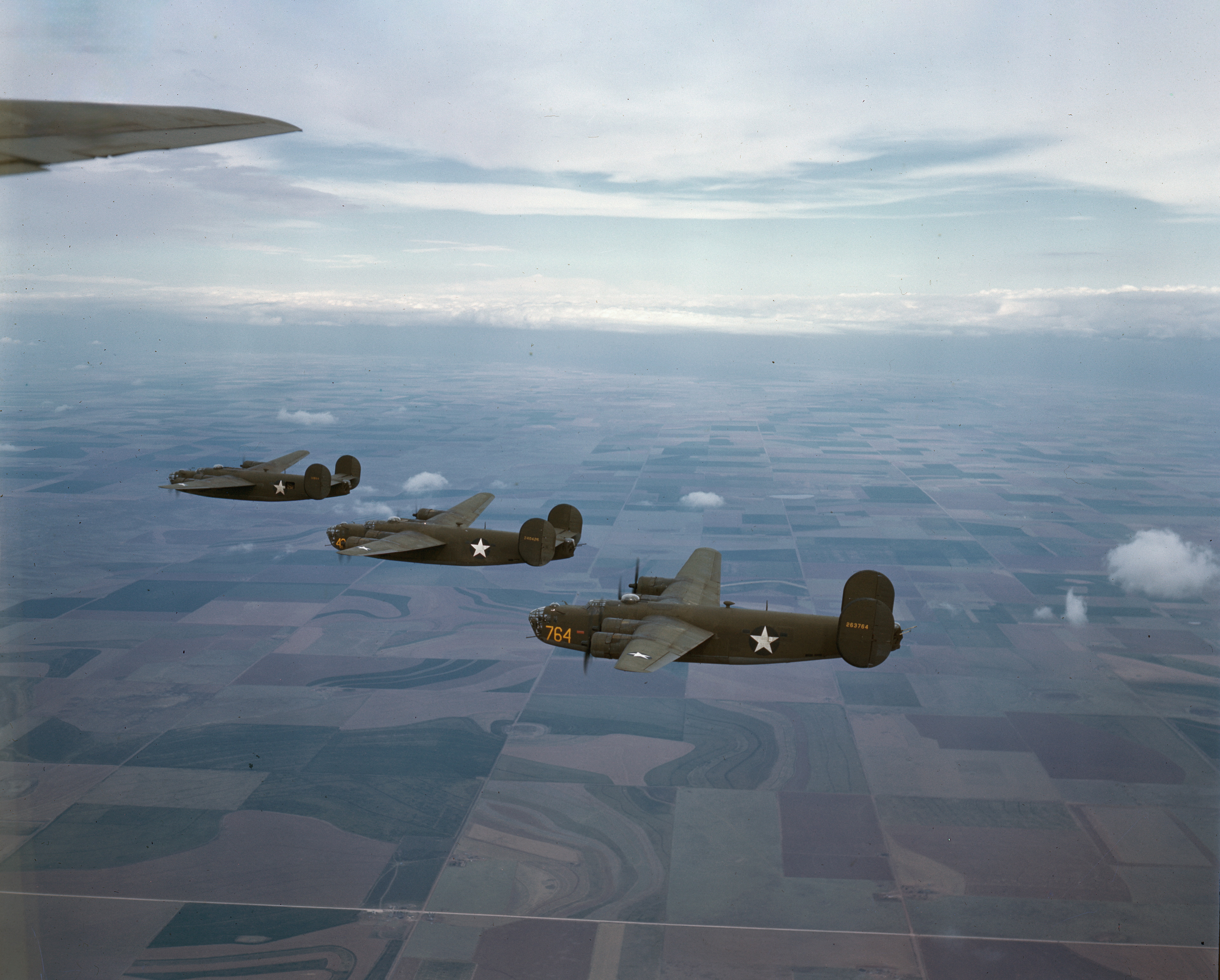
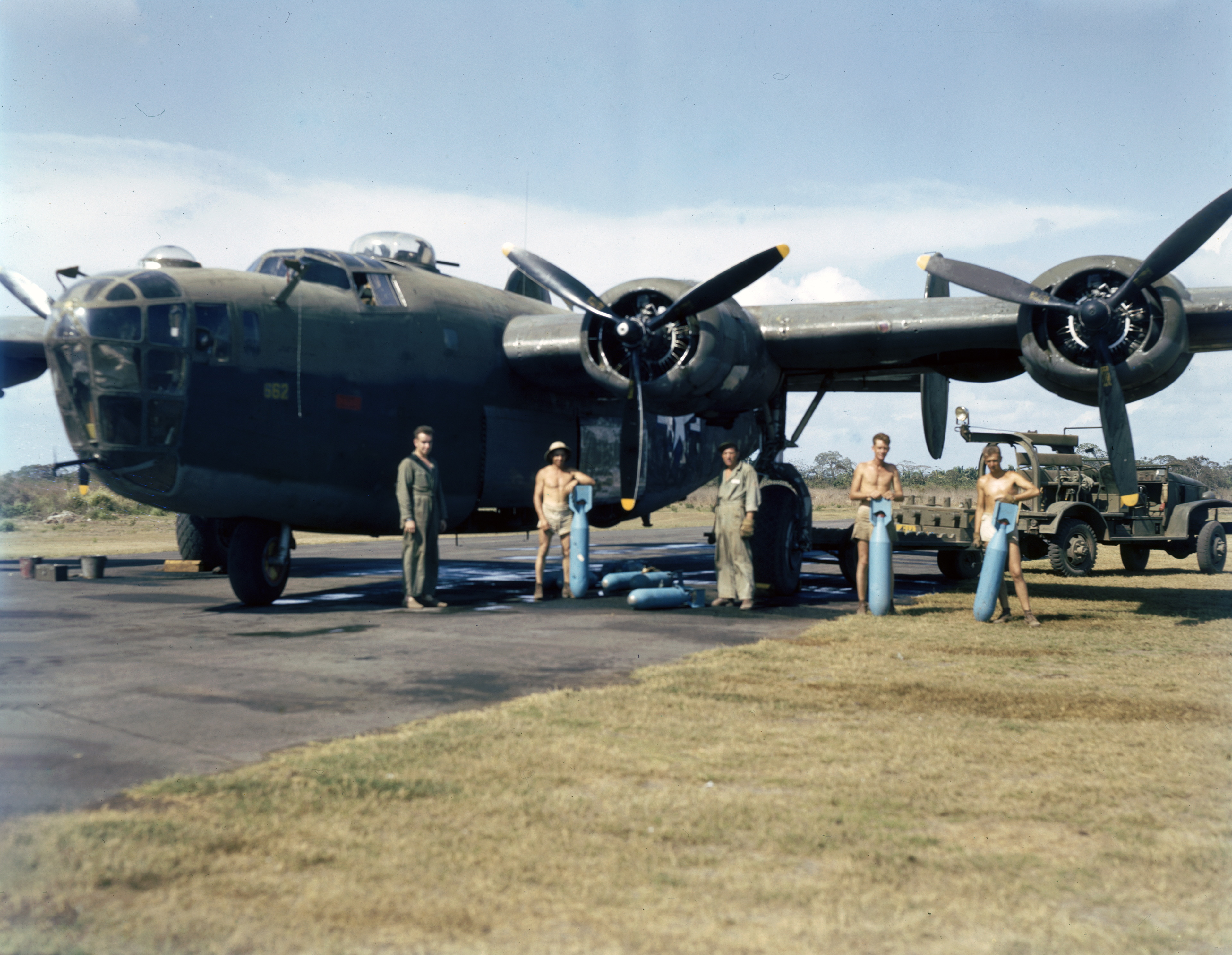
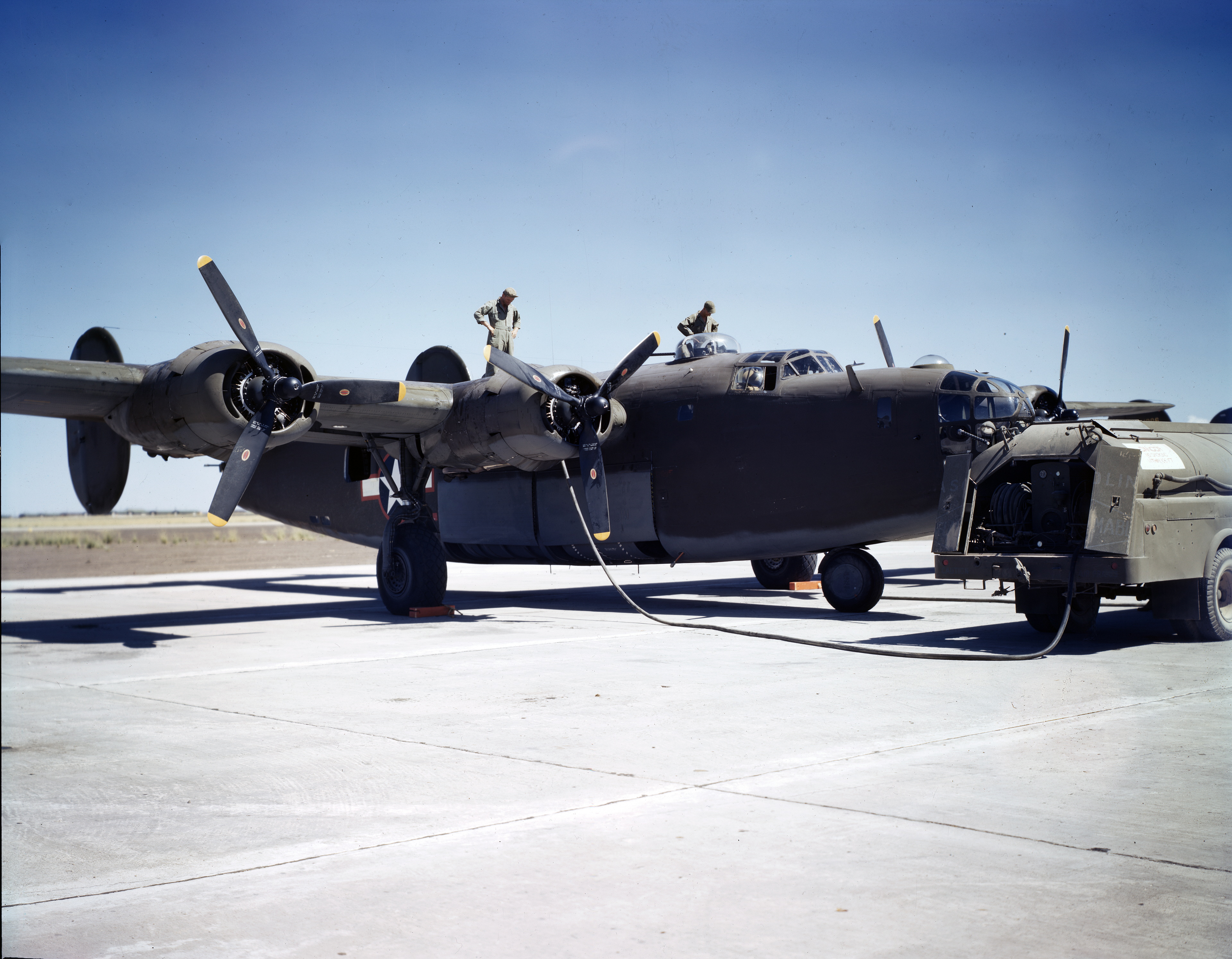

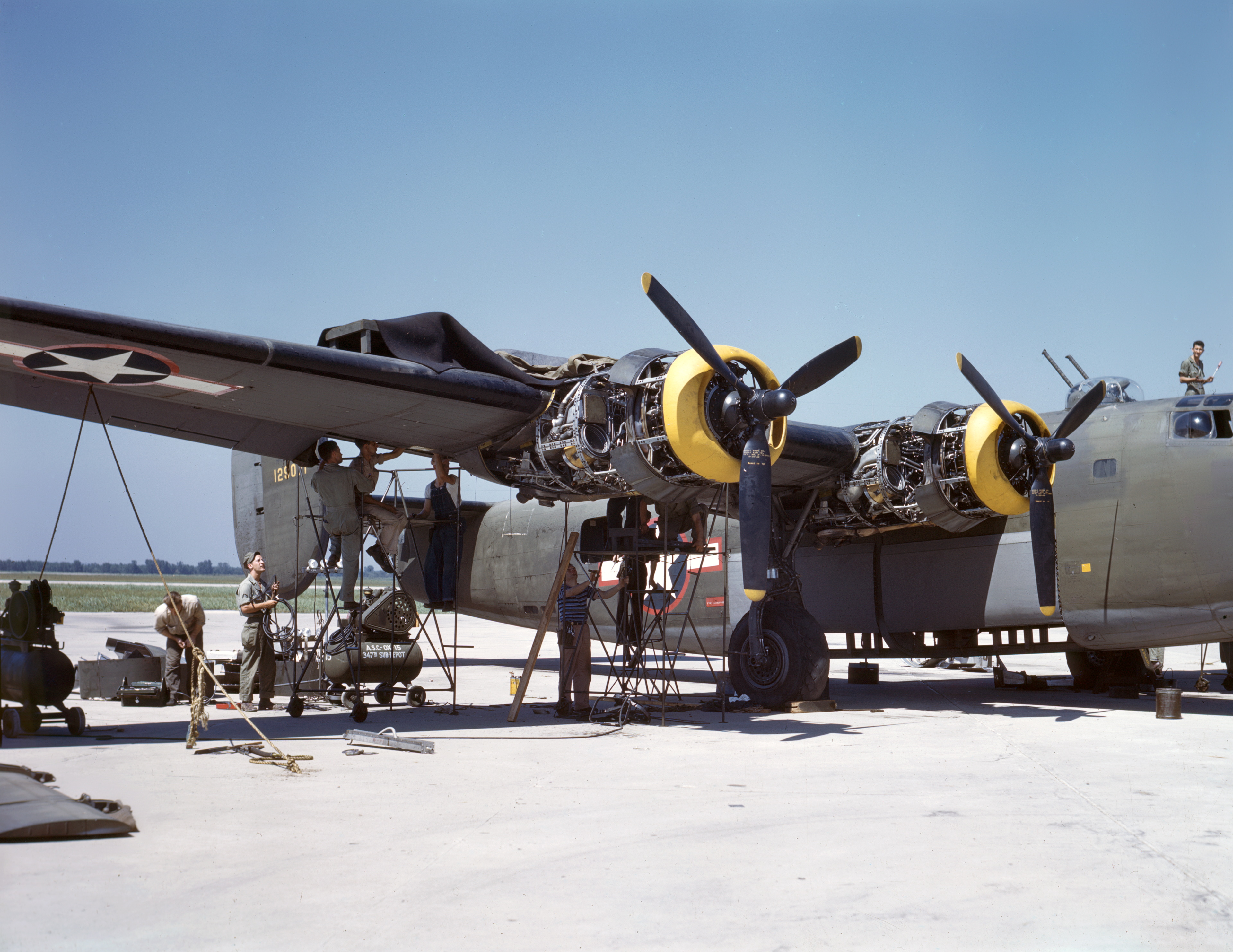
Consolidated B-24 Liberator photo gallery
Consolidated B-24 Liberator
National origin:- United States Role:- Heavy bomber, Anti-submarine warfare, Maritime patrol aircraft Manufacturer:- Consolidated Aircraft Designer:- Consolidated Aircraft First flight:- Introduction:- 1941 Produced:- 1940 - 1945 Status:- Retired 1968 (Indian Air Force)[1] Number built:- 18,188[2] Variants:- Consolidated PB4Y-2 Privateer, Consolidated C-87 Liberator Express, Consolidated Liberator I Developed into:- Consolidated R2Y, Consolidated B-32 Dominator Primary users:- United States Army Air Force; United States Navy; Royal Air Force; Royal Australian Air Force Consolidated B-24 Liberator
The Consolidated B-24 Liberator is an American heavy bomber, designed by Consolidated Aircraft of San Diego, California. It was known within the company as the Model 32, and some initial production aircraft were laid down as export models designated as various LB-30s, in the Land Bomber design category.
At its inception, the B-24 was a modern design featuring a highly efficient shoulder-mounted, high aspect ratio Davis wing. The wing gave the Liberator a high cruise speed, long range and the ability to carry a heavy bomb load. Early RAF Liberators were the first aircraft to cross the Atlantic Ocean as a matter of routine. In comparison with its contemporaries, the B-24 was relatively difficult to fly and had poor low-speed performance; it also had a lower ceiling and was less robust than the Boeing B-17 Flying Fortress. While aircrews tended to prefer the B-17, General Staff favored the B-24 and procured it in huge numbers for a wide variety of roles.[3][4] At approximately 18,500 units – including 8,685 manufactured by Ford Motor Company – it holds records as the world's most produced bomber, heavy bomber, multi-engine aircraft, and American military aircraft in history.
The B-24 was used extensively in World War II. It served in every branch of the American armed forces as well as several Allied air forces and navies. It saw use in every theater of operations. Along with the B-17, the B-24 was the mainstay of the US strategic bombing campaign in the Western European theater. Due to its range, it proved useful in bombing operations in the Pacific, including the bombing of Japan. Long-range anti-submarine Liberators played an instrumental role in closing the Mid-Atlantic gap in the Battle of the Atlantic. The C-87 transport derivative served as a longer range, higher capacity counterpart to the Douglas C-47 Skytrain.
By the end of World War II, the technological breakthroughs of the Boeing B-29 Superfortress and other modern types had surpassed the bombers that served from the start of the war. The B-24 was rapidly phased out of U.S. service, although the PB4Y-2 Privateer maritime patrol derivative carried on in service with the U.S. Navy in the Korean War.
Design and development
Initial specifications
The Liberator originated from a United States Army Air Corps (USAAC) request in 1938 for Consolidated to produce the B-17 under license. After company executives including President Reuben Fleet visited the Boeing factory in Seattle, Washington, Consolidated decided instead to submit a more modern design of its own.[5]
The new Model 32 combined designer David R. Davis's wing, a high-efficiency airfoil design created by unorthodox means,[6] with the twin tail design from the Consolidated Model 31 flying boat, together on a new fuselage. This new fuselage was intentionally designed around twin bomb bays, each one being the same size and capacity of the B-17 bomb bays.
In January 1939, the USAAC, under Specification C-212, formally invited Consolidated[7] to submit a design study for a bomber with longer range, higher speed and greater ceiling than the B-17. The specification was written such that the Model 32 would automatically be the winning design. The program was run under the umbrella group, 'Project A', an Air Corps requirement for an intercontinental bomber that had been conceived in the mid-1930s. Although the B-24 did not meet Project A goals, it was a step in that direction. Project A led to the development of the Boeing B-29 and Consolidated's own B-32 and B-36.[8]
Design
The B-24 had a shoulder-mounted high aspect ratio Davis wing. This wing was highly efficient allowing a relatively high airspeed and long range. Compared to the B-17, it had a 6-foot larger wingspan but a lower wing area. This gave the B-24 a 35-percent higher wing loading. The relatively thick wing held the promise of increased tankage while delivering increased lift and speed, but it became unpleasant to fly when committed to heavier loadings as experienced at high altitude and in bad weather. The Davis wing was also more susceptible to ice formation than contemporary designs, causing distortions of the aerofoil section and resulting in the loss of lift, with unpleasant experiences drawing such comments as, 'The Davis wing won't hold enough ice to chill your drink'.[9] The wing was also more susceptible to damage than the B-17's wing, making the aircraft less able to absorb battle damage.
The wing carried four supercharged radial engines mounted in cowlings borrowed from the PBY Catalina (similar except for being oval in cross-section allowing for oil coolers mounted on each side of the engine) that turned 3-bladed variable-pitch propellers.
The tailplane featured two large oval vertical stabilizers mounted at the ends of a rectangular horizontal stabilizer. As early as 1942, it was recognized that the Liberator's handling and stability could be improved by the use of a single vertical fin. The single fin was tested by Ford on a single B-24ST variant and an experimental XB-24K: it was found to improve handling. However, all Liberators were produced with twin oval fins, with the exception of eight preproduction B-24N aircraft. The B-24N was intended as a major production variant featuring a single tail. Over 5000 orders for this version were placed in 1945, but they were cancelled due to the end of the war. The single fin did appear in production on the PB4Y Privateer derivative.[10][11][12]
The B-24's spacious, slab-sided fuselage (which earned the aircraft the nickname 'Flying Boxcar')[13] was built around two central bomb bays that could accommodate up to 8,000 pounds (3,600 kg) of ordnance in each compartment (but rarely did, as this decreased range and altitude). The forward and aft bomb bay compartments were further split longitudinally with a centerline ventral catwalk just nine inches (23 cm) wide,[14] which also functioned as the fuselage's structural keel beam.
An unusual four-panel set of all-metal, tambour-panel 'roller-type' bomb bay doors, which operated very much like the movable enclosure of a rolltop desk, retracted into the fuselage. These type of doors created a minimum of aerodynamic drag to keep speed high over the target area; they also allowed the bomb bays to be opened while on the ground since the low ground clearance prevented the use of normal bomb bay doors.[15] The occasional need during a mission for crewmen to move from fore to aft within the B-24's fuselage over the narrow catwalk was a drawback shared with other bomber designs.
The Liberator carried a crew of up to ten. The pilot and co-pilot sat alongside each other in a well-glazed cockpit. The navigator and bombardier — who could also double as a nose or wiggly ear gunners (guns mounted in the sides of the aircraft nose) — sat in the nose, fronted on the pre-B-24H models with a well-framed 'greenhouse' nose with some two dozen glazed panels and with two flexible ball-mounts built into it for forward defensive firepower using .30 caliber (7.62 mm) Browning M1919 machine guns. (Later versions were fitted with a powered twin-.50 caliber (12.7 mm) M2 Browning machine gun nose turret.) The radio/radar operator sat behind the pilots, facing sideways and sometimes doubled as a waist gunner. The flight engineer sat adjacent to the radio operator behind the pilots; he operated the upper gun turret (when fitted), located just behind the cockpit and in front of the wing.
Up to four crew members could be located in the waist, operating waist guns, a retractable lower ball turret gun, and a tail gun turret matching the nose turret. The waist gun hatches were provided with doors. The ball turret was required to be retractable for ground clearance when preparing to land as well as for greater aerodynamic efficiency. The tail gunner's powered twin-gun turret was located at the end of the tail, behind the tailplane.
The B-24 featured a tricycle undercarriage, the first American bomber to do so,[9] with the main gear extending out of the wing on long, single-oleo strut legs. It used differential braking and differential thrust for ground steering, which made taxiing difficult.[16]
Armament
The defensive armament of the B-24 varied from transport variants, which were usually unarmed, to bombers armed with up to ten .50 caliber (12.7 mm) M2 Browning machine guns located in turrets and waist gun positions.
Early model Liberators were fitted with a top-mounted turret, a tail turret and single machine guns located in the waist and in the glazed nose. The B-24D initially featured upper, belly and tail turrets, plus swiveling single guns in the waist and on either side of the nose. The belly turret was a periscopically sighted Bendix model. The turret proved unsatisfactory and was soon replaced by a tunnel gun, which was itself omitted. Later D models were fitted with the retractable Sperry ball turret.
The B-24H saw the replacement of the glazed 'green house' nose with a nose turret, which reduced the B-24s vulnerability to head-on attacks. The bombsight was located below the turret.
Long-range naval patrol versions often carried a light defensive armament. Being on long-distance patrols, they generally flew outside the range of enemy fighters. Also, the necessity of range increased the importance of weight and aerodynamic efficiency. Thus naval patrol often omitted top, belly and nose turrets. Some were fitted with a belly pack containing fixed, forward-facing cannon.
Prototypes and service evaluation
The U.S. Army Air Corps awarded a contract for the prototype XB-24 in March 1939, with the requirement that one example should be ready before the end of the year. Consolidated finished the prototype and had it ready for its first flight two days before the end of 1939. The design was simple in concept but, nevertheless, advanced for its time. Consolidated incorporated innovative features such as a tricycle landing gear and Davis wing.
Compared to the B-17, the proposed Model 32 had a shorter fuselage and 25% less wing area, but had a 6 ft (1.8 m) greater wingspan and a substantially larger carrying capacity, as well as a distinctive twin tail. Whereas the B-17 used 9-cylinder Wright R-1820 Cyclone engines, the Consolidated design used twin-row, 14-cylinder Pratt & Whitney R-1830 'Twin Wasp' radials of 1,000 hp (750 kW). The maximum takeoff weight was one of the highest of the period.
The new design would be the first American heavy bomber in production to use tricycle landing gear – the North American B-25 Mitchell medium bomber's predecessor, the NA-40 introduced this feature in January 1939 – with the Consolidated Model 32 having long, thin wings with the efficient 'Davis' high aspect ratio design (also used on the projected Model 31 twin-engined commercial flying boat)[17] promising to provide maximum fuel efficiency. Wind tunnel testing and experimental programs using an existing Consolidated Model 31 provided extensive data on the flight characteristics of the Davis airfoil.[18]
Early orders, placed before the XB-24 had flown, included 36 for the USAAC, 120 for the French Air Force and 164 for the Royal Air Force (RAF). The name 'Liberator' was originally given to it by the RAF, and subsequently adopted by the USAAF as the official name for the Model 24.[19] When France fell in 1940, their aircraft were re-directed to the RAF. One outcome of the British and French purchasing commissions was a backlog of orders amounting to $680m, of which $400m was foreign orders, US official statistics indicating tooling, plant and expansion advanced the previously anticipated volume of US aircraft production by up to a year. A consequence of the British orders went beyond requests for specific modifications: as the RAF accepted some designs while rejecting others, American production was – to some extent – re-directed along specific lines that accorded with British doctrine, the B-24's capacious bomb bay and ability to carry 8,000 lb ordnance a case in point.[9]
After initial testing, the XB-24 was found to be deficient in several areas. One major failure of the prototype was that it failed to meet the top speed requirements specified in the contract. As built, the XB-24 top speed was only 273 mph instead of the specified 311 mph. As a result, the mechanically supercharged Pratt & Whitney R-1830-33s were replaced with the turbo-supercharged R-1830s. Additionally, the tail span was widened by 2 ft (0.61 m) and the pitot-static probes were relocated from the wings to the fuselage. The XB-24 was then re-designated XB-24B—these changes became standard on all B-24s built starting with the B-24C model.
In April 1939, the USAAC initially ordered seven YB-24 under CAC contract # 12464. The US policy at the time, despite neutrality, was that American requirements could be deferred while its Allies could immediately put US production into the war effort. The added advantage was the American types could be assessed in the European war zone earlier. Thus the first six YB-24 were released for direct purchase under CAC contract # F-677 on 9 November 1940. These aircraft were redesignated LB-30A. The seventh aircraft was used by Consolidated and the USAAC to test armor installations as well as self-sealing fuel tanks. Initially, these aircraft were to be given USAAC serials 39–681 to 39-687. Due to deferments of the US requirements, the US purchase was twice postponed, and the serial numbers were changed to 40–696 to 40-702. When the RAF purchased the first six YB-24 aircraft, the serial numbers were reassigned to an early batch of B-24D funded by the deferment.
Flying the B-24
Lindell Hendrix, later a test pilot for Republic Aviation, flew B-24s for the Eighth Air force.[20] Hendrix preferred the B-24 to the B-17. In Eighth Air force combat configuration, the aircraft carried 8000 lb (3600 kg) of bombs. It could manage an altitude of no more than 25,000 ft (7600m), three or four thousand feet less than a B-17, but it flew 10-15 mph (16-24kph) faster. Its lower altitude made it more vulnerable to flak. Hendrix figured that Germans understood it was easier to hit, and that it carried more bombs.
It was necessary when flying the B-24, to get 'on step'. This meant climbing to about 500 ft (150m) above cruise altitude, levelling off, achieving a cruise speed of 165-170 mph (265-275kph), then descending to assigned altitude. Failing to do this meant that the B-24 flew slightly nose high, and it used more fuel. The Davis wing made the B-24 sensitive to weight distribution. Hendrix claimed that a lightly loaded B-24 could out-turn a P-38 Lightning. A heavily loaded B-24 was difficult to fly at speeds of less than 160 mph (260kph). The B-24's controls were heavy, especially if the control rigging was not properly tensioned.
B-24s leaked fuel. Crews flew with the bomb bay doors slightly open to dissipate potentially explosive fumes. Hendrix did not permit smoking on his B-24, even though he was a smoker. Chain smoker 'Tex' Thornton, then in command of the US Army Air Corps' Statistical Control, flew across the Atlantic in a B-24, and was not permitted to smoke.[21] Thornton's Statistical Control group demonstrated that Eighth Air force B-24s were taking lower casualties than B-17s because they were being given shorter, safer missions. The B-17s actually delivered more bombs to the target than B-24s.
Operational history
RAF
The first British Liberators had been ordered by the Anglo-French Purchasing Board in 1940. After the Fall of France the French orders were in most cases transferred to the United Kingdom. The RAF found, as did the US, that global war increased the need for air transports and early-type bombers and seaplanes were converted or completed as cargo carriers and transports. LB-30As were assigned to transatlantic flights by RAF Ferry Command, between Canada and Prestwick, Scotland. The first Liberators in British service were ex-USAAF YB-24s converted to Liberator GR Is (USAAF designation: LB-30A). The aircraft were all modified for logistic use in Montreal. Changes included the removal of all armament, provision for passenger seating, a revised cabin oxygen and heating system. Ferry Command's Atlantic Return Ferry Service flew civilian ferry pilots, who had delivered aircraft to the UK, back to North America. The most important role, however, for the first batch of the Liberator GR Is was in service with RAF Coastal Command on anti-submarine patrols in the Battle of the Atlantic.[22]
Later in 1941, the first Liberators entered RAF service. This model introduced self-sealing fuel tanks, a 2 ft 7 in (79 cm) plug in the forward fuselage to create more space for crew members and, more vitally, ever more equipment such as ASV Mark II radar (anticipated early in the Liberator's development when Reuben Fleet told the engineering team he had a gut feeling the nose was too short). The Mark II was the first Liberator to be equipped with powered turrets, one plane having them installed before leaving San Diego, the remainder having them installed in the field: four Browning Boulton Paul A-type Mk IV with 600 rounds of .303 in the dorsal position; and a Boulton Paul E-type Mk II with 2200 rounds in the tail (later increased to 2500 rounds), supplemented by pairs of guns at the waist position, a single gun in the nose and another in the belly, for a total of fourteen guns. The maximum take-off weight was slightly raised to 64,250 pounds, the maximum altitude lifted from 21,200 to 24,000 feet but the maximum speed was reduced to 263 mph, largely as a result of increased drag.[9]
The Liberator II (referred to as the LB-30A by the USAAF[19]) were divided between Coastal Command, Bomber Command, and British Overseas Airways Corporation (BOAC). Both BOAC and the RAF used converted Liberator IIs as unarmed long-range cargo carriers. These aircraft flew between the United Kingdom and Egypt (with an extensive detour around Spain over the Atlantic), and they were used in the evacuation of Java in the East Indies. BOAC also flew trans-Atlantic services and other various long-range air transportation routes.
Consolidated Liberator Mk.I of 120 Squadron Coastal Command RAF, used from December 1941
Two RAF bomber squadrons with Liberators were deployed to the Middle East in early 1942. While RAF Bomber Command did not use B-24s as strategic bombers over mainland North West Europe, No. 223 Squadron RAF, one of Bomber Command's 100 (Bomber Support) Group squadrons, used 20 Liberator VIs to carry electronic jamming equipment to counter German radar.
In October 1944, two RAF Liberator squadrons (357 and 358) were deployed to Jessore India in support of British SAS, American OSS and French SIS underground operations throughout SE Asia. The aircraft were stripped of most armaments to allow for fuel for up to 26-hour return flights such as Jessore to Singapore.[23]
Liberators were also used as anti-submarine patrol aircraft by RAF Coastal Command. RAF Liberators were also operated as bombers from India by SEAC and would have been a part of Tiger Force if the war had continued. Many of the surviving Liberators originated in this Command.
Antisubmarine and maritime patrols
AAF Antisubmarine Command (AAFAC) modifications at the Consolidated-Vultee Plant, Fort Worth, Texas in the foreground in the olive drab and white paint scheme. To the rear of this front line are partly assembled C-87 'Liberator Express Transports'.
Anti-Submarine Weapons: Leigh light used for spotting U-boats on the surface at night, fitted to a Liberator aircraft of Royal Air Force Coastal Command. 26 February 1944. The Liberators made a significant contribution to Allied victory in the Battle of the Atlantic against German U-boats. Aircraft had the ability to undertake surprise air attacks against surfaced submarines. Liberators assigned to the RAF's Coastal Command in 1941, offensively to patrol against submarines in the eastern Atlantic Ocean, produced immediate results. The introduction of Very Long Range (VLR) Liberators vastly increased the reach of the UK's maritime reconnaissance force, closing the Mid Atlantic Gap where a lack of air cover had allowed U-boats to operate without risk of aerial attack.[24][25]
For 12 months, No. 120 Squadron RAF of Coastal Command with its handful of worn and modified early model Liberators supplied the only air cover for convoys in the Atlantic Gap, the Liberator being the only airplane with sufficient range. The VLR Liberators sacrificed some armor and often gun turrets to save weight, while carrying extra aviation gasoline in their bomb-bay tanks. Liberators were equipped with ASV Mk. II radar, which together with the Leigh light, gave them the ability to hunt U-boats by day and by night. Before the Leigh Light, not a single enemy submarine had been sunk in over five months, but in combination with radar, it was so overwhelmingly effective that many German submarine crews chose to surface during the day so that they could at least see the aircraft attacking them and have a chance to fire their anti-aircraft weaponry in defense.[26][27]
These Liberators operated from both sides of the Atlantic with the Royal Canadian Air Force and the Army Air Forces Antisubmarine Command and later, the US Navy conducting patrols along all three American coasts and the Canal Zone. The RAF and later American patrols ranged from the east, based in Northern Ireland, Scotland, Iceland and beginning in mid-1943 from the Azores. This role was dangerous, especially after many U-boats were armed with extra anti-aircraft guns, some adopting the policy of staying on the surface to fight, rather than submerging and risking being sunk by aerial weapons such as rockets, gunfire, torpedoes and depth charges from the bombers. American Liberators flew from Nova Scotia, Greenland, the Azores, Bermuda, the Bahamas, Puerto Rico, Cuba, Panama, Trinidad, Ascension Island and from wherever else they could fly far out over the Atlantic.
The rather sudden and decisive turning of the Battle of the Atlantic in favor of the Allies in May 1943 was the result of many factors. The gradual arrival of many more VLR and in October, PB4Y navalized Liberators for anti-submarine missions over the Mid-Atlantic gap ('black pit') and the Bay of Biscay was an important contribution to the Allies' greater success. Liberators were credited in full or in part with sinking 93 U-boats.[28] The B-24 was vital for missions of a radius less than 1,000 mi (1,600 km), in both the Atlantic and Pacific theaters where U.S. Navy PB4Y-1s and USAAF SB-24s took a heavy toll of enemy submarines and surface combatants and shipping.
USAAF
Introduction to service, 1941–1942
The United States Army Air Forces (USAAF) took delivery of its first B-24As in mid-1941. Over the next three years, B-24 squadrons deployed to all theaters of the war: African, European, China-Burma-India, the Anti-submarine Campaign, the Southwest Pacific Theater and the Pacific Theater. In the Pacific, to simplify logistics and to take advantage of its longer range, the B-24 (and its twin, the U.S. Navy PB4Y) was the chosen standard heavy bomber. By mid-1943, the shorter-range B-17 was phased out. The Liberators which had served early in the war in the Pacific continued the efforts from the Philippines, Australia, Espiritu Santo, Guadalcanal, Hawaii, and Midway Island. The Liberator peak overseas deployment was 45.5 bomb groups in June 1944. Additionally, the Liberator equipped a number of independent squadrons in a variety of special combat roles. The cargo versions, C-87 and C-109 tanker, further increased its overseas presence, especially in Asia in support of the XX Bomber Command air offensive against Japan.
So vital was the need for long-range operations, that at first USAAF used the type as transports. The sole B-24 in Hawaii was destroyed by the Japanese attack on Pearl Harbor on 7 December 1941. It had been sent to the Central Pacific for a very long-range reconnaissance mission that was preempted by the Japanese attack.
The first USAAF Liberators to carry out combat missions were 12 repossessed LB-30s deployed to Java with the 11th Bombardment Squadron (7th Bombardment Group) that flew their first combat mission in mid-January. Two were shot up by Japanese fighters, but both managed to land safely. One was written off due to battle damage and the other crash-landed on a beach.
US-based Liberators entered combat service in 1942 when on 6 June, four LB-30s from Hawaii staging through Midway Island attempted an attack on Wake Island, but were unable to find it.[29] The B-24 came to dominate the heavy bombardment role in the Pacific because compared to the B-17, the B-24 was faster, had longer range, and could carry a ton more bombs.[30]
Strategic bombing, 1942–1945
On 12 June 1942, 13 B-24s of the Halverson Project (HALPRO) flying from Egypt attacked the Axis-controlled oil fields and refineries around Ploiești, Romania. Within weeks, the First Provisional Bombardment Group formed from the remnants of the Halverson and China detachments. This unit then was formalized as the 376th Bombardment Group, Heavy, and along with the 98th BG formed the nucleus of the IX Bomber Command of the Ninth Air Force, operating from Africa until absorbed into the Twelfth Air Force briefly, and then the Fifteenth Air Force, operating from Italy. The Ninth Air Force moved to England in late 1943. This was a major component of the USSTAF and took a major role in strategic bombing. Fifteen of the 15th AF's 21 bombardment groups flew B-24s.
For much of 1944, the B-24 was the predominant bomber of U.S. Strategic Air Forces (USSTAF) formerly the Eighth Air Force in the Combined Bomber Offensive against Germany, forming nearly half of its heavy bomber strength in the ETO prior to August and most of the Italian-based force. Thousands of B-24s flying from bases in Europe dropped hundreds of thousands of tons of high explosive and incendiary bombs on German military and industrial targets.
The 44th Bombardment Group was one of the first two heavy bombardment groups flying the B-24 with the 8th Air Force in the fall/winter air campaigns in the European Theater of Operations.[13] The 44th Bomb Group flew the first of its 344 combat missions against the Axis powers in World War II on 7 November 1942.[13]
15th Air Force B-24s fly through flak and over the destruction created by preceding waves of bombers.
The first B-24 loss over German territory occurred on 26 February 1943. Earlier in the war, both the Luftwaffe and the Royal Air Force had abandoned daylight bombing raids because neither could sustain the losses suffered. The Americans persisted, however, at great cost in men and aircraft. In the period between 7 November 1942 and 8 March 1943, the 44th Bomb Group lost 13 of its original 27 B-24s.[13] For some time, newspapers had been requesting permission for a reporter to go on one of the missions. Robert B. Post and five other reporters of The New York Times were granted permission. Post was the only reporter assigned to a B-24-equipped group, the 44th Bomb Group. He flew in B-24 41-23777 ('Maisey') on Mission No. 37 to Bremen, Germany. Intercepted just short of the target, the B-24 came under attack from JG 1's Messerschmitt Bf 109s. Leutnant Heinz Knoke (who finished the war with 31 kills) shot down the Liberator. Post and all but two of the 11 men aboard were killed. Knoke reported: 'The fire spread out along the right wing. The inboard propeller windmilled to a stop. And then, suddenly, the whole wing broke off. At an altitude of 900 metres there was a tremendous explosion. The bomber had disintegrated. The blazing wreckage landed just outside Bad Zwischenahn airfield.'[31]
A B-24M of the 448th Bombardment Group, serial number 44-50838, downed by a Messerschmitt Me 262 jet fighter
A total of 177 B-24s carried out the famous second attack on Ploiești (Operation Tidal Wave) on 1 August 1943. This was the B-24's most costly mission. In late June 1943, the three B-24 Liberator groups of the 8th Air Force were sent to North Africa on temporary duty with the 9th Air Force:[13] the 44th Bomb Group joined the 93rd and the 389th Bomb Groups. These three units then joined the two 9th Air Force B-24 Liberator groups for low-level attack on the German-held Romanian oil complex at Ploiești. This daring assault by high-altitude bombers at treetop level was a costly success. The attack became disorganized after a navigational error which alerted the defenders and protracted the bomb run from the initial point. The 44th destroyed both of its assigned targets, but lost 11 of its 37 bombers and their crews. Colonel Leon W. Johnson, the 44th's commander, was awarded the Medal of Honor for his leadership, as was Col. John Riley 'Killer' Kane, commander of the 98th Bomb Group. Kane and Johnson survived the mission but three other recipients of the Medal of Honor for their actions in the mission—Lt. Lloyd H. Hughes, Maj. John L. Jerstad and Col. Addison E. Baker—were killed in action. For its actions on the Ploiești mission, the 44th was awarded its second Distinguished Unit Citation.[13] Of the 177 B-24s that were dispatched on this operation, 54 were lost.[13]
Radar/Electronic warfare and PGM deployment
The B-24 advanced the use of electronic warfare and equipped Search Bomber (SB), Low Altitude (LAB) and Radar Counter Measure (RCM) squadrons in addition to high-altitude bombing. Among the specialized squadrons were the 20th RS (RCM), 36th BS (RCM), 406th NLS, 63rd BS (SB) SeaHawks, 373rdBS (LAB) and 868th BS (SB) Snoopers.
The 36th Bombardment Squadron was the Eighth Air Force's only electronic warfare squadron using specially equipped B-24s to jam German VHF communications during large Eighth Air Force daylight raids. In addition, the 36th BS flew night missions with the Royal Air Force Bomber Command 100 Group at RAF Sculthorpe. Radar Counter Measures (RCM) was code-named CARPET, however, this should not be confused with agent and supply drops, code-named 'Carpetbaggers'.
The B-24 was the platform for the pioneering use of the Americans' Azon laterally-guidable precision-guided munition ordnance design, a pioneering Allied radio-guided munition system during World War II. The ordnance of 1,000 lb weight, was deployed operationally by USAAF B-24s in both Europe and the CBI theaters. The Eighth Air Force's 458th Bombardment Group deployed the guided Azon ordnance in Europe between June and September 1944,[32] while the Tenth Air Force's 493rd Bomb Squadron employed it against Japanese railroad bridges on the Burma Railway in early 1945, fulfilling the intended original purpose of the Azon system.[33]
Assembly ships
In February 1944, the 2nd Division authorized the use of 'Assembly Ships' (or 'Formation Ships') specially fitted to aid the assembly of individual group formations. They were equipped with signal lighting, provision for quantity discharge of pyrotechnics, and were painted with distinctive group-specific high-contrast patterns of stripes, checkers or polka dots to enable easy recognition by their flock of bombers. The aircraft used in the first allocation were B-24Ds retired by the 44th, 93rd and 389th Groups. Arrangements for signal lighting varied from group to group, but generally consisted of white flashing lamps on both sides of the fuselage arranged to form the identification letter of the group. All armament and armor were removed and in some cases the tail turret. In the B-24Hs used for this purpose, the nose turret was removed and replaced by a 'carpetbagger' type nose. Following incidents when flare guns were accidentally discharged inside the rear fuselage, some assembly (formation) ships had pyrotechnic guns fixed through the fuselage sides. As these aircraft normally returned to base once a formation had been established, a skeleton crew of two pilots, navigator, radio operator and one or two flare discharge operators were carried. In some groups an observer officer flew in the tail position to monitor the formation. These aircraft became known as Judas goats.[34]
'Carpetbaggers'
From August 1943 until the end of the war in Europe, specially modified B-24Ds were used in classified missions. In a joint venture between the Army Air Forces and the Office of Strategic Services (OSS) code-named Operation Carpetbagger, pilots and crews flew specially modified B-24Ds painted with a glossy black anti-searchlight paint to supply friendly underground forces throughout German-occupied Europe. They also flew C-47s, Douglas A-26 Invaders, and British de Havilland Mosquitos.
Carpetbagger aircraft flew spies called 'Joes' and commando groups prior to the Allied invasion of Europe on D-Day and afterward, and retrieved over 5,000 officers and enlisted men who had escaped capture after being shot down. The low-altitude, nighttime operation was extremely dangerous and took its toll on these airmen. The first aircrews chosen for this operation came from the anti-submarine bomb groups because of their special training in low altitude flying and pinpoint navigation skills. Because of their special skills, they were called upon to fly fuel to General George Patton's army during the summer and early autumn of 1944 when it outran its fuel supply. When this mission was completed, it was recorded that 822,791 US gallons (3,114,264 L) of 80 octane gasoline had been delivered to three different airfields in France and Belgium.[35]
Transport variants
C-87 Liberator Express
In early 1942, with the need for a purpose-built transport with better high-altitude performance and longer range than the Douglas C-47 Skytrain, the San Diego plant began sending B-24D models to Fort Worth for conversion into the C-87 transport. The conversion had a hinged cargo door at the nose eliminating transparent nose and large cargo doors installed in the waist area. The C-87 had a large cargo floor, less powerful supercharged engines, no gun turrets, a floor in the bomb bay for freight, and some side windows. The navigator's position was relocated behind the pilot. Indigenous Fort Worth C-87 and AT-22 production began with the FY 1943 order for 80 serial-numbered airframes 43-30548 through 43–30627.
The C-87A was a dedicated VIP series built in small quantity. Early versions were fitted with a single .50 caliber (12.7 mm) Browning machine gun in their tails, and a XC-87B version proposed two .50 caliber (12.7 mm) fixed machine guns for the nose, operable by the pilot, though these were eventually removed. The XC-87B also designated a resurrected crash victim B-24D (42-40355) fitted with low altitude power packages and a forward fuselage extension. The extended nose earned it the name Pinocchio. Later modifications gave it a single tail and yet another type of engine packages bring it to near C-87C configuration. Other C-87 designations were the U.S. Navy designation RY and Lend Lease Liberator Cargo VII.
Although only 287 C-87 and eight U.S. Navy RY variants were produced, they were still important in the Army Air Forces' airlift operations early in the war when aircraft with high-altitude, long-range heavy hauling abilities were in short supply. The C-87 flew in many theaters of war, including much hazardous duty in flights from Labrador to Greenland and Iceland in the North Atlantic. In the China Burma India Theater (CBI), the C-87 was used to airlift cargo and fuel over the Hump (the Himalayas) from India to China. Early in the campaign, the C-87 was the only readily available American transport that could fly over the Himalayas while heavily loaded, rather than relying on circuitous and highly dangerous routes through valleys and mountain passes, but the type was not very popular with crews: they complained of various hazards including the fuel system, engines and cockpit accessories, while the type was notorious for leaking fuel tanks and mid-air fires a constant danger.[9] The C-87 also shared the Liberator's dangerous sensitivity to icing, particularly prevalent over Himalayan routes.[7] With these difficulties in mind it is little wonder the ATC India China Division was the only unit in the Command to be combat decorated during WWII, having been awarded a Distinguished Unit Citation.
The C-87 was not always popular with the aircrews assigned to fly it. The aircraft had the distressing habit of losing all cockpit electrical power on takeoff or at landings, its engine power and reliability with the less-powerful superchargers also often left much to be desired. It proved to be quite vulnerable to icing conditions, and was prone to fall into a spin with even small amounts of ice accumulated onto its Davis wing. Since the aircraft had been designed to be a bomber that dropped its loads while airborne, the C-87's nose landing gear was not designed for landing with a heavy load, and frequently it collapsed from the stress. Fuel leaks inside the crew compartment from the hastily modified long-range fuel system were an all-too-common occurrence. Lastly, unlike a typical purpose-designed transport, the B-24 was not designed to tolerate large loading variations because most of its load was held on fixed bomb racks. Consequently, it was relatively easy for a poorly trained ground crew to load a C-87 with its center of gravity too far forward or aft, rendering the aircraft difficult to control due to inadequate or excessive longitudinal stability. In his autobiography, Fate is the Hunter, the writer Ernest K. Gann reported that, while flying air cargo in India, he barely avoided crashing an improperly loaded C-87 into the Taj Mahal. As soon as more dependable Douglas C-54 Skymaster and Curtiss-Wright C-46 Commando transports became available in large numbers, C-87s were rapidly phased out of combat zone service, with some later used as VIP transports or B-24 flight crew trainers.
C-109 version
The C-109 was a dedicated fuel transport version of the B-24 conceived as a support aircraft for Boeing B-29 Superfortress operations in central China.[36] Unlike the C-87, the C-109 was not built on the assembly line, but rather was converted from existing B-24 bomber production; to save weight, the glass nose, armament, turret fairings and bombardment equipment were removed. Several storage tanks were added, allowing a C-109 to carry 2,900 gal (11,000 L) of fuel weighing over 22,000 pounds (10,000 kg).
Plans originally called for 2,000 C-109s to support 10 groups of B-29s (approximately 400) in China, but the capture of the Mariana Islands provided a far more easily resupplied location for raids on mainland Japan, and the plans were greatly scaled back. Only 218 C-109s were actually converted. After the transfer of the B-29s, the C-109s were reassigned to the Air Transport Command. According to the history of the U.S. Army Air Forces in World War II, at least one squadron was assigned to the IX Troop Carrier Command in Europe to transport gasoline to advancing ground and air forces on the Continent after the Normandy invasion.
However, whereas a combat-loaded B-24 could safely take off with room to spare from a 6,000 ft (1,800 m) runway, a loaded C-109 required every foot of such a runway to break ground, and crashes on takeoff were not uncommon. The aircraft demonstrated unstable flight characteristics with all storage tanks filled, and proved very difficult to land fully loaded at airfields above 6,000 ft (1,800 m) MSL in elevation, such as those around Chengdu. After it was discovered that these problems could be alleviated by flying with the forward storage tank empty, this practice became fairly routine, enhancing aircrew safety at the cost of some fuel-carrying capacity.[37] Many C-109s were lost in flying the Hump airlift to China.
The Singing Cowboy Gene Autry served in the Air Transport Command (in the same squadron as Barry Goldwater), and described flying the C-109 over 'The Hump' as 'the thrill that lasts a lifetime'.[38]
B-24 bombers were also extensively used in the Pacific area after the end of World War II to transport cargo and supplies during the rebuilding of Japan, China, and the Philippines.
U.S. Navy and U.S. Marine Corps
PB4Y-1
B-24s were also used by the U.S. Navy and U.S. Marine Corps for ASW, anti-ship patrol, and photographic reconnaissance in the Pacific Theater, and by the U.S. Coast Guard for patrol and SAR. Naval B-24s were redesignated PB4Y-1, meaning the fourth patrol bomber design built by Consolidated Aircraft. Navy PB4Y-1s assigned to Atlantic ASW and all Coast Guard PB4Y-1s had the ventral turret replaced by a retractable radome. Also, most naval aircraft had an Erco ball turret installed in the nose position, replacing the glass nose and other styles of turret.
The Consolidated Aircraft Company PB4Y-2 Privateer was a World War II U.S. Navy patrol bomber that was derived directly from the B-24 Liberator. The U.S. Navy had been using B-24s with only minor modifications as the PB4Y-1 Liberator, and along with maritime patrol B-24s used by RAF Coastal Command this type of patrol plane had been quite successful. A fully navalized design was seen as advantageous, and Consolidated Aircraft developed a purpose-built long-range patrol bomber in 1943, designated PB4Y-2. The Privateer had non-turbosupercharged engines for weight savings and optimal performance at low to medium patrol altitudes, and was visually distinguishable from the B-24 and PB4Y-1 by its longer fuselage, single tall vertical stabilizer (rather than a twin tail), two dorsal turrets, and teardrop-shaped waist gun blisters (similar in appearance to those on Consolidated's own PBY Catalina).
Australia
RAAF
Australian aircrew seconded to the Royal Air Force flew Liberators in all theatres of the war, including with RAF Coastal Command, in the Middle East, and with South East Asia Command, while some flew in South African Air Force squadrons. Liberators were introduced into service in the Royal Australian Air Force (RAAF) in 1944, after the American commander of the Far East Air Forces (FEAF), General George C. Kenney, suggested that seven heavy bomber squadrons be raised to supplement the efforts of American Liberator squadrons. The USAAF transferred some aircraft to the RAAF, while the remainder would be delivered from the USA under Lend-Lease. Some RAAF aircrew were given operational experience in Liberators while attached to USAAF squadrons. Seven flying squadrons, an operational training unit, and two special duties flights were equipped with the aircraft by the end of World War II in August 1945.
The RAAF Liberators saw service in the South West Pacific theatre of World War II. Flying mainly from bases in the Northern Territory, Queensland and Western Australia, aircraft conducted bombing raids against Japanese positions, ships and strategic targets in New Guinea, Borneo and the Netherlands East Indies. In addition, the small number of Liberators operated by No. 200 Flight played an important role in supporting covert operations conducted by the Allied Intelligence Bureau; and other Liberators were converted to VIP transports. A total of 287 B-24D, B-24J, B-24L and B-24M aircraft were supplied to the RAAF, of which 33 were lost in action or accidents, with more than 200 Australians killed. Following the Japanese surrender, the RAAF's Liberators participated in flying former prisoners of war and other personnel back to Australia. Liberators remained in service until 1948, when they were replaced by Avro Lincolns.[39]
Qantas
In June 1944, Qantas Empire Airways began service with the first of two converted LB-30 Liberators on the Perth to Colombo route to augment Consolidated PBY Catalinas that had been used since May 1943. The Double Sunrise route across the Indian Ocean was 3,513 mi (5,654 km) long, the longest non-stop airline route in the world at the time. The Liberators flew a shorter 3,077 mi (4,952 km) over-water route from Learmonth to an airfield northeast of Colombo, but they could make the flight in 17 hours with a 5,500 pounds (2,500 kg) payload, whereas the Catalinas required 27 hours and had to carry so much auxiliary fuel that their payload was limited to only 1,000 pounds (450 kg). The route was named Kangaroo Service and marked the first time that Qantas's now-famous Kangaroo logo was used; passengers received a certificate proclaiming them as members of The Order of the Longest Hop. The Liberators were later replaced by Avro Lancastrians.[40]
SAAF
Two squadrons of the South African Air Force (SAAF) also flew B-24s: 31 and 34 Squadrons under No 2 Wing SAAF based at Foggia, Italy. These two squadrons engaged in relief flights to Warsaw and Kraków in Poland to support the Polish Uprising against Nazi Occupation.[41]
Luftwaffe
Three B-24s were captured and then operated by the German secret operations unit KG 200, which also tested, evaluated and sometimes clandestinely operated captured enemy aircraft during World War II.[42]
One of these was captured at Venegono, Italy on 29 March 1944. It was used on penetration missions in RAF bomber streams at night in Luftwaffe markings. On a ferry flight from Hildesheim to Bavaria on 6 April 1945 it was shot down – by German anti-aircraft fire.
Crashed B-24s were the source of the landing gear units for the strictly experimental Junkers Ju 287 V1 first prototype jet bomber airframe in 1945.
Soviet
Only one B-24 was officially delivered to the USSR according to the Lend-Lease agreements, stranded in Yakutsk while flying a government mission to the Soviet Union in November 1942. In addition, 73 Liberators of various models that had force-landed on European airfields were recovered and 30 of them were repaired and used by the 45th BAD.[43]
Chinese
The B-24 bombers of the 308th Bombardment Group (Heavy) joined the battlefield in March 1944 as the heavy bombers of the Fourteenth Air Force to fight against the Japanese during the Second Sino-Japanese War (WW2 in China). About 48 B-24Ms were provided by the U.S. to the Chinese Nationalist Airforce after WW2 and were used during the Chinese Civil War. The PLAAF had two B-24Ms captured from the Chinese Nationalists during the Chinese Civil War and operated until 1952.
Production
Approximately 18,500 B-24s were produced across a number of versions, including over 4,600 manufactured by Ford. It holds records as the world's most-produced bomber, heavy bomber, multi-engine aircraft, and American military aircraft in history.[44] Production took place at 5 plants. At Ford's Ypsilanti, Michigan based Willow Run Bomber plant alone, one B-24 was being produced every 59 minutes at its peak, a rate so large that production exceeded the military's ability to use the aircraft. Such were the production numbers it has been said that more aluminum, aircrew, and effort went into the B-24 than any other aircraft in history.[45]
Continued development work by Consolidated produced a handful of transitional B-24Cs with turbocharged instead of supercharged engines. The turbocharged engines were the reason for the flattened oval shape of the nacelles that distinguished all subsequent Liberator models.
The B-24D was the first mass-produced series. The B-24D was the Liberator III in British service. It entered US service in early 1942. It had turbocharged engines and increased fuel capacity. Three more 0.50 caliber (12.7 mm) machine guns brought the defensive armament up to 10 machine guns. At 59,524 pounds (27,000 kg) [dubious – discuss] (29.76 short tons) maximum takeoff weight, it was one of the heaviest aircraft in the world; comparable with the British 'heavies', with fully loaded weights of 30 short tons for (and nearly identical to) the Stirling, the 34 short ton Lancaster and the 27 short ton Halifax.
Production of B-24s increased at an astonishing rate throughout 1942 and 1943. Consolidated Aircraft tripled the size of its plant in San Diego and built a large new plant outside Fort Worth, Texas in order to receive the massive amounts of knock-down kits that the Ford Motor Company shipped via truck from its Ypsilanti Michigan Facility. A new government plant was built in Tulsa, Oklahoma with Reconstruction Finance Corporation funds and leased to Douglas Aircraft for assembly of B-24s from Ford parts;[46] Douglas ultimately built a total of 962 of the D, E, H, and J models there.[47] Bell Aircraft built the B-24 under license at a factory near Marietta, Georgia, just northwest of Atlanta. Online by mid-1943, the new plant produced hundreds of B-24 Liberator bombers.[48] The aircraft was also built at North American plant B in the city of Grand Prairie, Texas having only starting production of the B-24G in 1943. None of these were minor operations, but they were dwarfed by Ford's vast new purpose-built factory constructed at Willow Run near Detroit, Michigan.
According to the Willow Run Reference Book published 1 February 1945, Ford broke ground on Willow Run on 18 April 1941, with the first plane coming off the line on 10 September 1942. Willow Run had the largest assembly line in the world (3,500,000 sq ft; 330,000 m2). At its peak in 1944, the Willow Run plant produced one B-24 per hour and 650 B-24s per month.[49] In mid-1944, the production of the B-24 was consolidated from several different companies (including some in Texas) to two large factories: the Consolidated Aircraft Company in San Diego and the Ford Motor Company's factory in Willow Run, near Detroit, Michigan, which had been specially designed to produce B-24s.[48] By 1945, Ford made 70% of all B-24s in two nine-hour shifts. Pilots and crews slept on 1,300 cots at Willow Run waiting for their B-24s to roll off the assembly line. At Willow Run, Ford produced half of 18,000 total B-24s alone.[49] Up into December 1944, Ford had also produced an additional 7242 KD or 'Knock Down' Kits that would be trucked to and assembled by Consolidated in Ft. Worth and Douglas Aircraft in Tulsa. Each of the B-24 factories was identified with a production code suffix: Consolidated/San Diego, CO; Consolidated/Fort Worth, CF; Ford/Willow Run, FO; North American, NT; and Douglas/Tulsa, DT.
WASP pilots (left to right) Eloise Huffines Bailey, Millie Davidson Dalrymple, Elizabeth McKethan Magid and Clara Jo Marsh Stember, with a B-24 in the background
In 1943, the model of Liberator considered by many the 'definitive' version was introduced. The B-24H was 10 inches (25 cm) longer, had a powered gun turret in the upper nose to reduce vulnerability to head-on attack, and was fitted with an improved bomb sight (behind a simpler, three-panel glazed lower nose), autopilot, and fuel transfer system. Consolidated, Douglas and Ford all manufactured the B-24H, while North American made the slightly different B-24G. All five plants switched over to the almost identical B-24J in August 1943. The later B-24L and B-24M were lighter-weight versions and differed mainly in defensive armament.
As the war progressed, the complexity of servicing the Liberator continued to increase. The B-24 variants made by each company differed slightly, so repair depots had to stock many different parts to support various models. Fortunately, this problem was eased in the summer of 1944, when North American, Douglas and Consolidated Aircraft at Fort Worth stopped making B-24s, leaving only the Consolidated plant in San Diego and the Ford plant in Willow Run.
In all, 18,482 B-24s were built by September 1945. Twelve thousand saw service with the USAAF, with a peak inventory in September 1944 of 6,043. The U.S. Navy received 977 PB4Y-1s (Liberators originally ordered by the USAAF) and 739 PB4Y-2 Privateers, derived from the B-24. The Royal Air Force received about 2,100 B-24s equipping 46 bomber groups and 41 squadrons; the Royal Canadian Air Force (RCAF) 1,200 B-24Js; and the Royal Australian Air Force (RAAF) 287 B-24Js, B-24Ls, and B-24Ms. Liberators were the only heavy bomber flown by the RAAF in the Pacific.
Variants
U.S. Army Air Forces variants
XB-24:- Single prototype ordered by Army Air Corps on 30 March 1939. Powered by four Pratt & Whitney R-1830-33 Twin Wasps rated at 1,200 horsepower (890 kW) for takeoff and 1,000 horsepower (750 kW) at 14,500 feet (4,400 m). Bombload of eight 1,000 lb (450 kg) bombs, with defensive armament of three 0.5 in (12.7 mm) and four 0.30 in (7.62 mm) machine guns. First flew 29 December 1939. Later converted to XB-24B.[50][51]
YB-24/LB-30A Pre-production prototypes:- Six examples were sold to the UK directly as designated LB-30A. US funds and serial numbers were deferred to the B-24D production. The seventh (40-702) remained in U.S. Service as the sole YB-24 for service test. (Total: 7)
B-24:- Ordered on 27 April 1939, less than 30 days after the XB-24 was ordered and before its completion. A number of minor modifications were made: elimination of leading-edge slots, addition of de-icing boots. (Total: 1 conversion of YB-24.)
LB-30A Diamond Lil from the Commemorative Air Force collection. Airframe returned to B-24A configuration and renamed Ol' 927. She was renamed back to Diamond Lil in May 2012.[N 1]
B-24A/LB-30B:- Ordered in 1939, the B-24A was the first production model. Due to the need for long-range aircraft, the B-24A was ordered before any version of the B-24 flew. The main improvement over the XB-24 was improved aerodynamics, which led to better performance. Nine as transports transferred to Ferrying Command; while twenty were sold directly to the UK (this was pre-Lend-Lease) as LB-30Bs. Deferred US funds and serial numbers allocated to future B-24D production. (Total: 20 LB-30B; 9 B-24A)
Liberator B Mk II/LB-30:- The first combat-ready B-24. The modifications included a three-foot nose extension as well as a deeper aft fuselage and wider tailplane and self-sealing fuel tanks and armor; built to meet British specifications with British equipment and armament—there was no direct B-24 equivalent but similar to the B-24C. Except for the first aircraft off the lines (completed to specifications as a pattern aircraft and subsequently lost in a test flight over San Diego Bay), the rest of the run was completed without armament, which the British would fit after aerial delivery to the UK. With the sudden American entry into the war in December 1941, some 75 were requisitioned by the USAAF during delivery and retaining the LB-30 designation in service. (Total production: 165)
The aircraft that the USAAF requisitioned from the delivery process were in an unarmed state pre-delivery, so the aircraft had to be given armament. Browning M2 .50 guns were fitted throughout; single .50s were mounted in the nose, two waist positions, and a single ventral tunnel; a twin .50 manual mount in the tail was substituted for the British tail turret with 4 .303 Brownings, and a Martin powered turret with two .50 supplanted the intended Boulton Paul dorsal turret. Fifteen were sent to the SW Pacific (including some to Java to assist the Dutch East Indies), while three went to Alaska, six to Midway Island immediately after the naval battle in June, and six were lost in various accidents. Twenty-three were later returned to the UK in 1943. Seventeen were fitted with ASV radar & used in the Panama Canal Zone.
XB-24B:- A newly funded conversion of the XB-24 after it failed to reach its projected top speed. The Pratt & Whitney R-1830-33 radials rated at 1,000 hp (750 kW) it carried were replaced with R-1830-41 turbo-supercharged radials rated at 1,200 hp (890 kW), increasing its top speed by 37 mph (60 km/h). The engine cowlings were made elliptical to accommodate the addition of the turbo-superchargers. The XB-24B version also lacked the engine slots of the original. It was re-serial numbered. (Total: one converted XB-24) XB-24B 39-680 was converted into a luxury airliner for Consairway. The conversion included gutting the interior, cutting new windows, and dividing the interior into compartments with individual and bench seating and two-tier Pullman-style sleeping berths. It featured generous trim (possibly for sound-proofing)and an in-flight galley with refrigerator and hot plates in bare metal (probably stainless steel). Lighting and services for the main deck were controlled by a panel over the main passenger door. Photographs of the conversion dated 19 April 1945 show no visible seat belts or other passenger safety arrangements.[9]
B-24C:- New production funded from deferred funds after LB-30A to the UK. Used the engine package prototyped in the XB-24B and the new fuselage of the LB-30. The tail air gunner position was improved by adding a hydraulically powered Consolidated A-6 turret with twin .50 caliber (12.7 mm) machine guns; a Martin powered dorsal turret was added to the forward fuselage. One (#84) converted to prototype the 'three in nose' armament for the B-24D. FY funds and serial numbers transferred from B-24A. (Total: nine)
B-24Ds of 93rd Bomb Group in formation. Nearest aircraft is Joisey Bounce (s/n 41-24226), wingman is The Duchess, (s/n 41-24147), and next higher is Bomerang (s/n 41-23722).
B-24D:- First model produced on a large scale; ordered from 1940 to 1942, as a B-24C with better engines (R-1830-43 supercharged engines). The D model was initially equipped with a remotely operated and periscopically sighted Bendix belly turret, as the first examples of the B-17E Flying Fortress and some early models of the B-25 Mitchell medium bomber had used, but this proved unsatisfactory in service and was discontinued after the 287th aircraft. Production aircraft reverted to the earlier manually operated 'tunnel' mounting with a single .50 caliber (12.7 mm) machine. The tunnel gun was eventually replaced by the Sperry ball turret, which had also been adopted by the later B-17E Fortresses, but made retractable for the Liberator when not in use as the ventral area of its fuselage was very close to the ground on landing. In late B-24Ds, 'cheek' guns mounted on either side of the forward nose, just behind the framed 'greenhouse' nose glazing were added. (Total: 2,696: 2,381 Consolidated, San Diego; 305 Consolidated, Fort Worth; 10 Douglas, Tulsa, Oklahoma).
B-24E:- A slight alteration of the B-24D built by Ford, using R-1830-65 engines. Unlike the B-24D, the B-24E retained the tunnel gun in the belly. The USAAF used the B-24Es primarily as training aircraft since this series and other technology as were the aircraft being produced by Consolidated / San Diego (CO). Ford also built sub-assemblies for Douglas and Convair Fort Worth; these sub-assemblies were identical to Ford-built B-24Es, except that they used the same engines as the B-24D (R-1830-43 radials). These sub-assemblies were called KD (knock down) ships and were trucked from Willow Run to the Southwest for the final assembly. (Total: 801)
XB-24F:- A prototype made to test thermal de-icers instead of the standard inflatable rubber 'boots'. (Total: one converted B-24D)
B-24G:- Designation for B-24D aircraft built by North American Aviation pursuant to a 1942 contract. Equipped with Sperry ball turret and three flexible .50 caliber (12.7 mm) machine guns in nose. (Total: 25)
B-24G-1:- as B-24G but with A-6 nose turret. Most B-24G aircraft were delivered to the 15th Air Force in Italy. (Total: 405)
B-24H:- Because of the obvious vulnerability of the B-24 to head-on attack with the earlier, 24-panel 'greenhouse' nose glazing, the B-24H design incorporated an electrically powered Emerson A-15 nose turret above the bombardier's position, somewhat similar to where the Frazer-Nash FN5 nose turret on the Avro Lancaster was placed. Approximately 50 other airframe changes were made, including a redesigned bombardier compartment possessing a glazed three-panel bombsight window unit replacing the 'greenhouse' nose design. The tail turret was given larger windows for better visibility and the Martin A-3 dorsal turret received an enlarged 'high hat' dome. The waist gunner positions were enclosed with Plexiglass windows, and laterally offset (as the later B-17G's waist positions had been) to reduce mutual interference between the two waist gunners during battle. Most H model aircraft were built by Ford at the Willow Run factory. (Total: 3,100)
B-24J:- The B-24J was very similar to the B-24H, but shortages of the Emerson nose turret required use of a modified, hydraulically powered Consolidated A-6 turret in most J model aircraft built at Consolidated's San Diego and Fort Worth factories. The B-24J featured an improved autopilot (type C-1) and a bombsight of the M-1 series. B-24H sub-assemblies made by Ford and constructed by other companies and any model with a C-1 or M-1 retrofit, were all designated B-24J. The J model was the only version to be built by all five factories involved in B-24 production. (Total: 6,678)
XB-24K:- Developed from the B-24ST, with the B-23 Dragon empennage replaced by the tail of a Douglas C-54 Skymaster.[11] The improved performance and handling of the B-24ST and XB-24K led to the decision to incorporate a single tail in the PB4Y-2 and B-24N. (Total: one converted B-24D)
B-24L:- Because of the excessively high gross weight of the B-24J, the Army pushed for a lighter version. In the B-24L, the Sperry ball turret was replaced by a floor ring mount with two .50 caliber (12.7 mm) machine guns, and the A-6B tail turret by an M-6A. Later aircraft were delivered from the factory without tail armament. An A-6B or M-6A turret (190 total), a hand-held but hydraulically assisted twin .50 mount (42) or a manually operated twin .50 caliber (12.7 mm) mounting was then installed at a depot before arrival at operational units. The L model was built only at Willow Run and Consolidated's San Diego factory. (Total: 1,667)
B-24M:- An enhancement of the B-24L with further weight-saving devices. The B-24M used a more lightweight version of the A-6B tail turret; the waist gunner positions were left open, and the retractable Sperry ventral ball turret was reintroduced. For better visibility from the flight deck, the windshield in Ford-built aircraft was replaced by a version with less framing from Block 20 onward. The B-24M became the last production model of the B-24; a number of the B-24s built flew only the course between the factory and the scrapheap. (Total: 2,593)
XB-24N:- A redesign of the B-24J, made to accommodate a single tail. It also featured an Emerson 128 ball turret in the nose and a stationary tail gunner's position. While 5,168 B-24Ns were ordered, the end of the war resulted in cancellation of all contracts before production could begin. Its single tail was said to be the inspiration for the PB4Y-2 Privateer's similar single fin/rudder tail design.(Total: one)
YB-24N:- Pre-production service test version of the XB-24N. (Total: seven)
XB-24P:- A modified B-24D, used by Sperry Gyroscope Company to test airborne fire control systems. (Total: one converted B-24D)
XB-24Q:- A General Electric conversion of the B-24L. Used to test a radar-controlled tail turret intended for use in the Boeing B-47 Stratojet. (Total: one converted B-24L)
XB-41:- Because there were no fighters capable of escorting bomber formations on deep strike missions early in World War II, the Army authorized tests for heavily armed bombers to act as 'gunship' escorts for bombing missions, which inspired both the B-17 derived YB-40 Flying Fortress gunship and its Liberator-derived XB-41 counterpart. The XB-41 had fourteen .50 caliber (12.7 mm) machine guns, including a Bendix chin turret and a second Martin A-3 turret on the upper fuselage. A single aircraft was completed in 1942. Performance changed drastically with the addition of more turrets. The escorts were also unable to keep up with bomber formations once the bombs had been dropped. The results of 1943 testing were very negative and the project was quickly canceled. (Total: one converted B-24D)
B-24ST:- An experimental aircraft, The B-24ST (for Single Tail, an unofficial designation applied by Ford) was made by Ford by fitting a Douglas B-23 Dragon empennage onto a B-24D airframe. The aircraft was more stable and had better handling than other models. It was used as the basis of the XB-24K.[11]
AT-22 or TB-24
RB-24L::- Developed for training B-29 gunners on an identical remote gun system installed on a B-24L.
TB-24L::- As with the RB-24L, but with additional radar equipment.
Experimental B-24J-15-CO, 42-73130, with B-17G nose section, containing chin turret, grafted on; modification not adopted for production
C-87 Liberator Express:- Passenger transports with accommodation for 20 passengers.
C-87A::- VIP transports with R-1830-45 instead of -43 engines and sleep accommodations for 16 passengers.
C-87B::- Projected armed transport variant with nose guns, dorsal turret, and ventral tunnel gun; never produced.
C-87C::- U.S. Army Air Force/Air Force designation for the RY-3.
XC-109/C-109:- Tankers with specialized equipment to help prevent explosions, used to ferry fuel from India to China to support initial B-29 raids against Japan.
XF-7:- Photographic reconnaissance variant developed from the B-24D.
F-7:- Photographic reconnaissance variant developed from the B-24H; -FO block.
F-7A:- Photographic reconnaissance variant developed from the B-24J; three cameras in the nose and three in the bomb bay.
F-7B:- Photographic reconnaissance variant developed from the B-24J; six cameras in the bomb bay.
BQ-8:- A number of worn-out B-24D and B-24Js were converted as radio-controlled flying bombs to attack German targets. Joseph P. Kennedy Jr. was killed in a BQ-8 during Operation Anvil.[53]
U.S. Navy nomenclature and sub-variants
PB4Y-D/J/L/M :- U.S. Navy designation applied to 976 navalized B-24D, J, L and M models built at Consolidated's San Diego factory, as well as one North American-built B-24G. Later aircraft were equipped with an ERCO bow turret.[54]
PB4Y-1P:- Photographic reconnaissance variant developed from the PB4Y-1.
PB4Y-2 Privateer:- A developed PB4Y with a large single fin and many other improvements and changes.
P5Y:- Proposed twin-engined patrol version of PB4Y-1. Unbuilt.[55]
RY-1:- U.S. Navy designation for the C-87A.
RY-2:- U.S. Navy designation for the C-87.
RY-3:- Transport variant of the PB4Y-2.
R2Y:- Liberator Liner built using a new fuselage for the US Navy as an airliner with 48 seats
British Commonwealth nomenclature and sub-variants
Liberator C Mk I:- YB-24/LB-30A, direct purchase aircraft for the RAF. (Total: 9) Considered unsuitable for combat, all rebuilt as the C.1 and used by BOAC to initiate a ferry service between the UK and Canada to bring/return RAF aircrew to Canada for ferrying Lend-Lease aircraft to the UK.
Liberator B Mk I:- B-24A/LB-30B, direct purchase aircraft for the RAF. (Total: 20) Considered unsuitable for combat, some rebuilt as the GR.1 and used in British anti-submarine patrol squadrons.
Liberator B Mk II:- LB-30. The first combat-ready B-24. The modifications included a three-foot nose extension as well as a deeper aft fuselage and wider tailplane and self-sealing fuel tanks and armor; built to meet British specifications with British equipment and armament—there was no direct B-24 equivalent but similar to the B-24C. Except for the first aircraft off the lines (completed to specifications as a pattern aircraft and subsequently lost in a test flight over San Diego Bay), the rest of the run was completed without armament, which the British would fit after aerial delivery to the UK. With the American entry into the war in December 1941, some 75 were requisitioned by the USAAF and retaining the LB-30 designation in service, but 23 were returned in 1943. A small series of B Mk IIs were reconstructed late in the war as unarmed transports both for the RAF and the USAAF, including one modified as the personal transport of PM Winston Churchill, named 'Commando'. (Total production: 165)
Liberator B Mk III:- B-24D variant with single .303 in (7.7 mm) Browning machine gun in the nose, two in each waist position, and four in a Boulton Paul tail turret—similar to that on contemporary British heavy bombers such as the Halifax—as well as other British equipment. The Martin dorsal turret was retained. (Total: 156)
Liberator B Mk IIIA:- Lend-Lease B-24Ds with American equipment and weapons.
Liberator B Mk IV:- Reserved for the B-24E, but there is no record of the RAF actually receiving any.
Liberator B Mk V:- B-24D modified for extra fuel capacity at the cost or armor, with the same armament fit as the Liberator Mk III.
Liberator B Mk VI:- B-24Hs in RAF service fitted with Boulton Paul tail turrets, but retaining the rest of their armament.
Liberator B Mk VIII:- RAF designation for B-24Js.
RAF Coastal Command ASV Mk. II-equipped Liberator GR.III of No. 120 Squadron RAF.
Liberator GR Mk V:- B-24D modified by RAF Coastal Command for the anti-submarine role with search radar and Leigh Light. Some were fitted with eight zero-length rocket launchers, four on each wing, with others being fitted with eight RP-3 rails under stub-wings, either side of the lower forward fuselage.
Liberator GR Mk VI:- B-24G/H/J type used as a long-range general reconnaissance aircraft by RAF Coastal Command.
Liberator GR Mk VIII:- B-24J modified by RAF Coastal Command for the anti-submarine role.
Liberator C Mk VI:- Liberator B Mk VIII converted for use as a transport.
Liberator C Mk VII:- British designation for C-87.
Liberator C Mk VIII:- Liberator G Mk VIII converted for use as a transport.
Liberator C Mk IX:- RAF designation for the RY-3/C-87C
Late in the war RAF Liberator aircraft modified in England for use in South East Asia had the suffix 'Snake' stenciled below the serial number to give them priority delivery through the Mediterranean and the Middle East.[56]
Consolidated B-24 Liberator - Operators
B-24 Liberator units of the United States Army Air Forces
This is a list of United States Army Air Forces B-24 Liberator combat units during World War II including variants and other historical information. Heavy bomber training organizations primarily under II Bomber Command in the United States and non-combat units are not included.
The USAAF took delivery of its first B-24As in June 1941, although the B-24D was the first production model delivered in quantity in July 1942. B-24s were assigned to every combat Air Force; at peak inventory, the USAAF had 6,043 B-24 Liberators operating worldwide in September 1944.
Following the end of World War II, the Liberator was rapidly withdrawn from USAAF service, being replaced by the Boeing B-29 Superfortress. Literally thousands of Liberators were flown to various disposal units where they were cut up for scrap. Some brand-new late-production B-24Ms from Convair/San Diego and Ford/Willow Run were flown directly from the factory to various reclamation sites such as the scrapyard at RFC Kingman, Arizona in 1945, as the war in Europe had ended and B-29s were doing most of the long-range bombing work in the Pacific.
Only a few Liberators were still around when the United States Air Force was formed in 1947, most of them being used for various research purposes. The last USAF Liberator, a Ford EZB-24M-20-FO serial number 44-51228 used by the Aeronautical Icing Research Laboratory for ice research, was struck off the rolls in 1953. For a time, it was on display at Lackland AFB, Texas, with the armament and gunner positions restored. It is currently at the American Museum at Duxford Aerodrome, England painted as 44-50492, a B-24M that was assigned to the 392d Bombardment Group, 578th Bombardment Squadron.
Combat Organizations
Army Air Forces Antisubmarine Command
Established in October 1942 to deal with the U-boat threat; formed largely from the resources of I Bomber Command. Inactivated in August 1943 when antisubmarine mission was taken over by the United States Navy.
1st Search Attack Group
October 1942–August 1943; Langley Field, Virginia; Became radar training unit for USAAF, inactivated April 1944
2d Search Attack Squadron
3d Search Attack Squadron
4th Search Attack Squadron
304th Bombardment Group
October–December 1942Langley Field, Virginia Its Bombardment Squadrons were redesignated as Antisubmarine Squadrons serving in the USA with the 25th & 26 th Wings. The 19th ARON went to the UK when the 479th AG was activated
1st Antisubmarine Squadron
18th Antisubmarine Squadron
19th Antisubmarine Squadron
26th Antisubmarine Wing
November 1942–October 1943; Miami Airport, Florida. Plus many more. Inactivated October 1943
15th Antisubmarine Squadron
479th Antisubmarine Group
July–November 1943; England (Several stations) Inactivated November 1943; Aircraft VIIIAFSC. Some returned to US and transferred to Pacific and CBI. Others to CB-24/C-87. Still others to 8th AF special operations.
4th Antisubmarine Squadron
6th Antisubmarine Squadron
19th Antisubmarine Squadron
22d Antisubmarine Squadron
480th Antisubmarine Group
June–November 1943; Port Lyautey, French Morocco Inactivated 1943. Inventory returned to USA.
1st Antisubmarine Squadron
2d Antisubmarine Squadron
FOOTNOTE: Seventy-seven domestic Antisubmarine B-24D were transferred to the USN as PB4Y-1 in exchange for future allocations.
Fifth Air Force
Originally formed as the Philippine Department Air Force in August 1941; Stationed in the Southwest Pacific Area (SWPA) of the Asiatic-Pacific Theater Operating in the Far East, Australia, New Guinea and Philippines. Participated in halting the Japanese drive in Papua, recovery of New Guinea, liberation of the Philippines and the Battle of Okinawa and Formosa.
22nd Bombardment Group
22nd Bombardment Group
Transitioned from B-25/B-26 to B-24s at Nadzab, New Guinea in February 1944. Operated from Netherlands East Indies, Philippines, Okinawa. Re-equipped with B-29s, May 1946 on Okinawa
2d Bombardment Squadron
19th Bombardment Squadron
33d Bombardment Squadron
408th Bombardment Squadron
43d Bombardment Group
43d Bombardment Group
Equipped with B-17s in 1941; Deployed to Australia March 1942. Transitioned to B-24s at Port Moresby, New Guinea between May and September 1943. Operated from Netherlands East Indies, Philippines, Okinawa. The 63rd BS specialized in sea search and attack. Inactivated 1946
63d Bombardment Squadron
64th Bombardment Squadron
65th Bombardment Squadron
403d Bombardment Squadron
90th Bombardment Group
90th Bombardment Group
Activated with B-24s in April 1942, Deployed to Australia in November 1942. Operated from Australia, Netherlands East Indies, Philippines, Okinawa. Inactivated 1946
319th Bombardment Squadron
320th Bombardment Squadron
321st Bombardment Squadron
400th Bombardment Squadron
380th Bombardment Group
380th Bombardment Group
Activated with B-24s in November 1942; Deployed to Australia. Attached to RAAF until January 1944, then Philippines, Okinawa. Inactivated 1946
528th Bombardment Squadron
529th Bombardment Squadron
530th Bombardment Squadron
531st Bombardment Squadron
6th Photographic Group 20th Combat Mapping Squadron
20th Combat Mapping Squadron
Activated with F-7As in October 1943 (later flew F-7B/F-7B H2X) Operated from Australia, Netherlands East Indies, Philippines, Okinawa, Occupied Japan. Inactivated 1946
Sixth Air Force
Sixth Air Force begin in February 1917, formally established as Panama Canal Air Force in October 1940. Control of USAAF operations in the Caribbean. Primarily flew antisubmarine patrols over both the Caribbean and Eastern Pacific Ocean approaches to the Panama Canal.
6th Bombardment Group
Received LB-30s (March 1942) and B-24Ds (September 1942); 6th BG reassigned to United States in November 1943; B-24s remained with various 6th AF squadrons under VI Bomber Command until 1946
3d Bombardment Squadron
25th Bombardment Squadron
29th Bombardment Squadron
74th Bombardment Squadron
395th Bombardment Squadron
397th Bombardment Squadron
Seventh Air Force
Initially formed as the Hawaiian Air Force in October 1940. Operated primarily in Central Pacific Area (CPA) of the Pacific Ocean Areas under USN control until July, 1945 when assigned to FEAF.
11th Bombardment Group
11th Bombardment Group
Transitioned from B-17s to B-24s at Hickam Field, Hawaii Territory in April 1943. Operated in Gilbert Islands, Marshall Islands, Northern Marianas Islands, Okinawa. Inactivated 1945
26th Bombardment Squadron
42d Bombardment Squadron
98th Bombardment Squadron
431st Bombardment Squadron
30th Bombardment Group
30th Bombardment Group
Received LB-30s in 1941, B-24s in 1942 at March Field, California Moved to Pacific, 1943. Operated in Gilbert Islands, Marshall Islands, Northern Marianas Islands. Inactivated 1946
27th Bombardment Squadron
38th Bombardment Squadron
392d Bombardment Squadron
819th Bombardment Squadron
494th Bombardment Group
494th Bombardment Group
Activated with B-24J in December 1943. Operated in Palau Islands, Okinawa. 373 BS attached, July 1945 to provide sea search capabilities to VII BC, FEAF. Inactivated 1945.
864th Bombardment Squadron
865th Bombardment Squadron
866th Bombardment Squadron
867th Bombardment Squadron
86th Combat Mapping Squadron
Received F-7A/Bs at Wheeler Field, Hawaii Territory, early 1944. Operated from Kwajalein, Saipan, Eniwetok, Palawan. Inactivated 1946
Eighth Air Force
Was primary heavy bombardment Air Force in the European Theater of Operations (ETO) during World War II, stationed in England. Mission was conducting long-range strategic bomber offensive against Occupied Europe and Nazi Germany. The first Liberator mission from England took place on October 9, 1942. Several VIII Bomber Command Liberator groups deployed aircraft to Libya in late 1942 and 1943 to augment IX Bomber Command and carry out attacks against Axis targets in the Mediterranean. Ultimately a total of twenty-one Liberator-equipped groups were deployed and operated with the Eighth Air Force 2d and 3d Bombardment Divisions.
34th Bombardment Group
34th Bombardment Group
RAF Mendlesham, April 1944-July 1945. Converted to B-17s, September 1944
4th Bombardment Squadron
7th Bombardment Squadron
18th Bombardment Squadron
391st Bombardment Squadron
44th Bombardment Group
44th Bombardment Group 66th Bombardment Squadron 67th Bombardment Squadron 68th Bombardment Squadron 506th Bombardment Squadron
44th Bombardment Group
RAF Shipdham, October 1942-June 1945. Deployed to Ninth Air Force, June–August 1943. Participated in August 1, 1943 Attack on Ploesti Oilfields, Romania. Converted to B-29s
66th Bombardment Squadron 15 January 1941 – 12 July 1946
67th Bombardment Squadron 15 January 1941 – 12 July 1946
68th Bombardment Squadron 15 January 1941 – 12 July 1946
404th Bombardment Squadron 15 January 1941 – 12 July 1942
506th Bombardment Squadron 1 October 1942 – 7 March 1946
93d Bombardment Group
93d Bombardment Group
RAF Hardwick, December 1942-May 1945. Deployed to Ninth Air Force, December 1942-August 1943. Participated in August 1, 1943 Attack on Ploesti Oilfields, Romania. Inactivated December 1945
328th Bombardment Squadron
329th Bombardment Squadron
330th Bombardment Squadron
409th Bombardment Squadron
389th Bombardment Group
389th Bombardment Group
RAF Hethel, June 1943–May 1945. Deployed to Ninth Air Force, July–August 1943. Participated in August 1, 1943 Attack on Ploesti Oilfields, Romania. Inactivated September 1945
564th Bombardment Squadron
565th Bombardment Squadron
566th Bombardment Squadron
567th Bombardment Squadron
392d Bombardment Group
392d Bombardment Group
RAF Wendling, July 1943–June 1945. Inactivated September 1945
576th Bombardment Squadron
577th Bombardment Squadron
578th Bombardment Squadron
579th Bombardment Squadron
445th Bombardment Group
445th Bombardment Group
RAF Tibenham, November 1943-May 1945. Inactivated September 1945
700th Bombardment Squadron
701st Bombardment Squadron
702d Bombardment Squadron
703d Bombardment Squadron
446th Bombardment Group
446th Bombardment Group
RAF Bungay, November 1943-July 1945. Inactivated August 1945
704th Bombardment Squadron
705th Bombardment Squadron
706th Bombardment Squadron
707th Bombardment Squadron
447th Bombardment Group
RAF Attlebridge, March 1944-July 1945. Converted to B-17s, Summer 1944
708th Bombardment Squadron
709th Bombardment Squadron
710th Bombardment Squadron
711th Bombardment Squadron
448th Bombardment Group
448th Bombardment Group
RAF Seething, December 1943-July 1945. Converted to B-29s
712th Bombardment Squadron
713th Bombardment Squadron
714th Bombardment Squadron
715th Bombardment Squadron
453d Bombardment Group
453d Bombardment Group
RAF Old Buckenham, December 1943-May 1945. Inactivated August 1945
732d Bombardment Squadron
733d Bombardment Squadron
734th Bombardment Squadron
735th Bombardment Squadron
458th Bombardment Group
458th Bombardment Group
RAF Horsham St. Faith, January 1944-June 1945. Converted to B-29s
752d Bombardment Squadron
753d Bombardment Squadron
754th Bombardment Squadron
755th Bombardment Squadron
466th Bombardment Group
466th Bombardment Group
RAF Attlebridge, March 1944-July 1945. Inactivated July 1945
784th Bombardment Squadron
785th Bombardment Squadron
786th Bombardment Squadron
787th Bombardment Squadron
467th Bombardment Group
467th Bombardment Group
RAF Rackheath, March 1944-June 1945. Converted to B-29s
788th Bombardment Squadron
789th Bombardment Squadron
790th Bombardment Squadron
791st Bombardment Squadron
482d Bombardment Group (Pathfinder)
RAF Alconbury, August 1943-May 1945 Attached to: VIII Composite Command, February 1944-January 1945. Composite group with 2 squadrons of B-17s and one of B-24s. Conducted Pathfinder missions using H2X radar. Inactivated September 1945.
812th Bombardment Squadron (B-17)
813th Bombardment Squadron (B-17)
814th Bombardment Squadron (B-24)
486th Bombardment Group
486th Bombardment Group
RAF Sudbury, April–November 1944. Converted to B-17s, August 1944.
832d Bombardment Squadron
833d Bombardment Squadron
834th Bombardment Squadron
835th Bombardment Squadron
487th Bombardment Group
487th Bombardment Group
RAF Lavenham, April 1944–February 1945. Converted to B-17s, July 1944.
836th Bombardment Squadron
837th Bombardment Squadron
838th Bombardment Squadron
839th Bombardment Squadron
489th Bombardment Group
489th Bombardment Group
RAF Halesworth, May–November 1944. Converted to B-29s, December 1944.
844th Bombardment Squadron
845th Bombardment Squadron
846th Bombardment Squadron
847th Bombardment Squadron
490th Bombardment Group
490th Bombardment Group
RAF Eye, May 1944-October 1944. Converted to B-17s, August 1944.
848th Bombardment Squadron
849th Bombardment Squadron
850th Bombardment Squadron
851st Bombardment Squadron
491st Bombardment Group
491st Bombardment Group
RAF Metfield, RAF North Pickenham, April 1944-July 1945. Inactivated September 1945.
852d Bombardment Squadron
853d Bombardment Squadron
854th Bombardment Squadron
855th Bombardment Squadron
492d Bombardment Group
492d Bombardment Group
Unit deployed to RAF North Pickenham, January 1944. Re-designation of 801st Bombardment Group (Provisional), August 1944. Unit at RAF Harrington until August 1945. Converted to B-29s, August 1945.
856th Bombardment Squadron
857th Bombardment Squadron
858th Bombardment Squadron
859th Bombardment Squadron
493d Bombardment Group
493d Bombardment Group
RAF Debach, RAF Wormingford, April 1944-August 1945. Converted to B-17s, May 1944.
860th Bombardment Squadron
861st Bombardment Squadron
862d Bombardment Squadron
863d Bombardment Squadron
Ninth Air Force
IX Bomber Command operated Liberators from airfields in Egypt; Libya and Tunisia during the Western Desert Campaign (1942–1943). Transferred B-24s to Twelfth Air Force in October 1943; reassigned to England to become tactical air force supporting American First Army (IX Tactical Air Command), Third Army (XIX Tactical Air Command), and Ninth Army (XXIX Tactical Air Command).
98th Bombardment Group
98th Bombardment Group
Deployed to Middle East July 1942, First B-24Ds to be deployed overseas (Halverson Detachment). Stationed in British Palestine, Egypt, Libya, Tunisia. Participated in August 1, 1943 Attack on Ploesti Oilfields, Romania.Transferred to Twelfth (October), then Fifteenth Air Force, November 1943.
343d Bombardment Squadron
344th Bombardment Squadron
345th Bombardment Squadron
415th Bombardment Squadron
376th Bombardment Group
376th Bombardment Group
Deployed to Middle East October 1942. Stationed in British Palestine, Egypt, Libya, Tunisia. Participated in August 1, 1943 Attack on Ploesti Oilfields, Romania. Transferred to Twelfth (October), then Fifteenth Air Force, November 1943.
512th Bombardment Squadron
513th Bombardment Squadron
514th Bombardment Squadron
515th Bombardment Squadron
Tenth Air Force
Constituted February 1942. Moved to India March–May 1942. Primary USAAF Air Force in the China-Burma-India theater.
7th Bombardment Group
7th Bombardment Group
Formed September 1918; deployed to Philippines September 1940. withdrawn to Australia late December 1941; combat in Java Jan-March 1942 deployed to India. Transitioned from B-17C/Ds to B-24s at Karachi, March 1942. Inactivated December 1945.
9th Bombardment Squadron
436th Bombardment Squadron
492d Bombardment Squadron
493d Bombardment Squadron
Eleventh Air Force
Formed February 1942. Based in Alaska Territory. Engaged in combat with B-24s during Aleutian Campaign (1942–1943). First B-24 raid on Japanese Home Islands in 1943.
28th Composite Group
28th Composite Group
Received LB-30s and B-24s at Elmendorf Field, Alaska, 1942. Inactivated October 1945
21st Bombardment Squadron
36th Bombardment Squadron
404th Bombardment Squadron
Twelfth Air Force
Formed November 1942. Operated B-24s in Algeria, Tunisia and Sicily. Transferred Liberators to Fifteenth Air Force in November 1943, becoming tactical air force in Mediterranean Theater of Operations (MTO) primarily supporting Fifth Army (XII Tactical Air Command) in Italy, also operating in Southern France and Germany supporting Seventh Army.
Twelfth Air Force had several B-17 Flying Fortress groups which were transferred from VIII Bomber Command in England when the command was formed in the fall of 1942. In Tunisia, the Liberator-equipped 98th and 376th Bombardment Groups were briefly transferred from Ninth Air Force in October 1943 to the command. All of Twelfth AF's heavy bomb groups were reassigned to Fifteenth Air Force in November.
Thirteenth Air Force
Formed on December 14, 1942. Operated primarily in South Pacific Area (SPA) of the Pacific Theater of Operations (PTO)
5th Bombardment Group
5th Bombardment Group
Unit formed in 1915. Large number of B-18s and B-17C/Ds destroyed during Pearl Harbor Attack. Surviving B-17s sent to New Hebrides in 1942. Re-equipped in Hawaii with B-24s and redeployed in August 1943. Stationed in Solomon Islands, Admiralty Islands, Netherlands East Indies, Schouten Islands, Molucca Islands, Philippines. Transitioned to RB-29s in 1946.
23d Bombardment Squadron
31st Bombardment Squadron
72d Bombardment Squadron
394th Bombardment Squadron
307th Bombardment Group
307th Bombardment Group
Established with B-17s in April 1942; transitioned to B-24s at Hickam Field, November 1942. Stationed in Solomon Islands, Admiralty Islands, Netherlands East Indies, Philippines. Transitioned to B-29s in 1946
370th Bombardment Squadron
371st Bombardment Squadron
372d Bombardment Squadron
424th Bombardment Squadron
868th Bombardment Squadron
Established in July 1943 with SB-24 RADAR aircraft; assigned directly to 13th AF Headquarters. Flew low level, anti-shipping strikes under the cover of darkness. Also flew as pathfinders for high-altitude bombers. Special missions were flown against land targets at night and one of the intentions was to prevent the Japanese from sleeping. Stationed in Solomon Islands, Admiralty Islands, Schouten Islands, Netherlands East Indies, Philippines, Okinawa. Inactivated December 1945
Fourteenth Air Force
Formed out of the American Volunteer Group in March 1943 in Kunming, China. Primary United States Air Force in China as part of the China-Burma-India Theater
308th Bombardment Group
308th Bombardment Group
Formed with B-24s in April 1942; deployed to China in March 1943. Inactivated October 1945
373d Bombardment Squadron
374th Bombardment Squadron
375th Bombardment Squadron
425th Bombardment Squadron
Fifteenth Air Force
Activated in Tunisia on November 1, 1943. Primary strategic bombardment Air Force of the Mediterranean Theater of Operations (MTO) operating from airfields in Southern Italy. Had 15 B-24 groups. Bombing raids against targets in Italy, then took part in raids on Germany, Austria, Hungary, Yugoslavia, and Romania. Supported the invasion of southern France.
449th Bombardment Group
449th Bombardment Group
Grottaglie Airfield, January 1944-May 1945. Transitioned to B-29s, May 1945.
716th Bombardment Squadron
717th Bombardment Squadron
718th Bombardment Squadron
719th Bombardment Squadron
450th Bombardment Group
450th Bombardment Group
Manduria Airfield, December 1943-May 1945. Transitioned to B-29s, May 1945.
720th Bombardment Squadron
721st Bombardment Squadron
722d Bombardment Squadron
723d Bombardment Squadron
451th Bombardment Group
451st Bombardment Group
Gioia del Colle Airfield, January 1944. San Pancrazio Airfield, March 1944; Castelltuccio Airfield, April 1944-June 1945. Inactivated September 1945
724th Bombardment Squadron
725th Bombardment Squadron
726th Bombardment Squadron
727th Bombardment Squadron
454th Bombardment Group
454th Bombardment Group
San Giovanni Airfield, January 1944-July 1945. Transitioned to B-29s, August 1945.
736th Bombardment Squadron
737th Bombardment Squadron
738th Bombardment Squadron
739th Bombardment Squadron
455th Bombardment Group
455th Bombardment Group
San Giovanni Airfield, January 1944-September 1945. Inactivated September 1945
740th Bombardment Squadron
741st Bombardment Squadron
742d Bombardment Squadron
743d Bombardment Squadron
456th Bombardment Group
456th Bombardment Group
Stornara Airfield, January 1944-July 1945. Transitioned to B-29s, August 1945.
744th Bombardment Squadron
745th Bombardment Squadron
746th Bombardment Squadron
747th Bombardment Squadron
459th Bombardment Group
459th Bombardment Group
Giulia Airfield, February 1944-July 1945. Inactivated August 1945.
756th Bombardment Squadron
757th Bombardment Squadron
758th Bombardment Squadron
759th Bombardment Squadron
460th Bombardment Group
460th Bombardment Group
Spinazzola Airfield, February 1944-June 1945. Transferred to Air Transport Command for Green Project transport of troops from Europe to United States, June 1945. Inactivated July 1945.
760th Bombardment Squadron
761st Bombardment Squadron
762d Bombardment Squadron
763d Bombardment Squadron
461st Bombardment Group
461st Bombardment Group
Torretto Airfield, February 1944-July 1945. Inactivated August 1945.
764th Bombardment Squadron
765th Bombardment Squadron
766th Bombardment Squadron
767th Bombardment Squadron
464th Bombardment Group
464th Bombardment Group
Pantanella Airfield, March 1944-May 1945. Transferred to Air Transport Command for Green Project transport of troops from Europe to United States, May 1945. Inactivated July 1945.
776th Bombardment Squadron
777th Bombardment Squadron
778th Bombardment Squadron
779th Bombardment Squadron
465th Bombardment Group
465th Bombardment Group
Pantanella Airfield, April 1944-June 1945. Transferred to Air Transport Command for Green Project transport of troops from Europe to United States, June 1945. Inactivated July 1945.
780th Bombardment Squadron
781st Bombardment Squadron
782d Bombardment Squadron
783d Bombardment Squadron
484th Bombardment Group
484th Bombardment Group
Torretto Airfield, April 1944-May 1945. Transferred to Air Transport Command for Green Project transport of troops from Europe to United States, May 1945. Inactivated July 1945.
824th Bombardment Squadron
825th Bombardment Squadron
826th Bombardment Squadron
827th Bombardment Squadron
485th Bombardment Group
485th Bombardment Group
Venosa Airfield, April 1944-May 1945. Transitioned to B-29s, August 1945.
828th Bombardment Squadron
829th Bombardment Squadron
830th Bombardment Squadron
831st Bombardment Squadron
376th Bombardment Group
98th Bombardment Group; 376th Bombardment Group
Previously served with both the Ninth and Twelfth Air Forces before being assigned to the Fifteenth Air Force in November 1943. Stationed in Tunisia and later Southern Italy. Inactivated November 1945.
2641st Special Group (Provisional)
Assigned directly to 15th AF Headquarters. Flew B-17s, B-24s and other aircraft types as needed. Engaged in special operations in the Mediterranean Theater of Operations, December 1944-May 1945.
859th Bombardment Squadron
885th Bombardment Squadron
Twentieth Air Force
Constituted April 1944. Primarily equipped with Boeing B-29 Superfortresses but there were two reconnaissance squadrons equipped with B-24s and F-7s that were stationed on the Northern Mariana Islands. Both units reported to XXI Bomber Command Headquarters.
3d Reconnaissance Squadron
Active September 1944-September 1945. Flew photographic, electronic, and weather reconnaissance missions in Western Pacific.
55th Weather Reconnaissance Squadron
Activated as 655th Reconnaissance Squadron, January 1945; redesignated June 1945. Flew weather reconnaissance flights for XXI Bomber Command headquarters target and route planning for bombardment missions. Inactivated April 1946.
Specifications (B-24J)
Data from Quest for Performance,[57] Jane's Fighting aircraft of World War II,[58] General Dynamics aircraft and their predecessors[59]
General characteristics
Crew: 11 (pilot, co-pilot, navigator, bombardier, radio operator, nose turret, top turret, 2 waist gunners, ball turret, tail gunner)
Length: 67 ft 2 in (20.47 m)
Wingspan: 110 ft (34 m)
Height: 17 ft 7.5 in (5.372 m)
Wing area: 1,048 sq ft (97.4 m2)
Aspect ratio: 11.55
Zero-lift drag coefficient: CD0.0406
Frontal area: 42.54 sq ft (3.952 m2)
Airfoil: root: Davis (22%); tip: Davis (9.3%)[60]
Empty weight: 36,500 lb (16,556 kg)
Gross weight: 55,000 lb (24,948 kg)
Max takeoff weight: 65,000 lb (29,484 kg) plus
Fuel capacity: 2,344 US gal (1,952 imp gal; 8,870 l) normal capacity; 3,614 US gal (3,009 imp gal; 13,680 l) with long-range tanks in the bomb bay; Oil capacity 131.6 US gal (109.6 imp gal; 498 l) in four self-sealing nacelle hopper tanks
Powerplant: 4 × Pratt & Whitney R-1830-35 Twin Wasp, R-1830-41 or R-1830-65 14-cylinder two-row air-cooled turbosupercharged radial piston engines, 1,200 hp (890 kW) each
Propellers: 3-bladed Hamilton Standard, 11 ft 7 in (3.53 m) diameter constant-speed fully-feathering propellersPerformance
Maximum speed: 297 mph (478 km/h, 258 kn) at 25,000 ft (7,600 m)
Cruise speed: 215 mph (346 km/h, 187 kn)
Stall speed: 95 mph (153 km/h, 83 kn)
Range: 1,540 mi (2,480 km, 1,340 nmi) at 237 mph (206 kn; 381 km/h) and 25,000 ft (7,600 m) with normal fuel and maximum internal bomb load
Ferry range: 3,700 mi (6,000 km, 3,200 nmi)
Service ceiling: 28,000 ft (8,500 m)
Rate of climb: 1,025 ft/min (5.21 m/s)
Time to altitude: 20,000 ft (6,100 m) in 25 minutes
Lift-to-drag: 12.9
Wing loading: 52.5 lb/sq ft (256 kg/m2)
Power/mass: 0.0873 hp/lb (0.1435 kW/kg)Armament
Guns:
Guns: 10 × .50 caliber (12.7 mm) M2 Browning machine guns in 4 turrets and two waist positions
Bombs:
Short range (400 mi [640 km]): 8,000 pounds (3,600 kg)
Long range (800 mi [1,300 km]): 5,000 pounds (2,300 kg)
Very long range (1,200 mi [1,900 km]): 2,700 pounds (1,200 kg)Avionics
not known
- Flight Simulators
IL-2 Sturmovik 'Cliff's of Dover' Blitz - has no 3D model
IL-2 Great Battles Series IL-2 - has no 3D model
DCS World - has no 3D model
Royal Air Force Debden Map
Moscow Russia Map
CBI Notes
Consolidated B-24 Liberator Notes
Consolidated B-24 Liberator Citations
- Allan, Chuck. 'A Brief History of the 44th Bomb Group.'chuckallan.com.
- Hillenbrand 2010
- Green 1975, p. 84.
- Hillenbrand 2010, p. 64.
- Donald 1997, p. 266.
- Birdsall 1968, p. 40.
- Taylor 1968, p. 463.
- Hendrix, Lindell ('Lin'), 'Requiem for a Heavyweight', Wings, February 1978, A Sentry Magazine, page 20.
- Byrne, John A., The Whiz Kids: The Founding Fathers of American Business and the Legacy They Left Us, Currency Doubleday, Page 50
- March 1998, p. 63.
- Smith, Harry V. et al. 'Escape from Siam.' rquirk.com.
- Green 1975, p. 85.
- Winchester 2004, p. 57.
- Giorgerini, Giorgio (2002). Uomini sul fondo : storia del sommergibilismo italiano dalle origini a oggi. Milano: Mondadori. pp. 518–20. ISBN 8804505370.
- The Secret War, by Brian Johnson, Pen And Sword Military Classics, 1978, ISBN 1-84415-102-6
- Garner, Forest. 'The Consolidated B-24 Liberator.' uboat.net.
- Lord 1967, p. 279.
- Levine 1992, pp. 14–15.
- Weal 2006, p. 16.
- Reynolds, George. 'The AZON Project.' 458bg.com,
- Marion. 'Old China Hands, Tales & Stories – The Azon Bomb.' Archived 6 March 2012 at the Wayback Machine oldchinahands.
- Freeman 1984, p. 176.
- Parnell 1993, pp. inside cover, p. 91.
- http://home.att.net/~jbaugher2/b24_27.html Consolidated C-109
- Baugher, Joe. 'Consolidated C-109'. USAAC/USAAF/USAF Bombers: The Consolidated B-24 Liberator, 16 August 1999.
- Autry, Gene with Herskowitz, Mickey. (1978). Back in the Saddle Again. Doubleday & Company, Inc. ISBN 038503234X Page 85
- RAAF Museum website A72 Avro Lincoln
- 'Indian Ocean – New Guinea – Kangaroo Service – 1950–1946.' Flight Global website, 16 November 1950.
- Isemonger, L.
- Gilman and Clive 1978, p. 314.
- Gordon 2008, p. 479.
- St. John, Philip A. (1990). The Liberator Legend: The Plane and the People. Turner Publishing Company. p. 10. ISBN 978-0-938021-99-5.
- Johnsen, Frederick (1996). Consolidated B-24 Liberator – Warbird Tech Vol. 1. Specialty Press. ISBN 978-1580070546.
- Francillon 1988, p.26
- Francillon 1988, p.580
- Peck, Merton J. & Scherer, Frederic M. The Weapons Acquisition Process: An Economic Analysis (1962) Harvard Business School p.619
- Nolan, Jenny. 'Michigan History: Willow Run and the Arsenal of Democracy.' Archived 4 December 2012 at archive.today The Detroit News, 28 January 1997.
- Wegg 1990, pp. 82–83.
- Dorr and Lake 2002, p. 129.
- 'Ol 927: CAF's B-24A Liberator.' Archived 16 May 2013 at the Wayback Machine Warbird Digest, Issue 15, July–August 2007, pp. 17–30.
- Andrade 1979, p. 60.
- Baugher, Joe. 'Consolidated PB4Y-1.' USAAC/USAAF/USAF Bombers: The Consolidated B-24 Liberator, 18 August 1999.
- Wegg 1990, p. 90.
- Robertson 1998
- Loftin, L.K. Jr. (1985), Quest for Performance: The Evolution of Modern Aircraft. NASA SP-468, NASA Scientific and Technical Information Branch,
- Bridgman, Leonard, ed. (1989). Jane's Fighting aircraft of World War II (1995 ed.). New York: Military Press. pp. 215–216. ISBN 0517679647.
- Wegg, John (1990). General Dynamics aircraft and their predecessors (1st ed.). Annapolis, Md.: Naval Institute Press. pp. 82–90. ISBN 0-87021-233-8.
- Lednicer, David. 'The Incomplete Guide to Airfoil Usage'. m-selig.ae.illinois.edu.
- 'Walter Matthau'. The Telegraph. 3 July 2000. Archived from the original on 11 January 2022.
- Hillenbrand 2010[page needed]
- Mullen, Cassius; Byron, Betty (2015). Before the Belle. Page Publishing Inc. ISBN 978-1-68213-622-5.
- Margolick, David. 'Zamperini’s War.' The New York Times, 19 November 2010.
- 'Damnyankee'.' amazon.com.
- 'B-24D-53-CO 'Shady Lady' Serial Number 42-40369'. pacificwrecks.com.
Consolidated B-24 Liberator Bibliography:
- Andrade, John. U.S. Military Aircraft Designations and Serials since 1909. Hinckley, Leicestershire, UK: Midland Counties Publications, 1979. ISBN 0-904597-22-9.
- Axworthy, Mark. Third Axis Fourth Ally: Romanian Armed Forces in the European War, 1941–1945. London: Arms & Armour, First edition 1995. ISBN 978-1-85409-267-0.
- Birdsall, Steve. The B-24 Liberator. New York: Arco Publishing Company, Inc., 1968. ISBN 0-668-01695-7.
- Birdsall, Steve. B-24 Liberator in Action (Aircraft number 21). Carrollton, Texas: Squadron/Signal Publications, Inc., 1975. ISBN 0-89747-020-6.
- Birdsall, Steve. Log of the Liberators. Garden City, New York: Doubleday, 1973. ISBN 0-385-03870-4.
- Blue, Allan G. The B-24 Liberator, A Pictorial History. Shepperton, Surrey, UK: Ian Allan Ltd., 1976. ISBN 0-7110-0630-X.
- Bowman, Martin. The B-24 Liberator 1939–1945. Norwich, Norfolk, UK: Wensum Books Ltd, 1979. ISBN 0-903619-27-X.
- Bowman, Martin. Combat Legend: B-24 Liberator. Shrewsbury, UK: Airlife Publishing Ltd, 2003. ISBN 1-84037-403-9.
- Craven, Wesley and James Lea Cate. US Army Air Forces in World War II: Vol. I: Plans & Early Operations, January 1939 to August 1942. Washington, D.C.: Office of Air Force History, 1949.
- Currier, Donald R. Lt. Col. (Ret). 50 Mission Crush. Shippensburg, Pennsylvania: Burd Street Press, 1992. ISBN 0-942597-43-5.
- Davis, Larry. B-24 Liberator in Action (Aircraft number 80). Carrollton, Texas: Squadron/Signal Publications, Inc., 1987. ISBN 0-89747-190-3.
- Donald, David, general editor. Encyclopedia of World Aircraft. Etobicoke, Ontario: Prospero Books, 1997. ISBN 1-85605-375-X.
- Dorr, Robert F. and Jon Lake. 'Warplane Classic: Consolidated B-24 Liberator: Part 1'. International Air Power Review, Volume4, Spring 2002. Norwalk: Connecticut, USA: Airtime Publishing, pp. 126–163. ISSN 1473-9917.
- Ethell, L. Jeffrey. Aircraft of World War II. Glasgow: HarperCollins Publishers, 1995. ISBN 0-00-470849-0.
- Francillon, René. McDonnell Douglas Aircraft Since 1920: Volume I. Annapolis, Maryland: Naval Institute Press, 1988. ISBN 0-87021-428-4.
- Freeman, Roger. B-24 at War. Shepperton, Surrey, UK: Ian Allan Ltd., 1983. ISBN 0-7110-1264-4.
- Freeman, Roger. Mighty Eighth War Manual. London: Jane's Publishing Company Limited, 1984. ISBN 0-7106-0325-8.
- Gann, Ernest K. Fate Is The Hunter. New York: Simon & Schuster, 1986. ISBN 0-671-63603-0.
- Gardner, Brian (1984). 'Flight Refuelling... The Wartime Story'. Air Enthusiast. No. 25. pp. 34–43, 80. ISSN 0143-5450.
- Gilman, J. D. and J. Clive. KG 200. London: Pan Books Ltd., 1978. ISBN 0-85177-819-4.
- Gordon, Yefim. Soviet Air Power in World War 2. Hinckley, Leicestershire, UK: Midland, Ian Allan Publishing, 2008. ISBN 978-1-85780-304-4.
- Green, William. Famous Bombers of the Second World War. Garden City, New York: Doubleday & Company, 1975. ISBN 0-385-12467-8.
- Hillenbrand, Laura. Unbroken: A World War II Story of Survival, Resilience, and Redemption. New York: Random House, 2010. ISBN 978-1-4000-6416-8.
- Isemongers, Lawrence.The Men Who Went to Warsaw. Nelspruit, UK: Freeworld Publications, 2002, ISBN 0-9584388-4-6.
- Job, Macarthur. 'Misadventure at Mauritius.' Flight Safety Magazine, January–February 2000.
- Johnsen, Frederick A. Consolidated B-24 Liberator (WarbirdTech Volume 1). North Branch, Minnesota: Specialty Press, 2001. ISBN 1-58007-054-X.
- Johnsen, Frederick A. B-24 Liberator: Combat and Development History of the Liberator and Privateer. St. Paul, Minnesota: Motorbooks International, 1993. ISBN 0-87938-758-0.
- Johnsen, Frederick A. Bombers in Blue: PB4Y-2 Privateers and PB4Y-1 Liberators. Tacoma, Washington: Bomber Books, 1979. No ISBN.
- Levine, Alan J. The Strategic Bombing of Germany, 1940–1945. Westport, Connecticut: Praeger, 1992. ISBN 0-275-94319-4.
- Lord, Walter. Incredible Victory. New York: Harper & Row, 1967. ISBN 1-58080-059-9.
- March, Daniel J., ed. British Warplanes of World War II. London: Aerospace Publishing, 1998. ISBN 1-874023-92-1.
- McDowell, Ernest and Richard Ward. Consolidated B-24D-M Liberator in USAAF-RAF-RAAF-MLD-IAF-CzechAF & CNAF Service, PB4Y-1/2 Privateer in USN-USMC-Aeronavale & CNAF Service. New York: Arco Publishing Company, Inc., 1969. ISBN 0-668-02115-2.
- Nelmes, Michael V. Tocumwal to Tarakan. Australians and the Consolidated B-24 Liberator. Belconnen, Australia: Banner Books, 1994. ISBN 1-875593-04-7.
- Moyes, Philip J. R. Consolidated B-24 Liberator (Early Models). Kidlington, Oxford, UK: Vintage Aviation Publications Ltd., 1979. ISBN 0-905469-70-4.
- North, Tony and Mike Bailey. Liberator Album, B-24's of the 2nd Air Division 8th Air Force. Volume 1: The 20th. Combat Bomb Wing. Norwich, Norfolk, UK: Tony North, 1979. No ISBN.
- North, Tony and Mike Bailey. Liberator Album, B-24's of the 2nd Air Division 8th Air Force. Volume 2: The 14th. Combat Bomb Wing. Norwich, Norfolk, UK: Tony North, 1981. No ISBN.
- Odgers, George. Air War Against Japan 1943–1945 (Australia in the War of 1939–1945. Series 3– Air). Canberra: Australian War Memorial, 1968.
- O'Leary, Michael. Consolidated B-24 Liberator. Oxford, UK: Osprey Publishing, 2002. ISBN 1-84176-023-4.
- Parnell, Ben. Carpetbaggers America's Secret War in Europe. Austin, Texas: Eakin Press, 1987, revised edition 1993. ISBN 978-0-89015-592-9.
- Prins, François (Spring 1994). 'Pioneering Spirit: The QANTAS Story'. Air Enthusiast. No. 53. pp. 24–32. ISSN 0143-5450.
- Robertson, Bruce. British Military Aircraft Serials: 1878–1987. Hinckley, Leicestershire, UK: Midland Counties Publications, 1998. ISBN 978-0-904597-61-5.
- Scearce, Phil. Finish Forty and Home: The Untold World War II Story of B-24s in the Pacific. Denton, Texas: University of North Texas Press, 2011. ISBN 978-1-57441-316-8.
- Shacklady, Edward. Classic WWII Aviation: Consolidated B-24. Bristol, UK: Cerberus Publishing Ltd., 2002. ISBN 1-84145-106-1.
- Shores, Christopher, 'History of the Royal Canadian Air Force', Toronto, Royce Publications, 1984, ISBN 0-86124-160-6.
- Taylor, John W. R. 'Consolidated B-24/PB4 Y Liberator.' Combat Aircraft of the World from 1909 to the present. New York: G.P. Putnam's Sons, 1969. ISBN 0-425-03633-2.
- Wagner, Ray. American Combat Planes. New York: Doubleday & Company, Inc., 1968. ISBN 0-385-04134-9.
- Ward, Richard and Eric A. Munday. USAAF Heavy Bomb Group Markings & Camouflage 1941–1945, Consolidated Liberator. Reading, Berkshire, UK: Osprey Publishing Ltd., 1972. ISBN 0-85045-128-0.
- Weal, John. Bf 109 Defence of the Reich Aces. Oxford, UK: Osprey, 2006. ISBN 1-84176-879-0.
- Wegg, John. General Dynamic Aircraft and their Predecessors. London: Putnam, 1990. ISBN 0-85177-833-X.
- Wilson, Stewart. Boston, Mitchell & Liberator in Australian Service. Weston Creek, Australia: Aerospace Publications, 1992. ISBN 1-875671-00-5.
- Wilson, Stewart. Military Aircraft of Australia. Weston Creek, Australia: Aerospace Publications, 1994. ISBN 1-875671-08-0.
- Winchester, Jim. 'Consolidated B-24 Liberator.' Aircraft of World War II: The Aviation Factfile. Hoo, Kent, UK: Grange Books plc, 2004. ISBN 1-84013-639-1.
Consolidated B-24 Liberator further reading:
Magazine References: +
- Airfix Magazines (English) - http://www.airfix.com/
- Avions (French) - http://www.aerostories.org/~aerobiblio/rubrique10.html
- FlyPast (English) - http://www.flypast.com/
- Flugzeug Publikations GmbH (German) - http://vdmedien.com/flugzeug-publikations-gmbh-hersteller_verlag-vdm-heinz-nickel-33.html
- Flugzeug Classic (German) - http://www.flugzeugclassic.de/
- Klassiker (German) - http://shop.flugrevue.de/abo/klassiker-der-luftfahrt
- Le Fana de L'Aviation (French) - http://boutique.editions-lariviere.fr/site/abonnement-le-fana-de-l-aviation-626-4-6.html
- Le Fana de L'Aviation (French) - http://www.pdfmagazines.org/tags/Le+Fana+De+L+Aviation/
- Osprey (English) - http://www.ospreypublishing.com/
- Revi Magazines (Czech) - http://www.revi.cz/
Web References: +
- Air Force Historical Research Agency website https://www.afhra.af.mil/
- Ancestry https://www.fold3.com/
- NARA National Archives https://catalog.archives.gov/
- B-24 database https://www.b24bestweb.com/
- IWM https://www.iwm.org.uk/
- Wikipedia, the free encyclopedia: http://en.wikipedia.org/
 Editor for Asisbiz: Matthew Laird Acred
Editor for Asisbiz: Matthew Laird Acred
If you love our website please donate so we can make this site even better !!


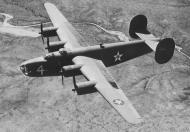
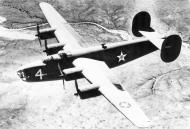
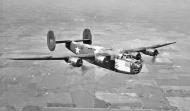
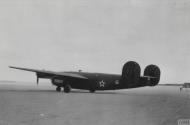










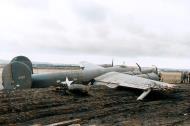





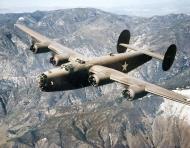








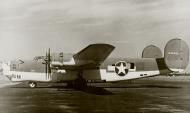


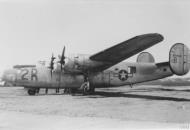
















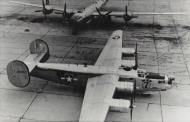




-modifications-at-the-Consolidated-Vultee-Plant-Fort-Worth-Texas-01.jpg)








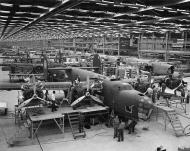




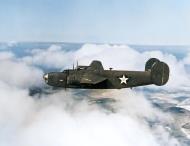


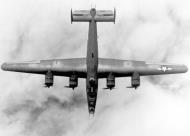
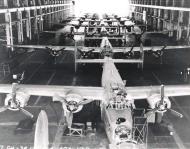




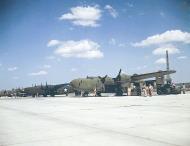


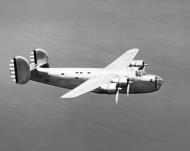
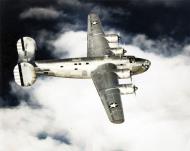

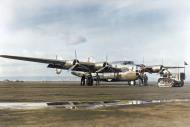



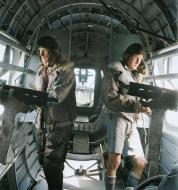







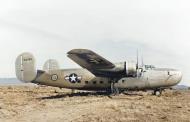

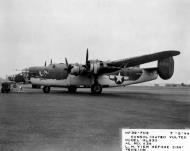
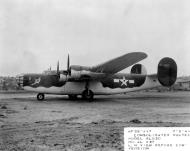









-between-the-major-Allies-of-WWII-took-place-from-12th-to-17th-Aug-1942-01.jpg)
-Eloise-Huffines-Bailey,-Millie-Davidson-Dalrymple,-Elizabeth-McKethan-Magid-and-Clara-Jo-Marsh-Stember.jpg)
